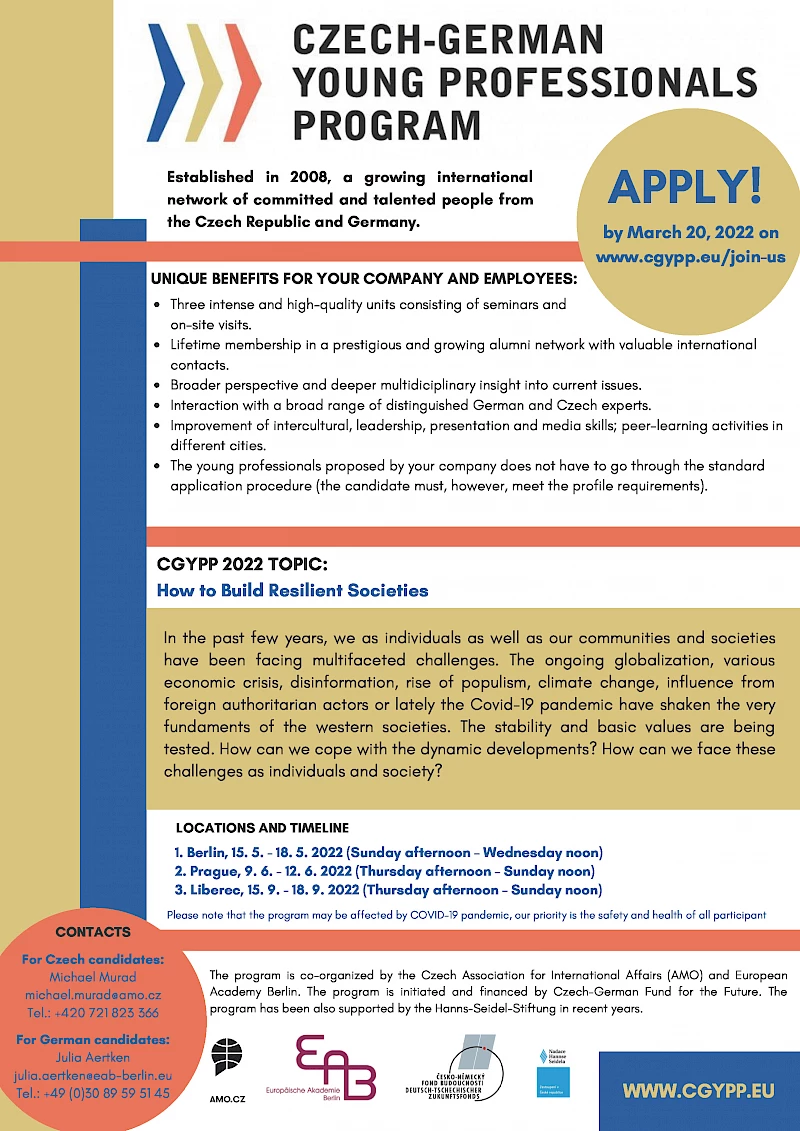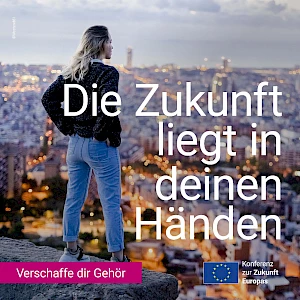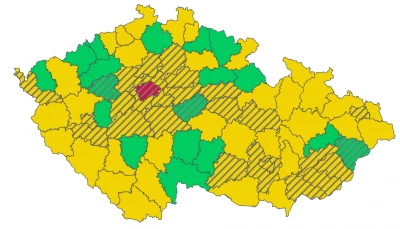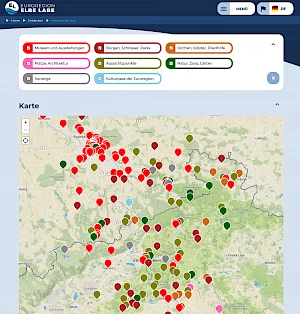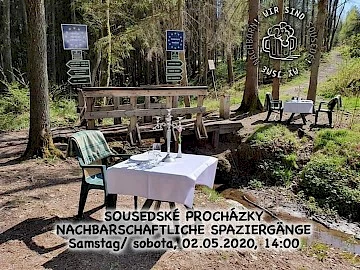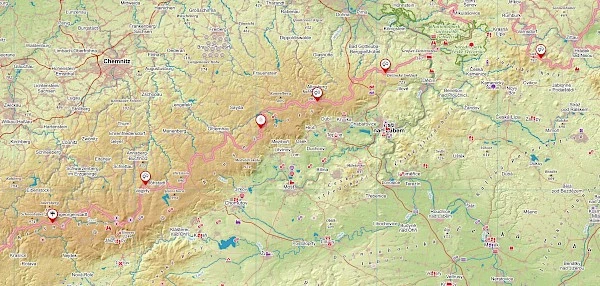News
April 2024
Roma memorial Lety opens
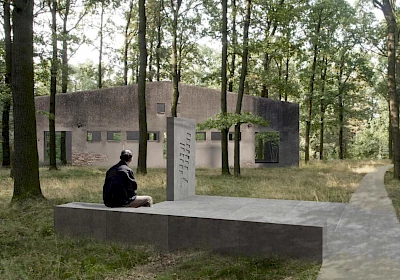
A memorial to the Porajmos, the genocide of the Roma under National Socialism, was opened in Lety in southern Bohemia. Both President Petr Pavel and Prime Minister Petr Fiala spoke at the inauguration ceremony. The memorial, which will be open to the public from May 12, commemorates a concentration camp that was set up here for Roma from the Czech Republic during the years of National Socialist occupation. A labor camp primarily for Roma had previously stood on the same site.
After 1945, the place was forgotten, and later a pig farm was built. Since the Velvet Revolution, there have been efforts - also encouraged by the then President Václav Havel - to set up a reverent place of remembrance. But the respective governments refused to close the pig farm. For a long time, the government did not want to acknowledge that the Roma had been genocide, let alone that it was its own fault. This lack of interest was also due to the fact that Roma in the Czech Republic still have only a small lobby and are largely socially excluded.
It was not until 2018 that the state agreed to buy the pig farm. In 2022, the demolition was completed and construction of the memorial could begin. It is affiliated with the Museum of Roma Culture in Brno.
1,308 Roma, both old and children, men and women, were held in the camp between August 1942 and May 1943, 327 died and over 500 were murdered in concentration camps. In Hodonín u Kunštátu in Moravia there was a second camp that served as a holiday camp after 1945. A small memorial had already been set up there. You can find out more about the history of the camp in Lety at www.holocaust.cz .
New location for Czech lithium production
The lithium in the Ore Mountains has also created a gold rush atmosphere in the Czech Republic. The raw material is to be mined in the old mining town of Cínovec. The Czech Republic hopes that this will give it independence from the world market in this important area and enable it to move into the technological forefront. But not much has happened for years. The Geomet company was taken over by the majority state-owned energy company ČEZ. But mining is still a long way off.
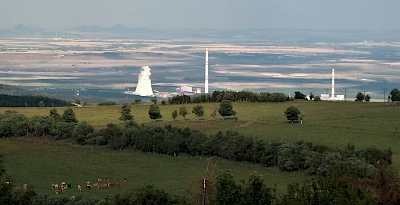
Now Geomet has even had to accept a setback. Due to protests from local residents, the company gave up the desired location for the lithium processing plant in the town of Újezdeček, south of Dubí, and decided to build the plant in Prunéřov, west of Chomutov.
Residents had been protesting against the plant in Újezdeček for two years. The residents of the small settlement of Dukla in particular were afraid of the plant, which would have bordered on their property. For two years they fought a David versus Goliath battle. Geomet always claimed that Újezdeček was the best location. Criticism from district administrator Jan Schiller was certainly crucial to the success of the protest. Other regional and local politicians also sided with the residents. Geomet was repeatedly criticized for its information policy.
Now the residents of the Dukla settlement can celebrate. Geomet now wants to transport the mined lithium to Prunéřov by train. Újezdeček is only planned as a transfer point for the ore to the railway. There is a ČEZ coal-fired power plant in Prunéřov. Geomet wants to locate both the mechanical and chemical processing of lithium there. Up to 60 lithium trains per week are planned from Újezdeček to Prunéřov.
When lithium mining will begin in the Czech Ore Mountains is still up in the air. A feasibility study, which was supposed to be available at the end of 2023, has not yet been completed. The only thing that is certain is that mining will take place underground. The transport of the ore from the shaft to the transshipment point in Újezdeček is also still an open question. Most recently, two options were considered: a transport lift or a conveyor belt. Geomet plans to mine over 2 million tons of ore per year, which will be processed into around 25,000 tons of lithium.
Žatec wins another title
A year ago, the hop town of Žatec was left empty-handed. Then, on September 18, it was added to the UNESCO World Heritage List. Exactly seven months later, Žatec was also named a "Historic Town of the Czech Republic." The town was thus recognized for its long-term, successful renovation of the historic town center and individual buildings. The jury particularly emphasized that, in addition to using state funding, the town also succeeds in motivating private homeowners to carry out renovations in accordance with the monument's preservation requirements.
Žatec won the coveted title at the eighth attempt. The winners in each district always make it to the final. Žatec won the Ústí district for the eighth time in a row in 2023. The nationwide winner will receive 1 million crowns (40,000 euros) for monument preservation.
New Elbe bridges for pedestrians and cyclists
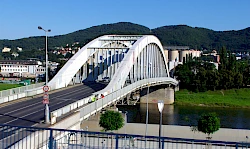
Construction of a new bridge for pedestrians and cyclists has begun in Ústí. The new Elbe crossing is being built downstream of the Beneš Bridge. It is a temporary solution for the period of the renovation of the Beneš Bridge. The temporary solution is to be three meters wide and to be completed by next winter. All supply lines that currently run over the Beneš Bridge will also be diverted over the temporary bridge. The long-overdue renovation of the Beneš Bridge is to be completed in October 2026.
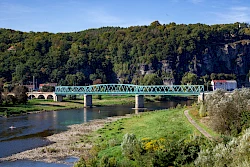
A bridge for pedestrians and cyclists is also being built in Děčín. It will be built onto the railway bridge. Unlike the one in Ústí, however, it will not be a temporary bridge, but will make it easier for pedestrians and cyclists to cross. In future, this will also make crossing the Elbe easier for all those who are using the Elbe cycle path. Until now, they had to take the inconvenient route over the Tyrš Bridge.
 The production of this newsletter is co-financed by tax revenue on the basis of the budget approved by the Saxon State Parliament.
The production of this newsletter is co-financed by tax revenue on the basis of the budget approved by the Saxon State Parliament.
(This is an automatic translation by Google Translator.)
School year 1945/1946: The students in a boys' class are so undisciplined that they send their teacher to the madhouse. Then a new teacher takes over and fascinates the boys: on the one hand, military uniform and caning with the cane, on the other hand, he makes the tough boys cry with his violin playing to the story of Jan Hus and amazes them with his stories from the various war fronts. If it weren't for his uncontrollable passion for women...
This film by father and son Svěrák is probably a classic example of the Czech film that many people in Germany love: lovingly drawn characters in a rather rural setting who experience different, more or less everyday stories, and all of this is staged without any great sensationalism. The background is an important time in Czech history, which was certainly anything but easy, but here it is given a conciliatory sepia tone. The film is one of the most popular films of all time in the Czech Republic and is number 6 on the list at csfd.cz.
For Jan Svěrák, this was his first feature film as a director; his father Zdeněk Svěrák wrote the screenplay and acted in it. The film was nominated for the 1992 Oscar for Best Foreign Language Film.
(This is an automatic translation by Google Translator.)
100 years of the Ore Mountain Theatre Teplice
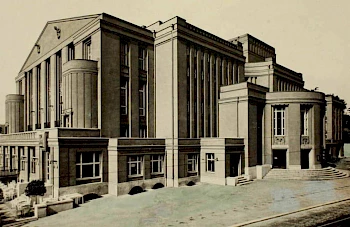
The spa town of Teplice is celebrating the 100th anniversary of the Ore Mountains Theatre (Krušnohorské divadlo). The monumental building on the edge of the spa park was ceremoniously opened as the "Teplitz-Schönau Municipal Theatre" on April 20, 1924. At the time, it was the largest theatre building outside of Prague. It was built in just under two years on the site of the previous building. It was destroyed in a fire in 1919. The current building is a Dresden co-production. The architectural competition was won by the Dresden architect with Bohemian roots, Rudolf Bitzan. He is known for the crematorium in Liberec (Reichenberg), designed the town hall in Freital-Döhlen and was also involved in the design for Leipzig Central Station. The interiors were designed by the Dresden artists Richard Guhr and Alexander Baranowsky.
Programs from the 1920s show a lively cultural life. The theater had three sections: opera, operetta and drama. Performances were performed at least once a day, sometimes several times. In addition to the large hall with over 700 seats, the theater had a small hall with 500 seats, a restaurant, a café and a cinema, as well as several other salons for dance events, for example. Due to the German-speaking majority of the population, performances were usually performed in German. At least once a month there was a Czech-language event. Many actors of Jewish descent also performed at the theater. Despite growing pressure from the fascist-minded Sudeten German Party, the directors managed to keep the Jewish actors, who made up about a third of the ensemble, until the Wehrmacht invaded the Sudetenland in 1938. In 1938 the theater not only lost its Jewish actors, but also some Germans quit their jobs. After 1945, the ethnic German population had to leave the country.
Today the theatre is run by the town of Teplice, which subsidises all venues under the roof of the cultural centre with 2 million euros every year. In addition to the modern cultural centre itself, this includes the Ore Mountains Theatre and, among others, the Zahradní dům (Garden House) near the castle. Today the theatre mainly hosts external productions, but cultural centre director Přemysl Šoba has announced four of his own premieres for the first time this year, partly supported by musicians from the Teplice Conservatory. As the cultural centre is currently being renovated, the Ore Mountains Theatre is also the venue for the North Bohemian Philharmonic this year. The Beethoven Festival in early summer will also take place in the Ore Mountains Theatre.
Interest in the European Union is increasing in the Czech Republic
On June 9, the people of the European Union will elect a new parliament. A Eurobarometer survey conducted in the Czech Republic in February suggests that voter turnout will be higher this time. According to the survey, 38 percent of eligible voters will go and vote. That may not be much for other countries. But in the Czech Republic, where turnout in EU elections has always been among the lowest, that would be a new record.
Interest in the European elections was already rising again before the last elections, after voter turnout had fallen to a historic low of 18.2 percent in 2014. After the Czech Republic joined the European Union on May 1 with nine other countries in Central and Eastern Europe and Southern Europe, voter turnout had always been just over 28 percent. In 2019, it returned to this level and even reached a new high of almost 29 percent.
When asked about priorities for the European elections, the Czech Republic's priorities are defense and security (45 percent), independence in energy supply and industrial production (40 percent) and the future of Europe (35 percent). This differs in some ways from the overall picture of all 27 EU states, where only defense and security are higher in priority. The issue of migration and asylum is also given greater weight in the Czech Republic (33 percent) than in the EU as a whole (24 percent).
There are more similarities in the values that the EU Parliament is to defend over the next five years. Peace and democracy are at the forefront here. While the Czech Republic places a little more emphasis on solidarity between EU states and regions and respect for national identities, cultures and traditions, the EU as a whole places greater emphasis on the protection of human rights and the rule of law.
When asked what the EU should focus on to strengthen its influence in the world, however, the picture is again mixed. Defence and security, as well as independence in the supply of energy and raw materials and infrastructure, are top priorities. In the Czech Republic, however, the emphasis is on strengthening the competitiveness of the economy and industry (40 percent/EU27: 27 percent). In contrast, the EU27 rate food supply and agriculture higher at 30 percent than Czech respondents (23 percent).
High-speed rail line: decision in June
While the route of the new high-speed rail line from Dresden to Prague has been clarified on the German side, the decision on the Czech side is still pending. The ball is currently in the Ústí district's court. The district office is evaluating over 600 statements. In particular, the section south of the Bohemian Central Mountains, through which the high-speed rail line is to be run via a tunnel, has still not been decided between three options. The exit of the Ore Mountains Base Tunnel on the Czech side is still controversial. But the railway infrastructure administration Správa železnic is pushing for a decision. "June is our big wish. Otherwise everything will be delayed - not just the Ore Mountains Tunnel, but also the Prague-Lovosice section, which is to be built first," says Pavel Hruška, head of planning at Správa železnic.
The district office is expected to have processed all 600 statements by June. After that, the members of the district parliament will have the final say. If no decision is reached, the Ministry of Transport wants to take over the process and force a decision. This will enable it to revise the building law. District administrator Jan Schiller (ANO) is opposed to such a course of action: "We have already struggled so intensively with all the affected communities. It would all have been in vain," said the district administrator. He is still hoping to find a compromise.
Whooping cough wave in Northern Bohemia
In recent weeks, there has been an increase in whooping cough cases in northern Bohemia. Last week, the Ústí District Hygiene Station reported an increase of 130 new cases. Most of them were registered in the Děčín District (27). The disease is also increasingly appearing in the Chomutov (25 cases) and Ústí (24 cases) districts. The prevalence in the district remains unchanged at 16 cases per 100,000 inhabitants. The disease is most prevalent in the 15-19 age group, with almost 92 cases per 100,000 inhabitants.
 The production of this newsletter is co-financed by tax revenue on the basis of the budget approved by the Saxon State Parliament.
The production of this newsletter is co-financed by tax revenue on the basis of the budget approved by the Saxon State Parliament.
(This is an automatic translation by Google Translator.)
Overcoming language barriers is the most important and at the same time the most difficult task for all Saxon-Czech border regions. Immersing children in the neighboring language at an early stage is a special opportunity for the entire border region.
We have accepted this challenge as a project team of the INTERREG project “Neighbouring language from the beginning - Jazyk sousedů od začátku!” All Saxon-Czech Euroregions, the Saxon State Office for Neighbouring Language Education (LaNa) and TANDEM Pilsen Coordination Office for German-Czech Youth Exchange form a great team and were able to start the ambitious project in January 2024. We would like to design and implement the project together with you.
MONDAY AND AFTERNOON 29.04.2024
10 AM I 10 PM
Location: Library of the Ústí Region, Winston Churcilla 3, 400 01 Ústí nad Labem
Event language(s): German and Czech
 The project "Neighbouring language from the start" is funded with EU funds from the Saxony-Czech Republic cooperation programme 2021-2027.
The project "Neighbouring language from the start" is funded with EU funds from the Saxony-Czech Republic cooperation programme 2021-2027.
(This is an automatic translation by Google Translator.)
Funding for eight projects in the Elbe/Labe Euroregion approved
The Elbe/Labe Euroregion manages a small project fund filled with EU funds to support German-Czech projects. At today's meeting of the local steering committee in Děčín, eight project applications with a total funding volume of 69,236.80 euros were approved. These include, for example, holiday camps, sports games, joint excursions or cooperation between dog sports clubs. The applicants came from Sebnitz, Dolní Poustevna, Bad Gottleuba, Tisá, Teplice, Bannewitz, Krásná Lípa, Obercunnersdorf, Bärenstein, Česká Kamenice and Dresden.
You can find out more about the funding opportunities offered by the Small Projects Fund at www.elbelabe.eu/kpf . We would be delighted to receive many good project proposals. Please spread the word!
To the list of approved projects
Ústí District modernizes Rumburk Hospital
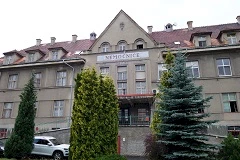
Five years ago, the hospital in Rumburk was still a nursing case. Insolvent and threatened with closure. Some departments were closed, there was not only a lack of money, but also of staff. In between there was the takeover by the hospital holding company of the Ústí district and the Covid pandemic, during which the hospital regained importance. Especially since the borders were temporarily closed and patients could no longer be cared for by Saxon clinics as once planned.
The situation for the hospital has now improved. In the coming years, the district will invest heavily again. The equivalent of 37.5 million euros is planned. The money will be used to renovate the polyclinic, i.e. the medical care center. A completely new emergency room will be built and the hospital will finally have its own helipad. The majority of the investments should be completed by 2027. The renovation of the main building will take a little longer.
The hospital, which cares for 50,000 people in the Schluchsee area, was due to be closed years ago. At the same time, negotiations were underway with facilities in neighboring Saxony that were waiting for patients from the Czech Republic. But the plan failed due to lack of funding.
Děčín acquires electric buses
Public transport in Děčín will change in the next few years. This will be achieved by purchasing new electric buses for the city lines. The city has already started a bidding process to purchase 20 electric buses. The first ten buses are expected to be delivered next year. The city will only pay a fraction of the price. The majority will be covered by subsidies from the European Union.
Děčín has been testing electric buses from various manufacturers for three years now. The decisive factor was whether the buses could also handle the mountainous terrain of the Elbe city. The result was positive. The transport company is only expecting one additional quick charge during the day.
Which company ultimately supplies the buses depends solely on the lowest price bid. The city also demands a guarantee for the batteries for the full 12-year lifespan.
In order to reduce emissions, Děčín has already purchased 21 natural gas-powered buses, whose operating costs rose sharply following the price increases after Corona and Russia's war against Ukraine. Děčín also has diesel buses in its fleet.
Unemployment highest in Northern Bohemia
Ústí nL Unemployment in the Ústí region remains the highest in the Czech Republic. In March, the employment offices reported an unemployment rate of six percent. That was two percentage points higher than the national average. However, the rate remained unchanged from February. 33,643 people were registered as unemployed compared to almost 11,000 vacancies.
The affair surrounding Bystron and the Czech newspaper Deník N
AfD politician Petr Bystron has been in the headlines for almost three weeks. He is said to have accepted money from the Russian propaganda portal Voice of Europe. Bystron denies this and the party executive of the Alternative for Germany has expressed its trust in him. But the longer the affair lasts and the more details and new findings become known, the more the politician becomes a burden for the AfD. After all, he is second on the list of candidates for the European elections in June. The name of the Czech newspaper Deník N is always mentioned in connection with Bystron. It was at the beginning and first made the allegations public.
This is no coincidence. After all, Bystron is a politician with Czech roots. Born in Olomouc in 1972, his family emigrated to Germany at the end of the 1980s. For several years now, he has had a meteoric rise in the AfD. Nevertheless, Czech media continue to write the politician's name in Czech. That means Petr remains Petr, but his surname is Bystroˇň, with a soft N at the end. His origins explain the great interest of the media in the Czech Republic in him. However, Czech media have very good sources, especially when it comes to researching Russian influence. Long before Russia's attack on Ukraine, the Czech secret service warned of the threat from Russia and its growing influence not only in the Czech Republic, but also in other parts of Europe. Czech journalists are also among the most active in Europe, researching Russian influence in networks with colleagues from other EU countries. It was no coincidence that a Europe-wide network designed to investigate Russian fake news was headed by a Czech journalist years ago.
Added to this is the long-standing investigative tradition and the growing media landscape in the Czech Republic, which has even grown in the last ten years. Deník N is the best example of this. The daily newspaper was founded when newspapers were closing elsewhere. It originated in Slovakia, where it quickly found readers and subscribers. It was so successful that after years it founded a branch in the Czech Republic. This is what has now set the Bystron affair in motion.
 The production of this newsletter is co-financed by tax revenue on the basis of the budget approved by the Saxon State Parliament.
The production of this newsletter is co-financed by tax revenue on the basis of the budget approved by the Saxon State Parliament.
(This is an automatic translation by Google Translator.)
The Elbe/Labe Euroregion manages a small project fund filled with EU funds to support German-Czech projects. At today's meeting of the Local Steering Committee, eight project applications with a total funding volume of EUR 69,236.80 were approved.
Česká Kamenice has an astronomical clock again
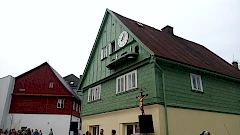
No visit to Prague is complete without a visit to the famous astronomical clock on the Old Town Square. Every hour on the hour, a huge crowd of people gathers to watch the spectacle of the apostles. A similar crowd formed on Easter Sunday in Česká Kamenice on Nerudova Street, which connects the main square with the pilgrimage church of the Virgin Mary. An astronomical clock was put into operation there. The 12 apostles can also be seen here. Two bell ringers, a skeleton and a knight complete the ensemble.
The astronomical clock was once built by a clockmaker to boost his business. But after 1945 he lost his business. What became of the clock is not known. But the place where the clock was once installed was still visible. The house on Nerudova has since been renovated and last year the town decided to install an astronomical clock again. Almost half of the money was raised through a fundraiser. The figures were made by the glass school in neighboring Kamenický Šenov.
Construction starts on the Eger cycle path
People have been talking about it for over ten years. The cycle path along the Ohře river, which has its source in Bavaria and is called the Eger there, and flows into the Elbe near Litoměřice. It is already signposted and quite a few people are already using it for cycling tours. But so far it has led along roads or forest and field paths. Some of the roads are very busy, and the forest and field paths are not always of a quality suitable for bicycles. Now the path is to have its own, mostly asphalted route. The Ústí District, as the developer, is already looking for companies to build the first sections. The first section is 3.8 kilometers long and is located between the towns of Litoměřice and Libochovice. The second section is five kilometers long and covers the stretch between Žatec and Kadaň. A total of 20 sections of cycle path are being built between the Ohře estuary and the border with the Karlovy Vary District.
German-language tours at Ústí Zoo
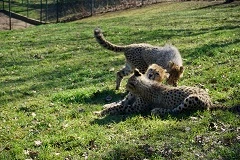
The zoo in Ústí nad Labem is particularly worthwhile right now. You have the unique opportunity to observe four cheetah cubs. The quadruplets are no longer very small, but at just over seven months old they are still very playful. Along with two others, they are the only cheetah cubs in Europe this year.
It is now possible to combine a visit to the zoo with an expert guided tour, even in German. The German volunteer Amelie Konzelmann has been working at the zoo since the autumn. She was introduced to the zoo by the Paritätische in Dresden, which has been active in German-Czech volunteer exchanges for years. Amelie Konzelmann did not acquire her knowledge of the zoo animals in Ústí, but came to the city on the Elbe with prior knowledge. The tours start this weekend at 10 a.m. and 1 p.m. Historical tours or night tours are also possible. Advance registration is required. All information, including contact details, can be found on the German version of the zoo's website. Tickets for the tour are available at the ticket office. Konzelmann also offers exciting educational programs for school classes on various topics such as "The food chain," "Behavioral biology" or "Illegal animal trade." They are designed for different age groups. More information can also be found on the website .
Day without haste
Take it easy for a day. The Czech Republic allows itself this once a year. On Wednesday, the day came. Everyone in the Czech Republic was called upon to slow down. This day was initiated by the Czech Insurance Association. The reason was the number of road deaths, which are often caused by excessive speed or inattentiveness resulting from haste. The day is therefore intended to remind people to stick to the speed limits on the roads and to drive stress-free.
But the day of no rush was not only about traffic. In Opava, the semi-final cup match between hosts Opava and favorites Sparta Prague began a few minutes later to mark the day. Theater performances also started later. Even the puppet show of the famous astronomical clock at Prague City Hall was stopped for a few minutes at 10 a.m. Instead, death rang the bell 138 times - once for every victim who died in traffic last year due to excessive speed.
 The production of this newsletter is co-financed by tax revenue on the basis of the budget approved by the Saxon State Parliament.
The production of this newsletter is co-financed by tax revenue on the basis of the budget approved by the Saxon State Parliament.
(This is an automatic translation by Google Translator.)
March 2024
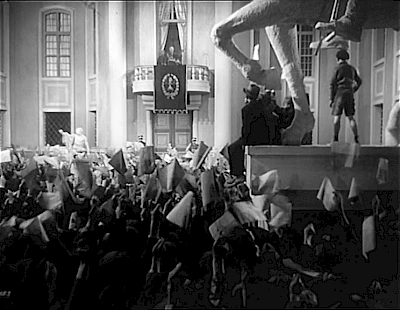
April begins on Easter Monday, which means that Wednesday is another Czech Film Wednesday. This time we are showing “Bílá nemoc” (The White Disease) from 1937.
This will be the oldest film so far at Czech Film Wednesday. The 1930s in Czechoslovakia were characterized by relatively shallow comedies, which is why suitable films from this decade are rare. “Bílá nemoc” stands out, which is certainly due to the original by the famous Karel Čapek.
About the content: A mysterious illness is raging in a totalitarian state where a strict marshal rules and threatens neighboring states with war. The marshal is supported by the arms magnate Baron Krog, and the propaganda minister is constantly preparing the population for war. Young people in particular, who are searching in vain for work, fanatically support the marshal and believe that a victorious war is the only way out of the gloomy situation.
Dr. Galén, a slum doctor, has found a cure for the white disease, but he does not want to give the formula to any government until it gives up weapons and commits to lasting world peace. He covers poor people in the suburbs and rich people seeking peace. He refuses to treat the infected Krog unless the conditions are met. The marshal rejects this. Instead, he starts war against the neighboring country. The crowds cheer, but things turn out differently than you might expect...
The film clearly takes up developments in neighboring Germany since 1933, which is also heading towards war. Czechoslovakia becomes the first victim of Hitler's war ambitions in 1938, just one year after the film, through the Munich Agreement and in 1939 through the final occupation. This makes the film also an important contemporary document.
More about the film and tickets
(This is an automatic translation by Google Translator.)
The Czech Republic celebrates Easter with a giant Easter egg
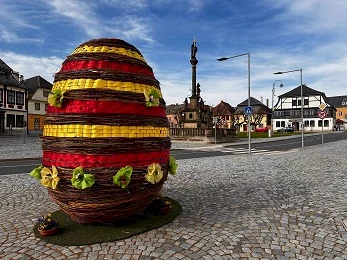
Easter is not only just around the corner, but in Jablonné v Podještědí, Czech Republic, it is a huge Easter egg in the middle of the main square. Only six kilometers from the border with Saxony, it has become a tourist attraction in recent days. Photos with the egg are eagerly shared on social networks. “The egg was made by eager craftsmen in the Heřmanice district in 80 hours of after-work work,” says Mayor Jiří Rýdl. It is around three meters high and is probably the largest egg around. It consists of a steel wire mesh through which willow branches and colored fabric panels have been woven. “We had already set it up last year, but only as a pure wire mesh. So the decorated Easter egg is a first,” the mayor continued. It can still be admired at least until Easter Monday. “We will definitely not take it down again on Tuesday, but will leave it there for a few days after Easter,” says Rýdl, given the great interest.
The Easter egg also has a tradition that is still alive today in the Czech Republic. It is considered a symbol of fertility. Colorfully decorated in many variations, it was traditionally presented on Easter Monday by women to men as they moved from house to house.
Railway lines are coming back to life
The tourist railway lines start the new season in the neighboring country on Good Friday. This also applies to train routes that are closed during the rest of the year. This applies, for example, to the popularly known Goat Railway from Děčín to Telnice, the Opárno Express from Litoměřice to Chotiměř in the Bohemian Central Mountains or the route from Ústí-Střekov to Zubrnice, which is also known as a museum village. The trains run on weekends and public holidays and the Elbe-Labe ticket is valid. Historic trains are used on most routes. The Elbe-Labe ticket is also valid on the tourist boat lines T91 to T93 on the Elbe from Ústí to Litoměřice or Hřensko. Timetables and other routes for the lines marked with a “T” can be found on the Ústí district website . Although the site is only in Czech, it is possible to navigate on the left via " Železniční linky " (rail lines) and " Lodní linky a přívozy " (ship lines and ferries).
Easter riding in Mikulášovice
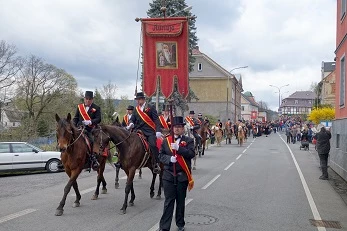
On Easter Sunday the Easter riders are also out and about among our Czech neighbors. The custom, which has been practiced again in Mikulášovice for several years, is originally a tradition of the German minority that still lives there. The procession with the horses starts immediately after Holy Mass, which begins at 10 a.m. in the Church of St. Nicholas.
NGOs criticize housing situation in Prague
Several Czech non-governmental organizations (NGOs) have published the results of a study that rates the housing situation in Prague as the worst in Europe. Nowhere else is accommodation as unaffordable as in the Czech capital, the study says. The NGOs are calling for municipal housing construction, which currently does not exist in Prague, as well as the regulation of rents.
The results of the study, which follows a comparable study in 2018, correspond to the assessment of economist Martin Červinka in the daily newspaper Hospodářské noviny. He points to the increasing purchase prices for private living space and the limited supply, which is further increasing prices. Housing construction had also come to a standstill in the Czech Republic due to skyrocketing construction prices. In addition, the Czech central bank had raised key interest rates significantly more than the European Central Bank, which increased costs for home buyers and also dampened the provision of new living space. The central bank has now made its first interest rate cut. But housing construction has not yet started again. Rents also remain at a high level.
Červinka points to data from the statistics office that Prague has grown by 100,000 residents in the last two years. Cell phone data suggests the number of residents is even higher than the official 1.38 million. The main reason behind this is the influx of Ukrainian refugees in recent years. At the same time, Červinka also viewed the situation positively. It is remarkable how the housing market has accommodated the influx of so many people in such a short time.
 The creation of this newsletter is co-financed by tax revenue based on the budget approved by the Saxon state parliament.
The creation of this newsletter is co-financed by tax revenue based on the budget approved by the Saxon state parliament.
(This is an automatic translation by Google Translator.)
Präsident Petr Pavel zu Besuch in Dresden
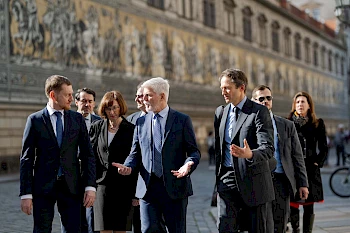
Am 15. März weilte der tschechische Präsident Petr Pavel in Dresden. Anlass war die Eröffnung der Ausstellung "Fragmente der Erinnerung" der Staatlichen Kunstsammlungen gemeinsam mit dem sächsischen Ministerpräsidenten Michael Kretschmer im Lipsius-Bau. Diesen traf Präsident Pavel zuvor zu Gesprächen über die sächsisch-tschechischen Beziehungen und die wirtschaftliche und kulturelle Zusammenarbeit (sicher auch über unsere Tschechisch-Deutschen Kulturtage). Abschließend stand ein Besuch im Dresdner Werk des Halbleiterherstellers GlobalFoundries auf dem Programm.
Ausstellung des Reliquienschatzes des Prager Veitsdoms im Lipsiusbau
Am 15. März wurde im Dresdner Lipsiusbau an der Brühlschen Terrasse die Ausstellung "Fragmente der Erinnerung" eröffnet (siehe oben), die bis zum 8. September zu sehen sein wird.
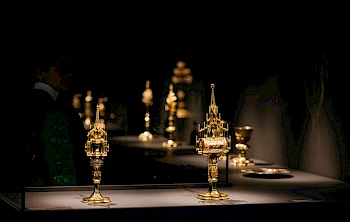
Im Zentrum steht der über Jahrhunderte gewachsene Reliquienschatz des Prager Veitsdoms – eine der bedeutsamsten Sammlungen von Belegstücken des christlichen Glaubens – der als heilig und wunderwirkend verehrt wurde. Die Ausstellung präsentiert diesen Schatz anhand 125 mittelalterlicher und frühneuzeitlicher Stücke zum ersten Mal in seiner Geschichte außerhalb seines ursprünglichen Bestimmungsortes.
Darüber hinaus eröffnen drei zeitgenössische Künstler zusätzliche Perspektiven auf das Thema des zivilisatorischen Gedächtnisses. Edmund de Waal regt mit keramischen Werken zur Reflexion über Geschichte an, die teilweise nur noch aus fragmentarischen Erinnerungen besteht. Josef Koudelka zeigt mit großformatigen Fotografien der Mauer zwischen Israel und der palästinensischen Westbank, wie diese Landschaft zerschnitten wird, in der die drei großen monotheistischen Weltreligionen ihre Wurzeln und sakralen Stätten haben. Der Film „In the Land of Drought“ von Julian Rosefeldt verwendet verlassene Filmkulissen, um Erinnerungen an die biblische Vorgeschichte und die Geschichte der Menschheit, vor allem im Nahen Osten und in Nordafrika, wachzurufen. Außerdem wendet sich der Film den realen Spuren der industriellen Vergangenheit Mitteleuropas mit großen Kratern und verlassenen Industriemaschinen zu, die heute zerstörte Landschaften prägen.
Ústí verabschiedet legendäre Škoda-Obusse
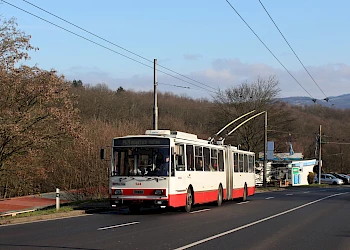
Das Straßennetz von Ústí nad Labem ist künftig um eine Attraktion ärmer, zumindest aus Sicht vieler Obusfreunde: Diese Woche verabschiedete der städtische Verkehrsbetrieb DPmÚL die legendären Škoda-Oberleitungsbusse vom Typ 15Tr. Die durch ihr eckiges Äußeres markanten Fahrzeuge fuhren seit Januar 1989 in der Stadt und wurden nun durch moderne, ebenfalls von Škoda/Solaris stammende Neufahrzeuge ersetzt. Diese verfügen zusätzlich über Hilfsantriebe auf Batteriebasis und ermöglichen daher, auch Linienabschnitte ohne Oberleitung zu befahren. Die letzten regulären Einsätze des Škoda 15Tr fanden bereits Ende Februar statt, doch diese Woche – also bis morgen! – fahren zwei bis zum Schluss aktive Exemplare noch ein letztes Mal im Rahmen einer Abschiedswoche auf verschiedenen Linien. Am Sonntag gibt es eine offizielle Abschiedsrundfahrt durch die Stadt, die jedoch bereits zwei Tage nach ihrer Veröffentlichung ausverkauft war. Das zeigt die Beliebtheit der kantigen Oldies.
Zwischen 1988 und 2004 wurden im Škoda-Werk in Ostrov nad Ohří knapp 500 Exemplare des 15Tr für zahlreiche Staaten des einstigen Ostblocks gefertigt. In Ústí fuhr mit insgesamt 77 Fahrzeugen die weltweit größte Flotte dieses Typs. Obusse verkehren in Ústí nad Labem seit 1988 und sind heute fester Bestandteil des lokalen ökologischen Verkehrskonzepts. Das Netz wurde in den 1990er und frühen 2000er Jahren erheblich erweitert. Die Topografie der Stadt mit ihren in Höhenlagen errichteten Neubaugebieten bietet optimale Voraussetzungen für die Nutzung dieses Verkehrsmittels.
Filmfestival »Jeden svět« gestartet
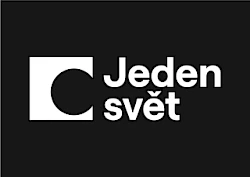 Am Mittwoch wurde in Prag das Menschenrechts-Filmfestival »Jeden svět« (Eine Welt) eröffnet. Das Festival wurde 1999 ins Leben gerufen und ist fester Bestandteil der Arbeit der international tätigen Hilfsorganisation "Člověk v tísni" (Mensch in Not). Heute ist das Festival das größte seiner Art weltweit.
Am Mittwoch wurde in Prag das Menschenrechts-Filmfestival »Jeden svět« (Eine Welt) eröffnet. Das Festival wurde 1999 ins Leben gerufen und ist fester Bestandteil der Arbeit der international tätigen Hilfsorganisation "Člověk v tísni" (Mensch in Not). Heute ist das Festival das größte seiner Art weltweit.
Präsentiert werden Dokumentarfilme über Menschenrechte aus aller Welt. Jedes Jahr kommen nicht nur Filmemacher aus verschiedenen Ländern der Welt dorthin, sondern auch Protagonisten und Verteidiger der Menschenrechte. Gespräche mit ihnen sind eine der Säulen des Programms.
Das Festival findet nicht nur in Prag statt, sondern in diesem Jahr in 47 weiteren Städten in ganz Tschechien. In unserer Region werden Filme in Ústí nad Labem (bis zum 23. März bei unseren Freunden vom Hraničář) und vom 10. bis 13. April in Děčín gezeigt.
Mehr Zugverbindungen nach Prag
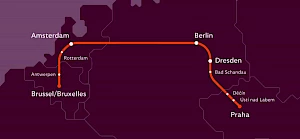
Ab dem 26. März startet das Unternehmen European Sleeper eine neue Nachtzugverbindung zwischen Prag und Brüssel. Diese verkehrt allerdings nicht täglich, sondern nur dreimal pro Woche. Für die Strecke Dresden-Prag wird wohl niemand einen Liegewagen buchen, aber der Zug bietet auch Sitzplätze. Von Prag startet der Zug 18.04 Uhr, so dass an bestimmten Tagen zwischen 17.30 und 18.30 Uhr gleich drei Züge nach Dresden fahren. Später am Abend sieht es aber erstmal weiter mau aus. In der Gegenrichtung fährt der Zug um 8.31 Uhr ab Dresden Hbf.
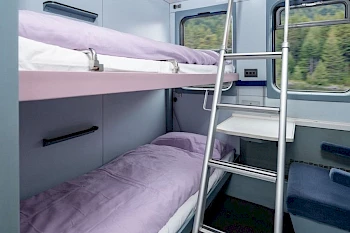
Vom 11. Juni bis 15. September wird ein zusätzlicher Eurocity mit Abfahrt in Prag um 20.28 Uhr eingesetzt, der eine späte Fahrt ermöglicht. Wichtig für alle Fans: Dieser EC soll einen bewirtschafteten Speisewagen haben. Umgekehrt kann man bereits sehr früh, um 3 Uhr, nach Prag fahren.
Die Einschränkungen durch die Bauarbeiten im Elbtal werden geringer, so dass bereits seit Mittwoch der Railjet zwischen Dresden und Graz über Prag, Brno und Wien wieder verkehrt, der im Dezember vorübergehend eingestellt werden musste. Außerdem entfällt ab nächster Woche der gelegentliche Schienenersatzverkehr für den Eurocity zwischen Ústí nad Labem und Dresden.
Sanierte Synagoge in Žatec eröffnet
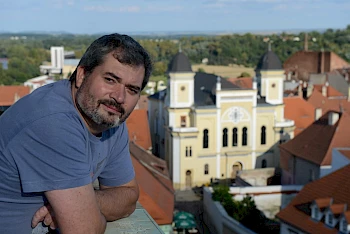
Am Dienstag wurde die frisch sanierte Synagoge in Žatec im Beisein des tschechischen Kulturministers Martin Baxa feierlich eröffnet. Das Besondere ist dabei nicht nur, dass sie das zweitgrößte jüdische Baudenkmal in Tschechien darstellt (nach der Großen Synagoge in Plzeň), sondern auch, dass die Sanierung komplett von einem Privateigentümer durchgeführt wurde. Der Unternehmer und frühere Oberbürgermeister von Chomutov Daniel Černý hatte die Synagoge 2012 in einer öffentlichen Auktion für rund 1,5 Mio. Euro erworben und sie dann für nochmal rund 2,2 Mio. Euro saniert. Dafür nutzte er vor allem EU-Fördermittel. In der Synagoge werden nun wieder Gottesdienste stattfinden, während im benachbarten Rabbinerhaus ein Museum eingerichtet wurde.
Es gibt eine eigene Website zur Synagoge, auf der man viele historische Fotos findet, die u.a. auch den beklagenswerten Zustand vor der Sanierung zeigen.
Tschechische Literatur in Leipzig
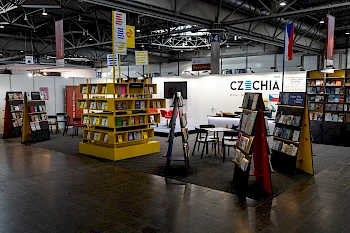
Gestern wurde in Leipzig die diesjährige Buchmesse eröffnet. Tschechien ist dort wieder mit einem Stand des Tschechischen Literaturzentrums (České literární centrum, CzechLit) vertreten. Noch bis Sonntag können Sie sich dort informieren, welche aktuellen tschechischen Werke auf Deutsch erschienen sind. Außerdem finden mehrere Lesungen tschechischer Autorinnen und Autoren im Rahmen der Reihe "Echo Tschechien" statt.
Zum Programm von Echo Tschechien
Wenn Sie unseren Wochenrückblick regelmäßig in Ihr Email-Postfach bekommen möchten, melden Sie sich für unseren Newsletter an.
 Die Erstellung dieses Newsletters wird mitfinanziert durch Steuermittel auf der Grundlage des vom Sächsischen Landtag beschlossenen Haushalts.
Die Erstellung dieses Newsletters wird mitfinanziert durch Steuermittel auf der Grundlage des vom Sächsischen Landtag beschlossenen Haushalts.
The renowned human rights film festival “Everyone Svět” (One World) opened in Prague on Wednesday. The festival was launched in 1999 and is an integral part of the work of the well-known foundation "Člověk v tísni" (People in Need). Today the festival is the largest of its kind in the world.
Documentaries about human rights from all over the world will be presented. Every year not only filmmakers from different countries of the world come there, but also protagonists and defenders of human rights. Conversations with them are one of the pillars of the program.
The festival takes place not only in Prague, but this year in 47 other cities across the Czech Republic. In our region, films are shown in Ústí nad Labem (at our friends from Hraničář) and in Děčín .
(This is an automatic translation by Google Translator.)
With our support, the Bohemian Switzerland National Park was able to add German subtitles to its video about the situation on the Gabrielensteig and the Edmundsklamm.
(This is an automatic translation by Google Translator.)
National Park closes Edmundsklamm for another three years
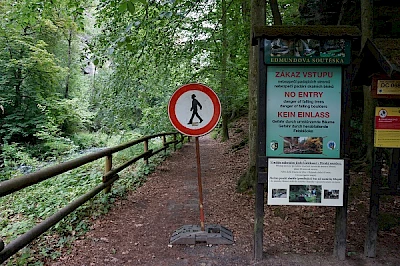
The popular Edmund Gorge (Edmundova soutěska) in Bohemian Switzerland will remain closed for significantly longer than previously known. The Bohemian Switzerland National Park announced that it will not carry out any tree felling work in and above the Edmundsklamm until 2027. The same applies to the Gabrielensteig (Gabrielina stezka) from Mezní Louka (Rainwiese) to Prebischtor (Pravčická brána). This means that the popular paths remain closed for safety reasons.
According to the national park administration, the area around the two paths should be left to its own devices for three years. “It has been shown that we can reopen the paths as quickly as possible if we give nature some time to regenerate,” explains national park director Pavel Kříž. As part of studies, a test felling was carried out above the Edmundsklamm. The intervention showed that felling on a large scale would destroy the nature around the paths and at the same time safety would not be guaranteed. “The felling would disturb the thin layer of soil,” says director Kříž. Stones and boulders could come loose. In addition, the felling itself is not without danger and involves high costs.
According to Kříž, simply leaving the burned stumps has other advantages. They store moisture and ensure sustainable drainage of rainwater into soil layers. At the same time, the tree stumps are food for insects, which in turn keep birds in the area as food. Some species of birds and bats also use the dead trees as nesting places. In addition, the burned trees scattered thousands of seeds that sprouted last year. Logging would also destroy this natural reforestation. A video commissioned by the national park shows what it looks like on the Gabrielensteig and above the Edmundsklamm and what consequences an impact would have.
The lockdown until 2027 is a hard blow. In an initial statement, the municipality of Hřensko, which owns the Edmundsklamm and runs the barge trips, was particularly disappointed. “The problem is that we largely take over the tasks of the state. We finance a fire department that not only takes care of fire protection on the front line, but also the mountain rescue service. We spend a lot of money on local police, who in many ways replace the absent state police. That costs a lot of money and we are sorely missing the income from the Edmundsklamm,” said deputy mayor Robert Mareš in an initial reaction to the daily newspaper Mladá fronta Dnes.
Děčín Zoo is car-free for three months
Anyone who wants to visit the zoo in Děčín in the coming months will have to be prepared for a short walk. Due to construction work, the only access road to the zoo, Žižkova Street, has been closed since Monday. The road should be open again from June 9th, before the start of the main season. But until then, visitors with fitness are required, as the zoo is located above the Shepherd's Wall (Pastýřská stěna). The road is only closed between 8 a.m. and 5 p.m. during the week. But times can still change and outside of construction work times, passage is only possible for cars.
Either way, the Děčín magistrate recommends leaving the car in the parking lot on Práce Street between the railway tracks and the Elbe and using the footpath over the Jahn Lookout (named after gymnastics father Friedrich Ludwig Jahn) and further uphill to the zoo. At 670 meters, this would also be the shortest route to the zoo. This option is also easily accessible from the main train station. As a second option, the red-marked hiking trail from the Tyrš Bridge over the Puchmayerova Street up to the Schäferwand is recommended. The car could then be parked at the parking lot below the Tyrš Bridge. This route is a little longer at just under a kilometer.
The closure comes at an inopportune time for the zoo, as it is celebrating its 75th anniversary this year. In an initial reaction, he quickly moved one of his anniversary events from May to August. Now the zoo is calling on its fans on August 31st to come to the zoo with a bear Nicki. The Siberian brown bear Bruno is the zoo's mascot and by far the most popular animal. The zoo wants to set a new record with as many Nicki bearers as possible.
The Czech Republic celebrates 25 years of NATO membership
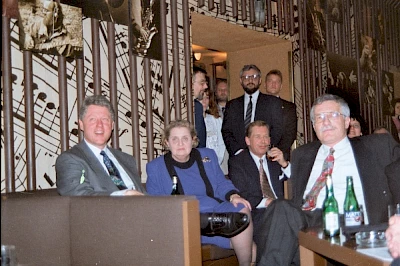
Three JAS-39 Gripen fighters, two Eurofighter Typhoon fighters and an A-400MS Atlas transport from Germany flew just 200 meters over the Czech capital on March 12. With this symbolic formation, the Czech Republic celebrated 25 years of membership in NATO. In March 1999, Poland and Hungary became the first former Eastern Bloc states to join the transatlantic defense alliance.
The then US President Bill Clinton took part in the celebrations in Prague as a guest of honor. His visit brought back memories, especially since the Czech President and former highest-ranking NATO general Petr Pavel gave his guest a visit to the legendary Reduta jazz club. Former President Václav Havel took him there in 1994. Clinton was not only enthusiastic, but was also persuaded to do a saxophone solo.
He left the music-making to others that evening, but he recalled that it was he who appointed the Czech-born Madeleine Albright first as UN ambassador and later as foreign minister. Albright, Havel's good friend, vehemently supported his efforts to get the Czech Republic into NATO as quickly as possible. Havel put all his foreign policy weight behind this, and it is indicative of the priorities in the neighboring country that the Czech Republic first joined NATO and then the European Union.
It was also significant that this week of all days the Czech Republic was able to report that it had collected enough money to purchase 800,000 rounds of artillery ammunition from third countries in order to quickly solve the ammunition shortage in Ukraine. Britain's The Telegraph could not praise this initiative highly enough. "If it's true that artillery is the king of war, then this small Eastern European country is the kingmaker..." Apart from the fact that Czechs see themselves more as Central Europeans, many people in the Czech Republic will be able to agree with this sentence.
Trouble between Prague and Bratislava
Where otherwise no leaf can fit between them, there is currently a cool distance: the two neighboring countries Czech Republic and Slovakia, which separated from Czechoslovakia into two independent states in an exemplary manner over 30 years ago, are currently divided over how to deal with Russian aggression in Ukraine. At the beginning of March, the Czech government decided to suspend regular government consultations.
It was only in the fall, after the left-wing populist Robert Fico took over as head of government in Bratislava, that both sides agreed to continue consultations. The summit of the Visegrád states, i.e. between Hungary, Poland, Slovakia and the Czech Republic, also ended on a conciliatory note in Prague at the end of February. The views on Russia and Ukraine couldn't be more different. On one side are the Pole Donald Tusk and the Czech Petr Fiala, both clear allies of Ukraine and staunch transatlanticists. On the other hand, Viktor Orbán is the eternal troublemaker in the EU, who doesn't want to give up his admiration for Putin. Robert Fico may have other motives, but in his pro-Russian stance he has nothing to do with Orbán.
But this meant that a red line had now been crossed for Prague. The Czechs have just successfully forged a coalition to supply ammunition to Ukraine. Fico's refusal to provide military support to Ukraine is an affront. How long the new ice age will last and whether and when consultations will resume is not yet known.
If you would like to receive our weekly review regularly in your email inbox, sign up for our newsletter.
To subscribe to the newsletter
 The creation of this newsletter is co-financed by tax revenue based on the budget approved by the Saxon state parliament.
The creation of this newsletter is co-financed by tax revenue based on the budget approved by the Saxon state parliament.
(This is an automatic translation by Google Translator.)
On March 4, 2024, circulation procedure No. 1 took place in the Elbe/Labe Euroregion. 1 project has been confirmed, the total amount is EUR 19,928.00.
(This is an automatic translation by Google Translator.)
Vorerst keine RegioJet-Züge nach Prag
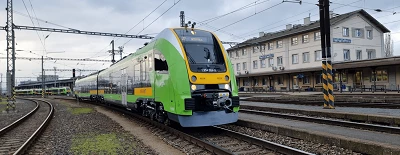
Das tschechische Eisenbahnunternehmen RegioJet startet vorerst keine regelmäßigen Zugverbindungen zwischen Prag und Berlin. Ursprünglich sollten auf der Strecke Prag-Dresden-Berlin ab 20. März täglich drei Zugpaare pendeln. Wie das Unternehmen mitteilte, hätte die Deutsche Bahn als Netzbetreiber keine ausreichende Streckenkapazität zur Verfügung gestellt. Auf Nachfrage von saechsische.de antwortete die Deutsche Bahn allerdings, dass RegioJet Kapazitäten erhalten hatte. Allerdings hätten sich die Fahrtzeiten aufgrund von Bauarbeiten verändert. Das sei für RegioJet offenbar nicht mehr attraktiv gewesen. "Die Slots waren nicht gut", wird RegioJet-Sprecherin Alexandra Janoušek Kostřicová von saechsische.de zitiert, und meint damit die von Deutsche Bahn angebotenen Fahrzeiten. RegioJet startet dagegen in Österreich und Ungarn durch. So wird die Zahl der Zugverbindungen zwischen den Hauptstädten Wien und Budapest aufgrund der hohen Nachfrage ab 4. April auf acht verdoppelt. Auch zwischen Prag und Brno kommt in den Morgen- und Abendstunden jeweils ein Zugpaar hinzu. Zwischen Prag und Dresden sowie Berlin bietet RegioJet aber wie gehabt Fernbusse an.
Kleiner Trost für die Strecke Berlin-Dresden-Prag ist die Verlängerung der Nachtzugverbindung European Sleeper aus Brüssel und Amsterdam nach Berlin weiter über Dresden in die Moldaustadt. Damit ergibt sich immer dienstags, donnerstags und samstags morgens eine weitere Direktverbindung aus Dresden und Bad Schandau. Der Zug fährt ab Dresden 8.24 Uhr (Neustadt) bzw. 8.31 (Hauptbahnhof) sowie ab Bad Schandau (8.58 Uhr).
Von Prag aus kommt (18.04 Uhr ab Hauptbahnhof) jeweils Dienstag, Donnerstag und Sonntag eine zusätzliche Verbindung am Abend hinzu.
Bischofsweihe in Litoměřice
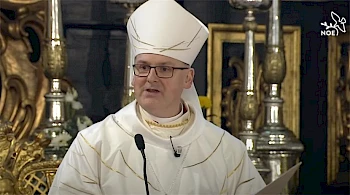
Am 2. März wurde der erst 52-jährige Stanislav Přibyl zum neuen Bischof des Bistums Litoměřice (Leitmeritz) geweiht. Der Weihe in der bis auf den letzten Platz besetzten Stephans-Kathedrale wohnten zahlreiche geistliche Würdenträger auch aus dem Bistum Meißen bei. Gleichzeitig bedeutete die Weihe den Abschied des scheidenden Bischofs Jan Baxant, der sein Amt aus Altersgründen nach 15 Jahren niederlegte.
Přibyl ist der jüngste Bischof der katholischen Kirche in Tschechien. In Litoměřice ist er kein Unbekannter. Der gebürtige Prager diente von 2009 bis 2016 im Bistum als Generalvikar. Wenn es seine Zeit zulässt, spielt Přibyl Orgel. Er spricht mehrere Sprachen, darunter auch Deutsch.
Tschechien stärkt Deutsch als Minderheitensprache
Das tschechische Parlament hat einer Erweiterung des Deutschen als Minderheitensprache zugestimmt. Damit wird Deutsch auf eine neue Stufe gehoben. Der Beschluss trat zu Ende Februar dieses Jahres in Kraft.
Die neuen Bestimmungen beziehen sich auf die Europäische Charta der Minderheitensprachen, die Tschechien bereits im Jahr 2006 verabschiedet hat. Sie besteht aus verschiedenen Stufen je nachdem, wie stark die Minderheitensprache geschützt wird. Deutsch wurde mit dem Beschluss nun in die dritte und höchste Stufe aufgenommen. Das gilt in den Regionen, in denen die deutsche Minderheit am stärksten vertreten ist. Neben drei Kreisen in Mährisch-Schlesien und Südböhmen sind das vor allem Kreise in Nordböhmen nahe der Grenze zu Sachsen wie Cheb, Sokolov, Karlovy Vary, Ústí und Liberec.
Für diese Kreise gelten neu 35 Förderbestimmungen. Dazu gehören unter anderem zweisprachige Schulen und Kindergärten, ein verstärkter Deutsch-Unterricht, aber auch die Möglichkeit, Deutsch bei Gericht sowie bei Behörden zu gebrauchen oder Rechtsurkunden auf Deutsch auszustellen. Auch außerhalb der acht Kreise soll Deutsch verstärkt gefördert werden. Das betrifft zum Beispiel den Unterricht in der Geschichte und Kultur der Deutschen in Tschechien sowie eine Förderung des Deutsch-Unterrichts.
Sowjetdenkmal muss weichen
Die Abgeordneten der Stadt Litoměřice haben beschlossen, das Denkmal des Sowjetsoldaten aus dem Jirásek-Park zu entfernen. Die Abgeordneten reagierten damit auf eine Petition, die zu einer Beseitigung des Denkmals aufgerufen hatte. Sie verabschiedeten aber einen Kompromissvorschlag. Demnach soll das Denkmal, das 1975 errichtet wurde, nicht ganz beseitigt, sondern an einen alternativen Ort verlegt werden. Autor des Denkmals ist der Künstler Otakar Petroš. Die Enthüllung erfolgte aus Anlass des 30. Jahrestages, an dem Tschechien von den Alliierten befreit wurde.
Der jetzige Standort im Jirásek-Park ist sehr prominent. Das Denkmal war in der Vergangenheit schon mehrfach beschmiert worden. Allein seit dem Überfall Russlands auf die Ukraine war es zu zwei neuen Farbanschlägen gekommen. Nach dem zweiten Farbanschlag hatte ein weiterer Unbekannter die Farbe teils wieder beseitigt und auf die ukrainischen Soldaten verwiesen, die in den Reihen der Roten Armee an der Befreiung Tschechiens beteiligt waren.
Wenn Sie unseren Wochenrückblick regelmäßig in Ihr Email-Postfach bekommen möchten, melden Sie sich für unseren Newsletter an.
 Die Erstellung dieses Newsletters wird mitfinanziert durch Steuermittel auf der Grundlage des vom Sächsischen Landtag beschlossenen Haushalts.
Die Erstellung dieses Newsletters wird mitfinanziert durch Steuermittel auf der Grundlage des vom Sächsischen Landtag beschlossenen Haushalts.
With direct bus from Schmilka to Prebischtor
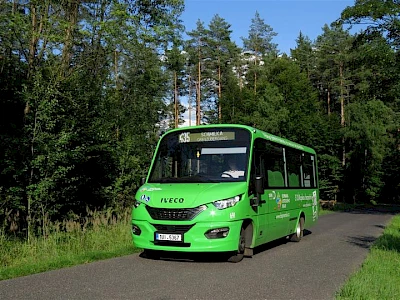
With the start of the excursion season, the transport connection from Saxony to Bohemian Switzerland is improving. The new bus route 435 will run every hour on weekends and public holidays from Schmilka, parking lot via Hřensko, Mezní Louka to Mezná. It also stops at the Tři prameny stop, where the footpath to Pravčická brána begins.
Line 435 already existed. The course has changed. She also travels much more frequently on an hourly basis. It begins operations on Good Friday (March 29th) and runs all year round until November 3rd. In the two summer months of July and August the bus even runs daily.
For tourists from Saxony there are two boarding options: one in Schmilka and one in Hřensko, where the ferry takes you from the Schöna S-Bahn station. What the exact connections will be remains to be seen, as the timetable will not be approved by the Ústí District Council until March 20th. “A connection to the S-Bahn and the ferry was not primarily our issue,” says Magdalena Fraňková, spokeswoman for the Ústí district. “In connection with line 438, which comes from Děčín and also goes to Mezná with a half-hour delay, there is an interesting half-hourly service from Hřensko to Mezná,” Fraňková continued.
The 435 buses also stop near the Schöna ferry, which makes it easier to change. In addition, the version of the timetable that has yet to be approved provides a transfer option to line 434 at the next stop Hřensko střed (Center), with which you can continue to Jetřichovice (Dittersbach) and Krásná Lípa (Schönlinde). Buses 438 continue to stop at Hřensko, nábřeží.
Despite starting in Schmilka, the 435 will run entirely under the Czech DÚK tariff (Ustí District Transport Association), so that no cross-border tariff will apply. This makes the connection interesting for Germany ticket holders as well as for those excursionists who come by car. They could then conveniently leave it in Schmilka. "For example, the ticket from Schmilka to the Prebischtor junction at Tři prameny costs 20 crowns (0.80 euros), the ticket to Mezná costs 31 crowns (1.24 euros). Payment is made on the buses either in cash in crowns or with a credit card The Elbe-Labe ticket is of course also valid on the bus.
By the way, shortly before Easter, the construction-related restrictions on the German side between Bad Schandau and Schmilka will no longer apply. From March 20th the S-Bahn will run again to Schöna. The National Park Railway is also running regularly again.
This year too, holidaymakers who stay at least two nights in Bohemian Switzerland, the Czech Elbe Sandstone Mountains or in the Schwenauer Zipfel can use public transport free of charge. The vouchers for this are issued electronically in the hotels and guesthouses. However, since this does not always happen automatically, it is advisable to ask if necessary.
Elbe shipyard near Děčín is insolvent
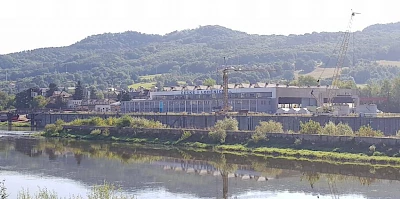
One of the last Elbe shipyards is insolvent. The district court in Ústí nad Labem (Aussig) approved the bankruptcy application of 30 employees of the České loděnice company. The company with a shipyard in the Křešice district of Děčín owes its employees over one million crowns (around 40,000 euros) in outstanding salary payments. This meant that the employees anticipated an application from the company itself. It talks about liabilities amounting to 60 million crowns (2.4 million euros). But that's not all. Other creditors are encouraged to come forward. At the same time, the company has already prepared a template for the reorganization of the company. The creditors' committee must approve this in the first half of May.
The shipyard's problems began with the Covid pandemic in 2020 and intensified with rising energy prices the following year and generally high inflation, which accelerated with Russian aggression in Ukraine. In addition, there was slow payment behavior from the shipyard's customers. The uncertain navigability of the Elbe was also a permanent problem for the shipyard. In some years it took months before finished ships could be transported to the clients in the Netherlands or Germany.
The tradition of shipbuilding in the Křešice shipyard dates back to the 19th century. In recent years, ship hulls for large freight ships in particular have been launched, which were then transported in a convoy to Germany or the Netherlands and then fully assembled on site. You can see the shipyard clearly from the train.
The future of the shipyard now lies in the hands of the creditors. If a majority of them agree to the restructuring in May, shipbuilding in Děčín can continue. If they reject the proposed plan, it will no longer be possible to prevent the end of the 150-year history of shipbuilding in Děčín.
Average income in the Czech Republic is around 10,700 euros
The average income in the Czech Republic in 2022 was 259,900 crowns (equivalent to approximately 10,700 euros at the end of 2022) per person per year. This means that it has increased by 7.7 percent compared to the previous year. However, due to very high inflation – one of the highest in Europe – real incomes fell by 6.5 percent. This was announced this week by the Czech Statistical Office (ČSÚ), which surveys 11,500 households every year.
The number of people living below the poverty line fell from 10.2 to 9.8 percent in 2023. The poverty line in the Czech Republic was an income of 16,774 crowns (approx. 661 euros at the current exchange rate) per month for a single person. In the EU statistics, so-called material and social deprivation is also considered with regard to poverty. This is accepted if people cannot afford 5 of 13 selected products ( more on this at the Federal Statistical Office ). This affected 6.3 percent of people in the Czech Republic last year, compared to 4.8 percent the previous year.
Small ski areas are drawing a line
The small ski resorts in the Ústí district have declared the winter season over. Some still had the hope of making snow again if the temperatures fell below zero. But now that spring break is almost over in the Czech Republic and school is back in session in Germany and the weather has gotten even warmer, it's no longer worth it. The lifts are only still running at Klínovec or Ještěd and in the Giant Mountains.
For most of the ski resorts in the Ústí district, it was a winter to forget. Thanks to the early snow in November, they had as many lift days as in a normal season. But already in January the weather was rather rainy, which is why few visitors came. Only in Klíny were they satisfied with the number of visitors.
Parliament rejects “marriage for all”.
A proposed law for “marriage for all” failed to find a majority in the Czech parliament. On Wednesday, however, the MPs approved a compromise draft with a clear majority of 123 votes to 53, according to which the rights of same-sex couples will be significantly strengthened in the future. The partners can now enter into a registered partnership in which one partner can adopt the other's biological child. One partner is also now entitled to a widow's or widower's pension if the other partner dies.
 The creation of this newsletter is co-financed by tax revenue based on the budget approved by the Saxon state parliament.
The creation of this newsletter is co-financed by tax revenue based on the budget approved by the Saxon state parliament.
(This is an automatic translation by Google Translator.)
On Friday, February 2, 2024, the first meeting of the KPF EEL took place in Ústí nad Labem. A total of 5 projects were approved, the funding totals €38,144.00.
Overview of approved projects
(This is an automatic translation by Google Translator.)
February 2024
Like every first Wednesday of the month, we will be showing a Czech film classic in the “ Czech Film Wednesday ” series on March 6th at 8 p.m. in the Central Cinema. This time we're playing "Rozpuštěný a vypuštěný" (Dissolved and Drained) from 1984.
With this film we have a crime thriller in our program for the first time, albeit an absurdly funny one. Towards the end of the Austro-Hungarian Empire, Inspector Trachta and his intern Hlaváček investigate the murder of the manufacturer Bierhanzl, who made a miracle ointment for hair loss from duck eggs and was apparently dissolved in sulfuric acid in a bathtub and his remains were flushed down the drain.
The legendary duo Svěrák/Smoljak has brought a piece of their Jára Cimrman theater to the screen. Jára Cimrman is a fictional character of an absurd universal genius invented by Zdeněk Svěrák in 1966. The whole Czech Republic knows and loves Jára Cimrman. He doesn't appear in this film, but the tradition of absurd theater is brilliantly implemented here. The film is bursting with ideas, even if you will unfortunately only fully understand the abundant wordplay with a good knowledge of Czech. But there are still enough absurdities and funny ideas to make it a lot of fun for the local audience.
(This is an automatic translation by Google Translator.)
New prices for motorway tolls in the Czech Republic
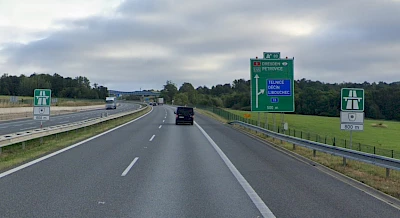
From March 1st, new prices will apply for the use of motorways in the Czech Republic. The prices for most variants fall slightly, only the annual vignette increases significantly. A one-day vignette will be introduced.
The prices for cars (up to 3.5t), teams (i.e. with trailers) and mobile homes in detail:
- 1 day: 200 Kč
- 10 days: 270 Kč
- 30 days: 430 Kč
- 1 year: 2300 Kč
Natural gas or biomethane vehicles pay a reduced price. Although electric vehicles are exempt from tolls, you have to apply for this first for vehicles registered abroad.
By the way: When driving into the Czech Republic, the route from the border to the Řehlovice exit is toll-free. In the other direction, however, this only applies between Řehlovice and Knínice (exit 80, see picture). You have to pay a toll for the last 12 km to the border.
Flooding again in Dolní Žleb
In Dolní Žleb, due to heavy rainfall in the Czech Republic in the next few days, it is expected that the road will be flooded again and the town will be cut off from its only access route. Only six weeks ago we were able to report that the road was above water again. Train traffic will not be affected.
Corruption scandal in Ústí
A corruption scandal is currently being investigated at the Ústí District Health Service, as the newspaper Deník reports. On Monday, the police searched the administration premises. The managing director was immediately dismissed. The investigation concerns overpriced purchases of medical equipment through the manipulation of public tenders. The European Public Prosecutor's Office in Luxembourg said there was damage of at least one million euros. This is dealing with the case because the purchases were largely financed with EU funding.
The Ústí District Health Service operates seven hospitals in the district. The Czech name "Krajská zdravotní as" is abbreviated as KZ, which sounds very unpleasant to German ears and is actually understood that way in the Czech Republic. Nevertheless, the title “Kauza KZ” is used for the scandal.
Legendary express train runs to Prague again
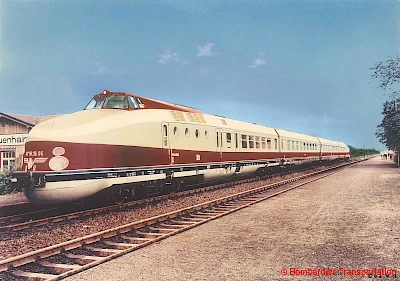
Finally, another topic that has something to do with the Czech Republic rather indirectly: Some may still remember the legendary SVT Görlitz express train (officially VT 18.16 or BR 175), which was one of the highest quality trains from the 1960s to the early 1980s GDR trains ran on international routes. For example, he traveled as Vindobona from Berlin via Prague to Vienna or as Karlex or Karola between Berlin and Karlsbad.
A lively association, with funding from the federal government, set out to make a copy of this train roadworthy again under the project title “ A Train for Central Germany ”. The first railcar was recently painted, the second will be there soon. After completion, which is expected in the next few months, the train will be used for special tourist trips. These also lead to Prague, among other places. More information can be found on the association's website.
 The creation of this newsletter is co-financed by tax revenue based on the budget approved by the Saxon state parliament.
The creation of this newsletter is co-financed by tax revenue based on the budget approved by the Saxon state parliament.
(This is an automatic translation by Google Translator.)
Neuer Mandau-Radweg durch Tschechien und Sachsen
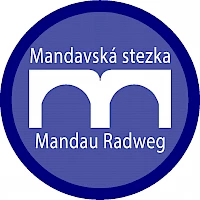 Tschechische und sächsische Partner haben sich auf einen neuen Radweg entlang des Mandau-Flusses geeinigt. Die Mandau entspringt als Mandava bei Brtníky in Tschechien, wo auch der neue Radweg beginnen soll. Er führt auf bestehenden Wegen weiter über Staré Křečany und Rumburk auf die deutsche Seite nach Seifhennersdorf, dann weiter nach Varnsdorf in Tschechien und danach endgültig nach Sachsen. Über Großschönau verläuft der Weg an der Mandau dort, wo heute bereits der Rübezahl-Radweg entlangführt, und endet in Zittau an der Mündung der Mandau in die Neiße.
Tschechische und sächsische Partner haben sich auf einen neuen Radweg entlang des Mandau-Flusses geeinigt. Die Mandau entspringt als Mandava bei Brtníky in Tschechien, wo auch der neue Radweg beginnen soll. Er führt auf bestehenden Wegen weiter über Staré Křečany und Rumburk auf die deutsche Seite nach Seifhennersdorf, dann weiter nach Varnsdorf in Tschechien und danach endgültig nach Sachsen. Über Großschönau verläuft der Weg an der Mandau dort, wo heute bereits der Rübezahl-Radweg entlangführt, und endet in Zittau an der Mündung der Mandau in die Neiße.
Der Weg soll in diesem Jahr ausgeschildert werden. Das Symbol befindet sich in einem blau umrandeten Kreis auf blauem Grund und bildet ein weißes M für Mandau, Mandava, aber auch Most, das tschechische Wort für Brücke. Letztendlich erinnern die Brückenbögen auch an ein Umgebindehaus, der für beide Seiten typischen Architektur dieser Region.
Mit dem Mandau-Radweg entsteht eine neue Verbindung von der Neiße zur Elbe über den in Brtníky beginnenden Kirnitzsch-Radweg, der an der Kirnitzschmündung in Bad Schandau endet.
Kirchenbezirk Dresden-Mitte beschließt Partnerschaft mit Děčín
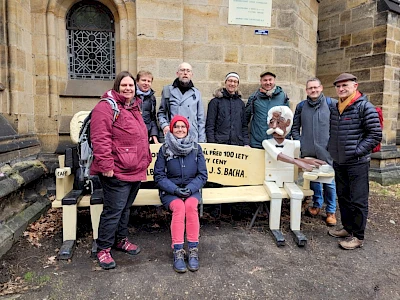
Der evangelische Kirchenbezirk Dresden-Mitte hat eine Partnerschaftsvereinbarung mit der Děčíner Kirche der böhmischen Brüder unterzeichnet. Damit wird eine schon 20 Jahre Verbindung offiziell bestätigt. Beide Gemeinden sind über regelmäßige Kinder- und Jugendfahrten aus Dresden nach Děčín verbunden. Initiiert und begleitet vom Kirchenbezirkskatechet René Herrmann hat sich ein vielfältiger Austausch entwickelt, der auf beiden Seiten bleibende Spuren hinterlassen hat und in immer neue Ideen der Zusammenarbeit mündet. Letzte Projekte waren die Erinnerung an den Besuch und ein Orgelkonzert des deutschen Pioniers der Entwicklungshilfe Albert Schweitzer in der Děčíner Christuskirche oder die Erforschung der sächsischen Geschichte der Christuskirche, die maßgeblich von der damals im mehrheitlich katholischen Děčín stationierten sächsischen Zollbeamtenschaft begründet wurde.
Eine Delegation mit Superintendent Christian Behr an der Spitze nahm kürzlich an der Einweihung des neuen Denkmals in Erinnerung an die Selbstverbrennung der jungen Tschechen Jan Palach und Jan Zajíc vor 55 Jahren teil.
Beide Gemeinden planen schon weitere gemeinsame Begegnungen. „Vieles verbindet unsere Regionen und noch vieles mehr wartet darauf, entdeckt zu werden“, sagt René Hermann. Im Rahmen der tschechienweiten „Nacht der Kirchen“ am 7. Juni 2024 singt in der Kirche des Děčíner Ortsteils Dolní Žleb der Bergsteigerchor „Kurt Schlosser“. Am 14. September 2024 werden Schülerinnen und Schüler der Evangelischen Musizierschule Dresden in der Evangelischen Christuskirche Děčín auftreten.
Schneemangel bedroht Grundwasser
Der Schneemangel bremst nicht nur den Wintersport aus. Wissenschaftler machen sich auch Sorgen um das Grundwasser. Denn das speist sich wesentlich auch aus dem langsam abtauenden Schnee. Doch der Wasseranteil im Schnee ist im Bezirk Ústí laut aktueller Angaben des tschechischen Hydrometeorologischen Instituts auf dem niedrigsten Stand der letzten 50 Jahre. Aufgrund der Regenfälle der letzten Wochen hat sich der Grundwasserstand wieder erholt. Doch der fehlende Schnee kann die Situation schnell wieder umkehren, so das Institut.
Innenministerin kündigt Verlängerung der Grenzkontrollen an
Bundesinnenministerin Nancy Faeser kündigte bei einem Besuch in Prag eine weitere Verlängerung der Kontrollen an der deutsch-tschechischen Grenze an. Durch die Kontrollen will Deutschland die Schleuseraktivitäten verhindern und den Flüchtlingsstrom kanalisieren. Die Kontrollen waren im vergangenen Herbst eingeführt worden.
Bei dem Treffen mit ihrem tschechischen Amtskollegen Vít Rakušan informierte Faeser, dass die aktuell bis Mitte März genehmigten Kontrollen voraussichtlich um ein halbes Jahr verlängert werden. Tschechiens Innenminister Vít Rakušan bedankte sich bei Faeser für die ausgezeichnete polizeiliche Zusammenarbeit, betonte aber, dass man das gemeinsame Ziel habe, in Zukunft wieder zu einem offenen Schengenraum ohne Binnengrenzen zurückzukehren. „Es sind Ausnahmelösungen, die man auch so wahrnehmen sollte. Wir sollten uns nicht an die Grenzkontrollen gewöhnen.“
Bei dem Treffen berieten die Minister auch über die Zusammenarbeit beim grenzübergreifenden Katastrophenschutz und das gemeinsame Vorgehen bei der organisierten Rauschgiftkriminalität.
Wenn Sie unseren Wochenrückblick regelmäßig in Ihr Email-Postfach bekommen möchten, melden Sie sich für unseren Newsletter an.
 Die Erstellung dieses Newsletters wird mitfinanziert durch Steuermittel auf der Grundlage des vom Sächsischen Landtag beschlossenen Haushalts.
Die Erstellung dieses Newsletters wird mitfinanziert durch Steuermittel auf der Grundlage des vom Sächsischen Landtag beschlossenen Haushalts.
By the end of 2026, the Elbe/Labe Euroregion, together with other Euroregions and other partners, will be carrying out a project for early neighborhood language education in kindergartens in Saxony.
Part of the project are so-called “language baths”. By this we mean a low-threshold offer in which preschool children are introduced to the Czech language in a relaxed manner. The language guides visit the daycare centers once a week, take part in the daycare center's normal day-to-day life, work with the children and convey educational content - all simply in Czech. We have already had very good experiences with this, as the children begin to say individual words in Czech by their third visit at the latest.
We are looking for two people to run these language baths on the German side of the Elbe/Labe Euroregion from now until the end of 2026 . The tasks include the following:
- A daily visit to one of five daycare centers in the border region (approx. from 9 a.m. to 1 p.m.), repeated weekly
- Conducting a language bath in Czech with the children
- Child-friendly communication of Czech culture and way of life
- Developing your own activities to engage with children
- Writing reports on the activity
- Participation in training courses
- Participation in exchanges of experiences with other language guides
Very good Czech language skills are absolutely necessary for these tasks.
We would like to use one person for daycare visits in the Hohnstein/Sebnitz area and one in the Dippoldiswalde/Altenberg area. Due to the location in the border area, it is advisable to have a driving license. Cars can be made available via partial car. The Euroregion bears the travel costs (tickets or kilometer allowance).
According to TVöD, remuneration is in pay group 9b.
We would be happy to accept your application by email to bewerbungen@elbelabe.eu until March 15, 2024 .
Work should start on April 1, 2024 if possible.
(This is an automatic translation by Google Translator.)
Děčín is renovating the Long Ride
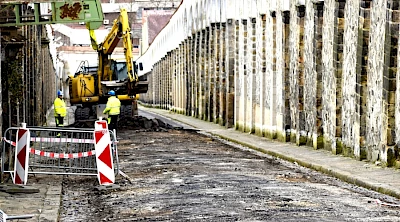
The time had come on Monday. Construction vehicles arrived and excavators tore up the asphalt surface of the almost 300 meter long drive to the castle in Děčín. Classic access to the castle will be closed almost all year round. The reason is the renovation of the access road that was built almost 350 years ago. Not only the condition of the road, but also the high walls surrounding it were already in poor condition. In the meantime, part of the wall had to be stabilized. By December, the asphalt will be replaced with concrete, the color of which will be reminiscent of historic gravel paths, and the wall will be completely renovated.
Since the entire access route, including side entrances, is closed, visitors sometimes have to take detours. It becomes almost impossible for people with restricted mobility to visit the castle. As an alternative access, the castle recommends using the southern gardens. But there are stairs there too. There is also a small parking lot near the warehouse. Alternatively, the path on the north side of the Elbe bank and the Tyrš Bridge can be used. The path winds up the northern slope and is relatively steep. Both alternative paths lead into the first castle courtyard.
The Langefahrt is one of the most sophisticated castle entrances. On the north side, in the upper part, is the rose garden, which has been closed since last August and whose renovation will take until 2025.
Ski resorts defy the thaw
The high temperatures and rainy weather make winter sports in the mountains almost impossible shortly before the start of the winter holidays in Saxony. The snow has also all but melted away in the Bohemian Ore Mountains. This means there is no snow for cross-country skiing. Some ski areas have also stopped operating for the time being. These include the ski areas at Bouřňák (Sturmer) near Mikulov and in Český Jiřetín. On the other hand, the ski areas in Telnice and Klíny still have enough artificial snow, but the conditions are not getting any better. The precipitation in the middle of the week caused a short-term improvement, as it fell as snow at altitudes over 500 meters, but disappeared again the next day.
Skiing is completely problem-free on the highest mountain in the Ore Mountains, the Klínovec (Keilberg). But even at this altitude the temperatures are currently above zero. The ski areas at Plešivec and Ještěd are also open. The relatively warm weather has been around for over three weeks. Low temperatures are not in sight until the end of next week. Until then, other ski areas could close temporarily.
Czech Republic continues without euro
President Petr Pavel made the introduction of the euro a topic in his New Year's speech. When it joined the EU in 2004, the Czech Republic actually committed itself to introducing the common currency. However, the Union is still waiting for this today.
But politicians had to react to the president's offer, especially since the mayor's party STAN, a government partner, has been trying for a long time to open the way to the introduction of the euro. The Pirates and TOP09 have also long been supporters. Prime Minister Petr Fiala's ODS is strictly against this.
At the beginning of the week, European Minister Martin Dvořák (STAN) created facts and appointed a coordinator for the introduction of the euro. It is the renowned economist Petr Zahradník. In doing so, Dvořák duped his coalition partners. On Wednesday it was agreed not to have a coordinator for the time being. However, Zahradník remains in office as Dvořák's advisor. However, he is not allowed to carry out cross-departmental coordination.
This means that the fate of the euro in the Czech Republic is likely to be sealed again. The parties know only too well that such a step would not have a majority among the Czech population. On the contrary, a large majority is in favor of retaining the crown.
Former ambassador to Germany František Černý is dead
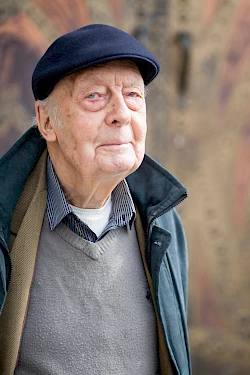
He was there wherever Germany and the Czech Republic came together. Former ambassador František Černý died at the beginning of February at the age of 93.
Born in Prague in 1931 into a German-Czech family, Černý carried the communication gene. After the Second World War, he first learned to be a machine lathe operator. In the 1950s and 1960s he experienced the growing thaw and the Prague Spring as a broadcast journalist. After the crackdown, he was no longer allowed to work as a journalist and made ends meet as a German teacher.
But after the Velvet Revolution his hour came. President Václav Havel knew only too well why he sent Černý as ambassador to Germany. First to Bonn, from where he moved the embassy to Berlin. But even the well-deserved retirement didn't end there. On the contrary, František Černý was very active in the sometimes painful process of growing together between the two states and in working through the sore points. Together with the last author of German-language literature by Kafka and Brod, Lenka Reinerová, and the Germanist Kurt Krolop, he founded the Prague German Language Literature House, where he was active until the end.
With Černý, not only the Czech Republic but also Germany is losing a mediator who was always interested and prepared to approach people with the nobility of the old school. He was actually an ambassador until the end and not just in retirement
 The creation of this newsletter is co-financed by tax revenue based on the budget approved by the Saxon state parliament.
The creation of this newsletter is co-financed by tax revenue based on the budget approved by the Saxon state parliament.
(This is an automatic translation by Google Translator.)
Overburden excavator near Most should be an attraction
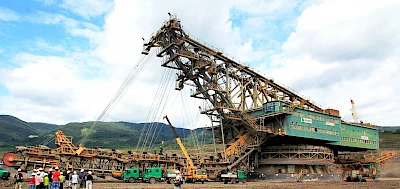
In a few years, all that will be left of the huge ČSA open-cast brown coal mine near Most (Brüx) will be a large lake. Next year, coal mining will end there and recultivation will begin. If everything goes well, there could still be a witness to coal mining. The Ústí district is negotiating with the owner, the mining company Sev.en, about the preservation of the RK 5000 overburden excavator. It is the largest of its kind in northern Bohemia. It was still in operation until 2016. However, to preserve it, it would have to be moved around one kilometer. Its current location will be underwater in the future. The crucial thing is to agree on who will cover the costs of the transport. These are estimated at around 3 million euros.
The bucket chain excavator is almost 160 meters long and almost 40 meters high. The giant, weighing 15,000 tons, was used from 1983. At that time, its purchase cost almost 250 million crowns, which corresponds to 160 million euros in today's prices.
The path to the Grundmühle is partly closed

Due to the removal of unstable trees, there will be restrictions on the yellow-marked hiking trail from Jetřichovice (Dittersbach) towards Dolský mlýn (Grundmühle) in the next few weeks. As the Bohemian Switzerland National Park informs, the work on the one kilometer long section will last until the end of March and only during the week. The path is open on weekends.
The basic mill is not affected by the felling and remains accessible. The national park recommends the blue marked trail from Vysoká Lípa and the green marked trail from Srbská Kamenice. Both are for pedestrians. The third option is the blue marked trail from Kamenická Stráň, which cyclists can also use.
Legendary Kotva department store is being renovated
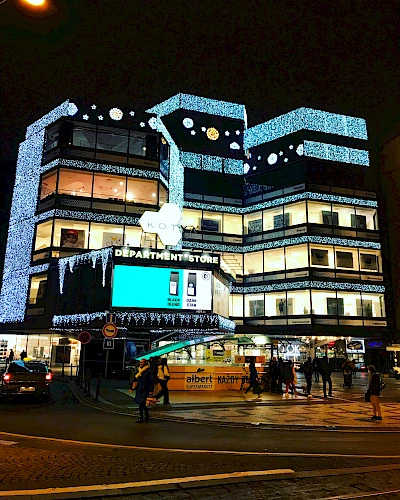
After 49 years, the Kotva department store in Prague is over. The largest department store in Czechoslovakia at the time was open for the last time on Wednesday. Now one of the brutalist icons in the Czech Republic is to be renovated. If everything goes well, the department store could reopen in three years.
The owner, the real estate subsidiary of the Italian insurance company Generali, wants to preserve 100 percent of the facade. The department store is probably the most famous work of the architect couple Věra and Vladimír Machonin. The two architects created a striking counterpoint to the surrounding older architecture in an attractive location on Republic Square (náměstí Republiky). The Kotva has been a listed building since 2019.
Changes are planned inside the department store and on the outside areas. There will be office space on the upper floors and a new restaurant at the top. The lower floors are intended for well-known brand stores. The investor would like to involve the public in the design of the outdoor facilities.
The Kotva is a legend of shopping culture. When it opened in 1975, army units had to ensure that the building was not stormed by the arriving crowds. In recent decades, like other department stores, it has struggled with a changing sales strategy that was more focused on so-called galleries or shopping centers. One of these modern consumer temples was created in 2007 with the Palladium in the former George of Poděbrady barracks directly opposite the Kotva.
Of the three most famous department stores in Prague before 1989, the Máj was the first to be transformed into a Tesco department store. The shopping center, which is now called "My" in English, now belongs to the Czech company Amadeus Real Estate. The third, much smaller functionalist-style department store Bílá Labuť, which opened in 1939, is now a kind of shopping gallery with various shops, but its popularity has declined sharply. It is located not far from Kotva on Na Poříčí Street. Renovation is also planned here.
Largest battery storage facility in the Czech Republic in operation
The Czech Republic's largest battery storage facility to date has gone into operation in Ostrava-Vítkovice. The battery is used to compensate for network fluctuations. At the same time, the system with a capacity of 10 megawatts can buy electrical energy at a reasonable price during the night and supply it during peak times. The same is possible with strong energy production from photovoltaic systems.
The investor and operator is the majority state-owned energy company ČEZ, which is already preparing other such projects. By 2030, ČEZ plans to commission 6,000 megawatts of renewable energy storage.
If you would like to receive our weekly review regularly in your email inbox, sign up for our newsletter.
To subscribe to the newsletter
 The creation of this newsletter is co-financed by tax revenue based on the budget approved by the Saxon state parliament.
The creation of this newsletter is co-financed by tax revenue based on the budget approved by the Saxon state parliament.
(This is an automatic translation by Google Translator.)
January 2024
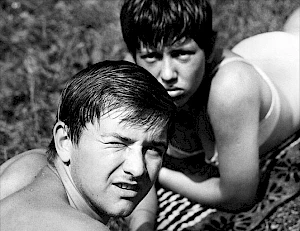
Like every first Wednesday of the month, we will be showing a Czech film classic in the “ Czech Film Wednesday ” series on February 7th at 8 p.m. in the Central Cinema. This time Miloš Forman's feature film debut »Černý Petr« (Black Peter) from 1963 is being shown.
The film describes two days in the life of 17-year-old Peter, who begins his apprenticeship in a socialist department store. A lot of things go wrong. Above all, he should make sure that no one steals (and that in socialism!). Things don't go much better with Pavla after work, neither in the outdoor pool nor at the dance evening. He just seems to pass the buck everywhere.
The then 33-year-old Miloš Forman shows with fine humor and a lot of empathy the life of young people in the 1960s with all the difficulties that come with love life, entering the world of work and the uptightness and stuffiness of the older generations. As in his second work The Firemen's Ball (which ran in this series last year), he takes an honest look at the people in socialist society, neither heroizing them nor - despite the humor - mocking them. A real portrait of the times.
This film will be shown as part of the "Czech Film Wednesday" series, as always in the original version with German subtitles.
(This is an automatic translation by Google Translator.)
The Elbe/Labe Euroregion supports smaller cross-border projects from the small project fund. The applicable capitation rates are adjusted annually to reflect the inflation rate. The specific flat rates for the three project types are as follows from February 1st:
| Project type |
Cost rate until January 31, 2024 |
Cost rate EUR/person day from February 1, 2024 |
|---|---|---|
| Events | 49 EUR | 53 EUR |
| (Further) training | 70 EUR | 76 EUR |
| Specialist conferences | 96 EUR | 105 EUR |
(This is an automatic translation by Google Translator.)
Cheetah offspring in Ústí
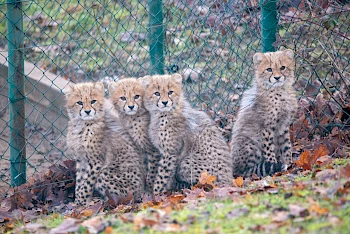
You usually only see something like this on television, but now it's almost on your doorstep: four young cheetahs in the Ústí Zoo. In return, visitors are granted exceptional access to a small enclosure above the cheetah house, where the four siblings can let off steam. But they can still only be seen to a limited extent, because due to the low temperatures, the hatch into the cheetah house remains permanently open. The four cute wild cats can go and warm up at any time, which they do actively. But as temperatures rise, they will become more visible.
The cheetah offspring was born in September. It was only announced at the beginning of December that the cheetahs had cubs. They can only be seen now. There is a reason for this reluctance: raising cheetahs in human care is extremely difficult. This begins with the selection of the couple who will only live together for the mating period and otherwise go their separate ways. In addition, the zoo had already been able to report two cubs in 2022, but both had to be euthanized one after the other due to a bone tumor. Despite the sad ending, the breeding was already a success for the zoo. The cheetah, for whom this was her first birth, has gained experience. The birth was also proof that the couple was fertile.
This time things seem to be going better, so the zoo is now going public more aggressively. If the four cheetah cubs continue to enjoy excellent health, they would be a real sensation. Because of the difficulties described, the four wild playmates are unique. The Ústí Zoo points out that only 14 cheetahs were born across Europe in 2023 as part of the cheetah breeding program. Only 6 of them are currently still alive, including the four in nearby Ústí.
Forest sets up shelters
The state forest is setting up 20 new shelters for hikers in its forests this year. The first was only released for use in the Schluckenau tip on the border with Saxony. It is located on the yellow-marked hiking trail just above the town of Severní and only a few hundred meters from the Hohwald Clinic. The next refuge will be completed in spring below Klínovec, the highest mountain in the Ore Mountains.
The open huts with sloping roofs are simply and functionally furnished. The most important building material is wood. The hut has a wide platform for sleeping, a bench and a table. They are usually located near watercourses, far from commercial accommodation options and usually on marked long-distance hiking trails such as Stezka Českem or Via Czechia. These routes have made long-distance hiking more popular in recent years. Long-distance hikers usually spend the night in the open air, but in the event of rain they also use existing shelters, which were not intended for sleeping.
The Krušnohoří Tourism Association (Ore Mountains) is also planning to build 12 trekking huts. But they should be closed and equipped with a photovoltaic system and a small oven.
Road to Hřensko open again
A heavy boulder came loose on Wednesday in Hřensko in Bohemian Switzerland and fell onto the Bad Schandau-Děčín highway. The road then had to be closed from the Schmilka/Hřensko border crossing. The cause of the fall was probably the strong wind. A fallen tree is said to have loosened the block. He had almost completely fallen onto the street. Due to its weight (around 15 tons), it had also broken through the metal safety nets, which are designed for chunks of up to 10 tons. A company then shredded the boulder on behalf of the national park administration, removed other smaller and larger pieces of rock on the slope that were in danger of falling, and repaired the safety nets. As of Friday, 1:50 p.m., the road was clear again.
 The creation of this newsletter is co-financed by tax revenue based on the budget approved by the Saxon state parliament.
The creation of this newsletter is co-financed by tax revenue based on the budget approved by the Saxon state parliament.
(This is an automatic translation by Google Translator.)
Inauguration of the monument to Jan Palach and Jan Zajíc in Děčín
On Tuesday, a new monument to Jan Palach and Jan Zajíc was inaugurated in front of the Protestant church in Děčín. The two students met on January 16th. or February 25, 1969 in Prague in protest against the occupation of Czechoslovakia by Warsaw Pact troops. On the 50th anniversary of this event, it was criticized that there was no monument dedicated to them in Děčín. The monument, now designed by the famous architect David Vávra, consists of a glass column and the two names, each with a handprint. When you touch it, the column lights up in different colors.
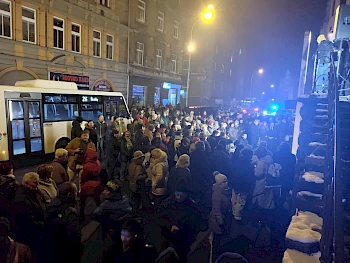
The crowds for the ceremony were overwhelming. It is estimated that at least 200 people attended. For the actual unveiling, the police had to regulate traffic in front of the church because the many guests could only find space using the street. There was then a series of speeches in the church, which was packed despite the low temperatures.
Czech Senate President Miloš Vystrčil emphasized in his contribution that although there was no direct connection between the two young men and the city of Děčín, the values for which they died should be linked to every place in the Czech Republic. In addition to Vystrčil, Mayor Anděl and other Czech representatives, representatives of the Evangelical Church in Saxony and Dresden also spoke. This was shown by the close contacts with the Protestant Church in Děčín, which were also expressed in the concert in honor of Albert Schweitzer in September 2023. Representatives also came from the twin town of Pirna.
An SZ article (unfortunately behind a paywall) sheds more light on the background of the monument.
City buys “Ustí Hole”
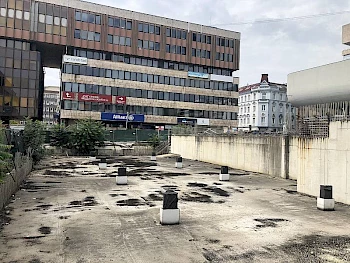
For 15 years, the cityscape has been blighted by an investment ruin at the upper corner of Mírové náměstí, which has been popularly nicknamed the "Loch of Ústí" (with a temporal overlap with the "Vienna Hole" in Dresden, if anyone remembers). The owner had started construction, but had to stop it in the basement for financial reasons. Since then, the unsightly construction site lay quietly in a prominent location between the municipality and the district administration and fell into disrepair.
Now the city of Ústí has bought the property for 73 million crowns and wants to build a building for public use on it. According to current plans, the structures built so far will be used, but the appearance will certainly be different in the end than planned almost 20 years ago. The city administration did not provide any more detailed information, but estimated that people will have to live with construction fences for at least another four years.
Excessive parliamentary debate on postal voting
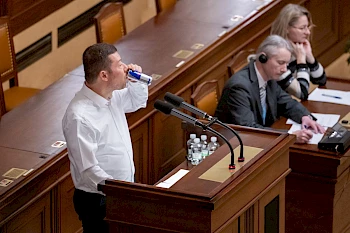
The Czech Parliament is currently debating the introduction of postal voting for Czechs living abroad. Although that's not entirely true, because most of the time people talk about completely different topics in order to drag out the debate, as various media reports.
On Wednesday, ANO boss Babiš stood at the lectern for almost four hours and spoke, for example, about the construction of the motorway to Austria. The fact that he described his southern neighbors as “magor” (crazy, idiots, fools) caused quite a stir.
The next day this was topped by the head of the right-wing populist SPD, Tomio Okamura, who spoke for almost 11 hours, mainly on historical topics, and read out, for example, an academic publication on the famous President of the First Republic Masaryk.
Due to illness, this week's newsletter is a little shorter.
If you would like to receive our weekly review regularly in your email inbox, sign up for our newsletter.
To subscribe to the newsletter
 The creation of this newsletter is co-financed by tax revenue based on the budget approved by the Saxon state parliament.
The creation of this newsletter is co-financed by tax revenue based on the budget approved by the Saxon state parliament.
(This is an automatic translation by Google Translator.)
Road to Dolní Žleb over water again
After exactly 20 days, the road from Děčín to Dolní Žleb was open again. On Thursday morning, the Elbe level in Děčín had fallen below the 4 meter mark, which is important for flood warning level 1. The street was cleaned during the day and the first cars were driving again in the afternoon.
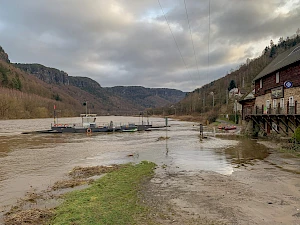
The street was flooded when the first wave of flooding began shortly before Christmas. For the residents of the last village on the left bank of the Elbe before the border with Saxony, which is part of Děčín, this means that the train becomes the only transport connection with the outside world. Since the car ferry doesn't connect to the highway on the other bank of the Elbe, the only option is to take the train. The residents of Dolní Žleb are already used to this. When the Elbe approaches the first flood warning level, they bring their cars to safe parking spaces in the Děčín city area so that they have a vehicle for longer journeys. However, the rising water brings with it further inconveniences. Bulk shopping is more difficult by train and the garbage is not picked up. Anyone who needs the rescue service has to be taken by boat to the other side of the Elbe by the fire department.
The situation on the rivers throughout the Czech Republic has now calmed down. Most recently, the first flood warning level was withdrawn in Litoměřice on Friday. The second flood warning level only applied to the Vltava in Český Krumlov and Vyšší Brod. But this is due to the fact that more water was released from the large Lipno reservoir, which was previously held back by the dam for flood protection purposes.
Hřensko's mayor resigns
The mayor of the border village of Hřensko, Zdeněk Pánek, resigned on December 31, 2023. Pánek did not want to speak to the media about the reasons for his resignation. He simply emphasized that it was his free decision and that it was not for personal reasons, but that he had to do with Hřensko.
The community is currently going through a difficult phase. Since the major fire in the summer of 2022, the Edmundsklamm has been closed due to the threat of tree collapse and rock falls. This meant that the largest source of income was lost, because the gorges belong to Hřensko. The municipality tried to counteract this by introducing an overnight tax and garbage charges for residents. But these are not real cuts. What is normal elsewhere, Hřensko had waived its citizens in times of bubbling income. As media reports, Pánek apparently no longer wanted to support these and other austerity measures, which forced him to resign.
Pánek is leaving after more than nine years as mayor. Before that, the lawyer with an office in Děčín was mayor for four years in 2002, and also deputy mayor in between. His successor will be decided at the next meeting of the local council. He must be elected from among the 7 local councilors. Until then, Vice Mayor Robert Mareš will be in charge of the official business. The next regular local elections will not take place until October 2026.
Trial of scandal speed camera
The speed measurement trial in Varnsdorf has begun at the district court in Ústí nad Labem. Four years after the police operation in the town hall of Varnsdorf, as a result of which mayor Stanislav Horáček and his deputy Josef Hambálek were arrested, the trial began that caused a great stir at the time. The city commissioned the company Water Solar Technology (WST) to measure the speed at four locations in the city. Thousands of drivers from Germany were also affected, because two measuring devices were in the Studánka district, through which the busy highway 9 from Saxony leads further into the interior of the Czech Republic. The Ministry of the Interior criticized early on that Varnsdorf had agreed to participate for each violation measured. WST therefore received a fixed sum for each case of increased speed.
In Ústí, not only Horáček and Hambálek, but also Horáček's girlfriend, Eva Petružálková, and the managing director of the WST company, Miloš Schubert, are on trial. The public prosecutor's office accuses them of abuse of office or aiding and abetting, taking advantage of a public tender, bribery and violating competition rules. Horáček, Hambálek and Petružálková testified on the first two days of the trial. All defendants deny the allegations. They face prison sentences of up to 12 years. The trial will continue in March.
Opening of the Lety Roma Memorial in April
The memorial at the site of the former concentration camp for Roma in Lety, southern Bohemia, is expected to open at the end of April. It was originally scheduled to open on February 3rd. However, the date had to be postponed for technical reasons, it is said. The reason is problems during the construction. The final work on the memorial is currently being carried out and work on the exhibition is underway.
In 2018, after years of struggle by human rights organizations and Roma representatives, the Czech government decided to build a memorial at the site of the former concentration camp to commemorate the Holocaust of Roma and Sinti. Until then, a pig farm operated there. The government bought the business and had it demolished. The memorial with a visitor center and exhibition has been under construction since last year. The construction is not only being financed by the Czech government. The Norwegian government contributes the money for the exhibition, and the German Embassy in Prague is involved in the construction of the memorial's outdoor facilities.
Along with Hodonín near Kunštát in Moravia, Lety was one of two camps where Roma were interned in the 1940s. Both camps were stopovers on the way to the extermination camp in Auschwitz-Birkenau. Hundreds of Roma died in Lety and Hodonín. Hodonín was in turn the site of a holiday home and a children's holiday camp for decades before a memorial was opened in 2019 after years of effort.
 The creation of this newsletter is co-financed by tax revenue based on the budget approved by the Saxon state parliament.
The creation of this newsletter is co-financed by tax revenue based on the budget approved by the Saxon state parliament.
(This is an automatic translation by Google Translator.)
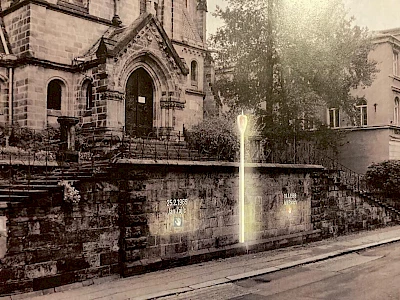
Jan Palach and Jan Zajíc were both students in Prague who met on January 16th. or February 25, 1969 in Prague in protest against the occupation of Czechoslovakia by Warsaw Pact troops. On the occasion of the 50th anniversary, it was criticized that there was no monument dedicated to them in Děčín.
The monument, now designed by the famous architect David Vávra, consists of a glass column and the two names, each with a handprint. When you touch it, the column lights up in different colors. It will be placed directly in front of the Evangelical Church on Teplická Street.
(This is an automatic translation by Google Translator.)
Epiphany collection has begun
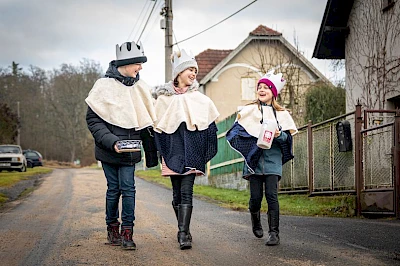
Traditionally, the three kings parade through the streets of the Czech Republic in the first days of the new year. Organized by the Czech Catholic aid organization Caritas (Charita), groups of children dressed as little kings ask for donations at the apartment and front doors. Collections also take place in the Prague metro or other central places. The Epiphany gathering began on New Year's Day in the Diocese of Litoměřice with a climb to Mount Říp.
Under the slogan “Every crown helps,” over 70,000 volunteers collect donations, primarily for those in need in Germany. This year, for example, the Charita of the Diocese of Litoměřice will specifically support socially disadvantaged families with children, the elderly and the sick. In most cases, the specific use is determined by the local charity organization. 5 percent of the money collected goes abroad. In the Diocese of Litoměřice donations are made to children of poor families in Mongolia.
How much money will be raised this year will be known by the beginning of February at the latest. The collection runs until January 14th. Last year, the Epiphany collection generated a total of 161.5 million crowns (around 6.7 million euros).
Second Elbe flood
After the Christmas flood comes the New Year's flood. The water levels on the Elbe have risen quickly in the past few days. The reason is renewed rainfall in the Elbe and Vltava catchment areas as well as the warm weather, which has triggered further thawing at higher altitudes. So far the flooding appears to be progressing smoothly. The third flood warning level was in effect in both Ústí nad Labem and Děčín since Friday morning. The peak was expected for Saturday morning. Contrary to what was initially feared, it should not exceed the level of the Christmas flood. However, the Czech Hydrometeorological Institute expects the flooding to subside only very slowly after the peak.
Pope chooses new bishop of Litoměřice
After 15 years, the diocese of Litoměřice (Leitmeritz) is getting a new bishop. Shortly before Christmas, Pope Francis had already chosen the current secretary of the Czech Bishops' Conference, Stanislav Přibyl, as Jan Baxant's successor. Baxant submitted his resignation after reaching the age of 75. He is succeeded by the 52-year-old Přibyl, the youngest bishop in the Czech Republic. The episcopal ordination is planned for March 2nd. Přibyl is no stranger to Litoměřice. The Prague native served as vicar general in the diocese of Litoměřice from 2009 to 2016. When time permits, Přibyl plays the organ. He speaks several languages, including German.
90 years of the Nelson mine disaster
The small town of Osek at the foot of the Ore Mountains commemorated the mining accident 90 years ago this week. On January 3, 1934, there was a fatal explosion in the Nelson III brown coal mine near Osek. The cause is believed to be brown coal dust, which was increasingly produced in the new shaking chutes. The high sulfur content of North Bohemian brown coal is also said to have played a role. The cause of the accident was never fully clarified.
142 miners died in the accident, only four survived. The dead left behind 130 widows and as many children. The survivors sometimes had to wait years for compensation, which was only raised through fundraising. Neither the coal company nor the state paid out a single crown.
The accident in Osek was one of the largest mining disasters in the Czech Republic. The Nelson mine was closed and there was no longer any mining in Osek. The last underground mining of lignite in North Bohemia stopped only a few years ago. Coal is currently only mined in large opencast mines.
 The creation of this newsletter is co-financed by tax revenue based on the budget approved by the Saxon state parliament.
The creation of this newsletter is co-financed by tax revenue based on the budget approved by the Saxon state parliament.
(This is an automatic translation by Google Translator.)
December 2023
Tschechien im Schock
Tschechien befindet sich im Schockzustand. Am Donnerstagnachmittag hatte ein 24-jähriger Student an der Philosophischen Fakultät der Prager Karls-Universität 13 Menschen erschossen und viele weitere zum teil schwer verletzt. Eine Person erlag später im Krankenhaus ihren Verletzungen. Bei den Toten handelt es sich fast durchweg um Studenten oder Angehörige des Lehrkörpers. Der Amokläufer tötete sich Polizeiangaben zufolge selbst. Das Hauptgebäude der Fakultät am Jan-Palach-Platz in der Prager Altstadt grenzt direkt an das jüdische Viertel Josefov. Ganz in der Nähe befinden sich die Karlsbrücke und der Altstädter Ring. Das Gebiet war am Donnerstag bis in die späten Abendstunden weiträumig abgesperrt. Die Polizei ermittelt nach einem Motiv und bringt die Schießerei mit drei weiteren Toten in der Nähe von Prag in Verbindung. Eine terroristische Tat wurde ausgeschlossen. Die Polizei geht von einem Einzeltäter aus.
In Reaktion auf die grausame Bluttat ist das gesamte öffentliche Leben im Nachbarland heruntergefahren. Nicht nur in Prag, sondern auch in anderen Teilen des Landes wurden Veranstaltungen abgesagt, Weihnachtsmärkte geschlossen. Dagegen finden spontane Gedenkveranstaltungen im ganzen Land statt. Für den 23. Dezember hat die Regierung Staatstrauer angeordnet. Im Veitsdom auf dem Hradschin zelebriert der Prager Erzbischof ein Requiem für die Opfer der Bluttat.
Die Karls-Universität hat über ihren Stiftungsfonds ein Spendenkonto eingerichtet, um den Hinterbliebenen zu helfen. Am späten Freitagnachmittag waren bereits knapp 22 Millionen Kronen (über 900.000 Euro) zusammengekommen.
Elbe-Pegel steigen
Die andauernden Regenfälle der letzten Tage und ein leichtes Tauwetter haben zu einem Anstieg der Pegel von Elbe und ihren Nebenflüssen geführt. Bereits an über 20 Orten musste das Tschechische Hydrometeorologische Institut (ČMHÚ) die erste Hochwasseralarmstufe ausrufen, an einigen sogar schon die zweite. Und die Pegel steigen in den kommenden Tagen weiter an.
Die Stadt Děčín hat deshalb am Freitag die ersten Hochwasserschutzwände aufgebaut. Die Pegelmarke von 4 Metern, ab der die erste Alarmstufe gilt, wird für Samstagmittag erwartet. Dann wird die Elbe die Straße nach Dolní Žleb überfluten und das Dorf an der Grenze zu Sachsen damit nur noch über die Eisenbahn mit Děčín verbunden sein. In der Heiligen Nacht bis zum ersten Weihnachtsfeiertag dann erwartet Děčín das Erreichen der zweiten Alarmstufe mit einem Pegel von 4,90 Meter.
Ob die Elbe in Děčín weiter auf über 5 Meter steigt, lässt sich im Moment noch nicht vorhersagen. Das hängt auch von der Entwicklung des Wetters in den kommenden Tagen ab. In Nordböhmen sind bis Dienstag immer wieder Niederschläge vorhergesagt, die in Grenznähe auch als Schnee fallen. Ihre Intensität lässt jedoch ab Sonntag nach. Auch die sächsischen Gemeinden müssen sich also auf einen steigenden Elbepegel einrichten. Das Landeshochwasserzentrum erwartet für Dresden das Erreichen der ersten Alarmstufe (Pegel: 4 Meter) für die Abendstunden des Samstag. Ob auch die zweite Alarmstufe (Pegel: 5 Meter) erreicht wird, ist noch nicht sicher.
Berghütte Lovoš findet neuen Betreiber
Die Hütte auf dem Gipfel Lovoš (Lobosch) im Böhmischen Mittelgebirge ist gerettet. Mitte Januar übernimmt ein neuer Betreiber. Der bisherige hatte nach nur drei Jahren das Handtuch geworfen.
Die Suche nach einem Nachfolger gestaltete sich aber schwierig. Zwar meldeten sich 40 Interessenten, aber die meisten sprangen wieder ab, nachdem sie sich mit den Bedingungen bekannt gemacht hatten. Die Versorgung der Berghütte ist zwar mit Allrad-Pickup möglich, aber es gibt keinen Transportlift und der Weg ist sehr steil. Letztendlich blieben nur noch acht Interessenten übrig, von denen mit vier Gespräche geführt wurden. Der neue Betreiber stammt zwar nicht aus Lovosice (Lobositz), aber er ist aus der Region und kennt den Lovoš.
Die Hütte auf dem markanten Berg gehört dem Klub tschechischer Touristen (KČT), Abteilung Lovosice. Der Gipfel ist beliebt für seinen Weitblick in alle Richtungen. Er gehört zwar mit 570 Metern nicht zu den höchsten des Böhmischen Mittelgebirges, dafür erhebt er sich aber steil über seine Umgebung. Der Höhenunterschied zur Umgebung sind 400 Meter. Gemeinsam mit dem Radobyl auf der anderen Elbseite bildet er von Prag aus kommend den Eingang zum Elbe-Durchbruch durch das Böhmische Mittelgebirge, auch Porta Bohemica genannt.
Die Übergabe in der traditionsreichen Berghütte, deren Wurzeln bereits ins Jahr 1892 zurückreichen, findet erst Mitte Januar statt. Das hat mit einem traditionsreichen Event zu Jahresbeginn zu tun. Dann findet der beliebte Neujahrsaufstieg auf den Lovoš statt. Jedes Jahr zu Neujahr tummeln sich hier deshalb Hunderte Wanderer.
Gemeinsam mit dem Milešovka (Milleschauer) ist der Lovoš der beliebteste Gipfel im Böhmischen Mittelgebirge. Jedes Jahr wird er von rund 50.000 Menschen bestiegen.
Frohe Feiertage und ein glückliches neues Jahr
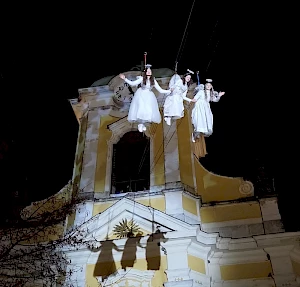
Liebe Leserinnen und Leser unseres Newsletters. Wir gehen in die Weihnachtspause. Den nächsten Wochenrückblick erhalten Sie am 5. Januar. Wir wünschen Ihnen frohe Feiertage und einen guten Rutsch in ein glückliches neues Jahr 2024.
Wenn Sie unseren Wochenrückblick regelmäßig in Ihr Email-Postfach bekommen möchten, melden Sie sich für unseren Newsletter an.
 Die Erstellung dieses Newsletters wird mitfinanziert durch Steuermittel auf der Grundlage des vom Sächsischen Landtag beschlossenen Haushalts.
Die Erstellung dieses Newsletters wird mitfinanziert durch Steuermittel auf der Grundlage des vom Sächsischen Landtag beschlossenen Haushalts.
The mass, composed in 1796, retains the structural features of a traditional Latin mass, but the focus is on the Bohemian character of Christmas and its interpretation and it was intentionally placed by Ryba in the Bohemian (or Czech) setting. Added to this is the fact that it is written in the Czech language. Jakub Jan Ryba was convinced that this is the only way a liturgical mass can find access to the listeners. Over time the fair has become the most popular fair in Bohemia.
Source: https://cs.wikipedia.org/wiki/%C4%8Cesk%C3%A1_m%C5%A1e_v%C3%A1no%C4%8Dn%C3%AD
(This is an automatic translation by Google Translator.)
National Park Railway will run for another 10 years
The operation of the cross-border national park railway in Saxon-Bohemian Switzerland is secured for the next ten years. The Upper Elbe Transport Association (VVO) has agreed to an extension of the contract with the Czech Railways České dráhy (ČD). The Ústí district had previously commissioned České dráhy to operate for another 10 years. The National Park Railway was put back into operation at the beginning of July 2014 after an interruption of almost 70 years. The prerequisite was the closure of the gap between Sebnitz and Dolní Poustevna, which had been fought over for decades. Since then, the railway has run as the Czech line U28 from Děčín via Bad Schandau and Sebnitz to Dolní Poustevna and via Šluknov to Rumburk.
Děčín is building a maternity hospital
The hospital in Děčín will have a new maternity clinic by 2026. The Ústí district hospital association, Krajská zdravotní, is building a new clinic for 477 million crowns (around 20 million euros), which is said to combine obstetrics and gynecology in equal measure. In addition to the latest technology, parents should enjoy maximum privacy. At the same time, the new building of the intensive care clinic and the emergency room is nearing completion. The first patients are scheduled to move into the new building in April 2024.
The maternity clinic in Děčín not only serves the residents of the town, which has almost 50,000 inhabitants, but also surrounding towns such as Česká Kamenice, Benešov nad Ploučnicí and Jílové, as well as Bohemian Switzerland and the entire Schwenauer tip. There is a hospital in Rumburk, but a maternity ward was closed years ago. At that time the hospital still belonged to the city of Rumburk. The Krajská zdravotní has now integrated it into its network, but a maternity ward is not yet planned again. In the event of a birth, parents have to drive an hour or more on the way to the hospital, which can be an adventure on the mountain roads in winter. A Saxon-Czech memorandum from 2019, which was intended to enable Czech patients in the border area in particular to receive cost-neutral treatment in nearby Saxon hospitals, has so far had no result.
To the Christmas market in the Czech Republic
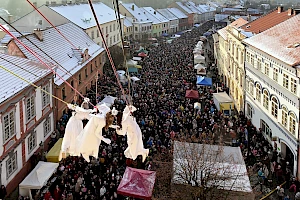
The Christmas markets in North Bohemia are becoming more and more attractive. With a new concept, Děčín has moved its multi-week Christmas market to the foot of the castle, creating an atmosphere with Christmas flair. The markets in Litoměřice and Teplice have also gained a Christmas atmosphere. The markets, which only take place on one or two days, are particularly worthwhile to visit. Several of these are taking place on the third weekend of Advent: the legendary Advent market in Úštěk, the Christmas market on the Castle Square in Teplice and the Castle Market in Děčín. We have put together a selection of the most beautiful Christmas markets in the Saxon-Czech border area for you.
Ústí district loses residents
According to the latest data, almost 11 million people live in the Czech Republic. As the statistics office ČSÚ reports, the country gained 54,700 inhabitants in the third quarter. There are now 10.88 million inhabitants living in the Czech Republic. As a result of the Covid pandemic and the high number of deaths, the population numbers fell for the first time in a long time. However, the situation changed suddenly after Russia invaded Ukraine. At times, 600,000 refugees came to the Czech Republic, where there was already a strong Ukrainian minority. The latest increases in population numbers are not due to a surplus of births, but rather to immigration. The number of births, however, was lower than the number of deaths.
While all regions of the Czech Republic are growing, the Ústí district remains the only one that is struggling with declining population numbers. The population here has fallen for the third year in a row. The district lost 2,113 residents in the third quarter. 810,224 people currently live in the district. Only the Litoměřice district bucked the trend in population growth.
The Czech Republic's economy is shrinking significantly
The Czech economy is in the middle of a recession. In the third quarter, gross domestic product (GDP) fell by 0.7% on an annual basis. Compared to the second quarter, GDP fell by half a percent. The background for the weak development is the continued weak consumption of private households and declining inventories. However, weak investment activity, especially in the private sector, and weak exports, otherwise an important pillar of economic growth in the Czech Republic, also had a negative impact. Only the investment activities of public budgets provided positive impulses, but were unable to reverse the decline in economic output, especially since the state imposed an austerity package. Analysts now assume that economic output will also decline for the year as a whole. The gross domestic product is therefore moving further away from the value it already had in 2019, before the Covid pandemic. The Czech Republic is the only country in Europe that has not yet reached the pre-Corona level. Read the analysis on Radio Prague .
The prospects for 2024 are not very rosy either. The government's austerity package will not provide any stimulus and private households continue to suffer from strong inflation, which is eating up real income and savings. Savings are made primarily on short- and medium-life consumer goods. Inflation has recently fallen further, but at 7.3 percent in November it was still significantly higher than in Germany. And it remains to be seen whether inflation will actually fall more significantly in 2024. Because further price increases are already pending. The food trade has announced further price increases despite the reduction in VAT. Depending on the region, water prices will increase by up to a quarter at the beginning of the year and restaurateurs are also pushing through further price increases.
(This is an automatic translation by Google Translator.)
Bohemian glass craft receives UNESCO title
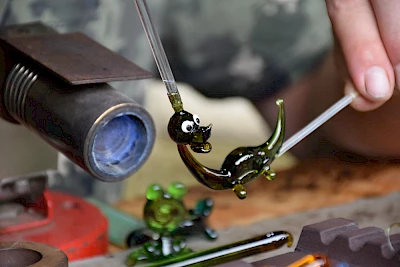
The Czech Republic can look forward to another UNESCO title. This time the international organization honored the intangible heritage of the glass craft. The Czech Republic received the title together with five other European countries. In addition to the Czech Republic, these are Germany, Finland, Hungary, France and Spain.
"This is a gift for everyone who has anything to do with glass," said Milada Valečková, head of the Glass and Jewelry Museum in Jablonec nad Nisou (Gablonz). In the Czech Republic, glass crafts are concentrated primarily in the districts of Liberec, Zlín and Vysočina. Over 5,000 craftsmen work there in around 100 workshops and companies. Traditional locations in North Bohemia are Kamenický Šenov, Nový Bor and Železný Brod.
The Saxon-Bohemian border area has already won its second UNESCO title in quick succession. At the beginning of September, UNESCO awarded the hop town of Žatec (Saaz) and the surrounding hop region the title of a World Heritage Site. The Erzgebirge mining region (together with Saxony) and the famous spas in Karlovy Vary (Karlsbad), Marianské Lázně (Marienbad) and Františkovy lázně (Franzensbad), which have also received the title along with several European spas, are also world heritage sites. Northern Bohemia is also home to the Czech Republic's only world natural heritage site, the beech forests in the Jizera Mountains.
Germany extends border controls
Federal Interior Minister Nancy Faeser has announced that stationary controls at Germany's borders with Poland, the Czech Republic and Switzerland will be extended by two months beyond December 15th. The step was justified by the results of the controls so far. As a result, since the controls were introduced in mid-October, 3,300 unauthorized entries have been detected and 1,100 unauthorized entries have been prevented. The Saxon Interior Minister Armin Schuster had previously called for border controls to be maintained in the long term, i.e. for at least six months. He sees it as a means of deterrence.
However, border controls are increasingly being criticized. As a result, it is highly questionable whether the effort is in proportion to the benefit. Markus Schlimbach, DGB chairman in Saxony, recently sharply criticized the controls at the first German-Czech regional forum. The greatest good, European freedom of movement, is being carelessly put at risk. The controls must be ended immediately. Especially on the Dresden-Prague motorway, kilometer-long queues of trucks form every day in the direction of Germany, which also affect buses and private transport. On some days the cars are parked until the Ústí nad Labem exit and have to be regulated by the police.
Andreas Roßkopf, who is responsible for the federal police at the police union, told the “Rheinische Post” that the number of asylum seekers cannot be reduced through police means and that asylum applications cannot be prevented. What needs to be clarified is "whether thousands of police officers should actually remain at the border or whether they should be better deployed for security in the cities and whether the asylum problem should be solved within the EU framework." The security situation at home is highly sensitive.
Cross-country ski trails and slopes prepared
The winter sports season also started earlier than in other years in the Saxon-Czech border area. The intense snowfall of the last few days has ensured that the cross-country ski trail network could be skied not only in the Bohemian Ore Mountains, but also in Bohemian Lusatia.
A little tip from us: Current information about the condition of the cross-country ski trails in the Czech Republic can be viewed daily on the website mapy.cz (also available as an app) if you switch the map display to "winter".
The season has also opened in the ski areas. Due to the sub-zero temperatures, sufficient artificial snow could be produced there in addition to the natural snow, which can also survive announced plus temperatures of slightly above zero. Almost all ski areas in the Bohemian part of the Ore Mountains went into operation on December 8th.
(This is an automatic translation by Google Translator.)
First German-Czech regional forum
The first German-Czech regional forum took place in Chemnitz. At the invitation of the Minister of State in the Foreign Ministry Anna Lührmann, representatives from the federal, state, district and municipalities from Germany and the Czech Republic exchanged ideas for two days. A wide range of representatives from various organizations active in the German-Czech border area were also invited, who spoke not only about the key topics of transport, the labor market and healthcare.
“Our goal is that people in the border regions are no worse off than elsewhere,” said State Minister Lührmann at the beginning of the forum. Workshops highlighted concrete problems that have existed for years in the emergency services, the status of Czech workers in Germany, cross-border transport connections, language training and the recognition of qualifications and have not yet been solved. The regional forum is intended to improve networking not only between the two states, but also between the administrative levels, the individual players and, last but not least, between Saxony and Bavaria. Lührmann announced that the problems raised would be forwarded to the appropriate authorities and that regional forums between the two countries would take place regularly in the future.
School strike and doctors' protest in the Czech Republic
On Tuesday, thousands of teachers took part in a nationwide strike. Unions announced that around half of schools had gone on a one-day strike. They were protesting against planned cuts in the education sector. They ensure that the number of hours is reduced, which is why there is a risk of loss of hours, especially in smaller schools in the regions. Employees from some companies and students also took part in the strike out of solidarity.
The strike was directed against the government, which has presented an austerity package to get the budget deficit under control. It is reacting to the necessary special spending in recent years as a result of the corona pandemic and the war in Ukraine, which have caused the budget deficit to rise sharply. In response to the strikes, Prime Minister Petr Fiala pointed out that the education budget, along with the defense budget and the social budget, are the only three departments whose spending will increase in the 2024 budget.
An indefinite strike by the medical profession seems to have been averted. Doctors had announced that they would no longer work overtime from December 1st, which would have led to severe disruptions to health care. The doctors' goals are to change the labor code to regulate 24-hour shifts and to improve pay. These demands are now being met. Labor Minister Marian Jurečka and Health Minister Vlastimil Válek introduced an amendment that reverses planned changes to labor law and allows doctors to work twice as much overtime as before. In addition, after negotiations, Prime Minister Petr Fiala promised almost 10 billion crowns more for higher doctors' salaries.
Czech route Dresden-Prague next year
The Czech Transport Minister Martin Kupka would like to announce the route of the new Prague-Dresden line on the Czech side by the end of 2024 at the latest. The minister said this at a dialogue forum with affected communities in Ústí nad Labem. The state railway network administration Správa železnic (SŽ) is currently pursuing three different routes through the Bohemian Central Mountains, which are rejected by the affected communities. The tunnel exit at Chlumec and the passage through Ústí are also controversial. The Elbe city calls for freight traffic to be routed around the city. The approximately 57 kilometer long section from the Bohemian Central Mountains to Prague with a new terminal at Roudnice nad Labem has already been determined. The first commissioning of the new high-speed line is also expected here.
(This is an automatic translation by Google Translator.)
November 2023
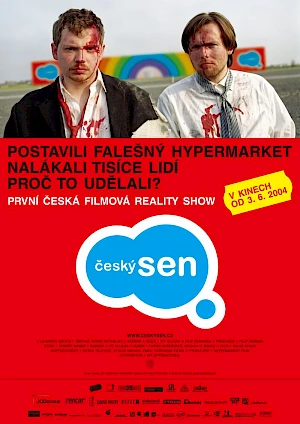 Our audience was allowed to vote on the Wednesday film in December and chose: “Český sen” (The Bohemian Dream). This 2004 film is a nasty documentary-satire about a supposed opening of a hypermarket.
Our audience was allowed to vote on the Wednesday film in December and chose: “Český sen” (The Bohemian Dream). This 2004 film is a nasty documentary-satire about a supposed opening of a hypermarket.
Two students from the Prague Film School are making a very special film as their final thesis: the facade of a huge hypermarket is being built on the outskirts of Prague. At the same time, there are massive advertising campaigns for the supposedly opening market. On the day of the "opening" a show is staged, which culminates in the waiting customers running towards the market and disappointed to find that they have been thoroughly processed. Then things get high...
More about the film and tickets
(This is an automatic translation by Google Translator.)
We had to wait a long time, but now the time has come: the new small project fund has started! Applications for funding for Saxon-Czech encounter projects can now be submitted again.
In the past, simplifications were often promised that turned out not to be the case. But this time it really looks like it: There are now capitation fees for projects with a determinable number of participants (i.e. all classic encounter projects). No offers need to be obtained and no individual receipts need to be provided at the end. All you need is proof of the number of participants. It couldn't be easier. So anyone who has held back on project applications in recent years due to the bureaucratic burden should try again now.
There are two downsides: There is still no legal basis for projects without an ascertainable number of participants. They probably can't start until mid-2024 at the earliest. And projects to promote tourism are no longer possible in the KPF.
You can find all information about this on our website.
For information on the small project fund
(This is an automatic translation by Google Translator.)
Deutsche Bahn is building a full tunnel variant
After months of testing, Deutsche Bahn has decided on a continuous tunnel for the new Dresden-Prague high-speed line through the Ore Mountains. This creates a 30 kilometer long tunnel that disappears underground near Heidenau and only comes to the surface again near Chlumec (Kulm) on the Czech side. It would be the longest railway tunnel in Germany.
A year ago, Deutsche Bahn limited the number of route variants from 10 to 2. The so-called full tunnel variant was not included in the railway's original plans, but was only brought into play by a citizens' initiative. The second so-called partially open variant had a shorter tunnel and a 27 kilometer long tunnel through the Ore Mountains. A bridge over the Seidewitztal was supposed to connect the two buildings.
The variant now chosen with the continuous tunnel is the best solution “for the environment as well as in terms of traffic, technology and economy,” Deutsche Bahn announced on Monday.
The new building, which is around 43 kilometers long, is intended to relieve pressure on the flood-prone Elbe valley and more than halve the travel time from Dresden to Prague from 2 hours 15 minutes to one hour. It is part of the future Berlin-Prague high-speed line and, in the future, continues to Vienna and the Balkans.
However, it will still be almost ten years before construction begins. The next big milestone for the project is the vote in the Bundestag on implementation and financing. This could happen in 2025. Deutsche Bahn expects building rights to be granted in 2032. The construction period is estimated to be around 12 years.
Edmundsklamm will remain closed in 2024
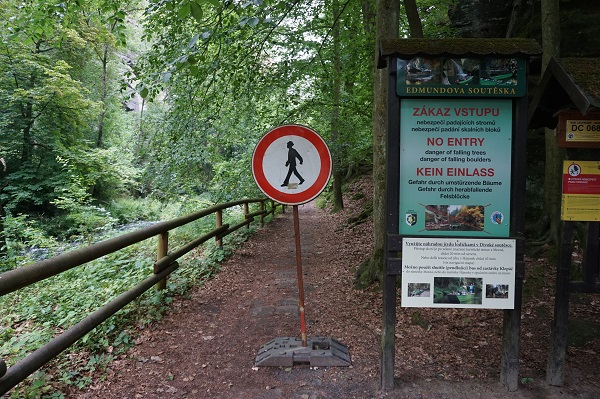
The Edmundsklamm, which has been closed since the devastating forest fire in the summer of 2022, will not open next year either. When asked, the Bohemian Switzerland National Park said that no opening date could be given. However, an opening in 2024 is ruled out. The same applies to the Gabrielensteig. The popular and panoramic hiking trail leads from Mezní Louka (Rainwiese) to Pravčická brána (Prebischtor). A total of 15 kilometers of marked hiking trails are currently closed. This affects around 5 percent of the hiking trails in the national park. The marking was removed for another 14 kilometers. You can hike there at your own risk.
The fact that a year and a half after the forest fire and years after the bark beetle catastrophe so many hiking trails are still closed was explained by national park spokesman Tomáš Salov, citing the different legal situation in the Czech Republic. All paths are now clear again in Saxony. The Bohemian Switzerland National Park, on the other hand, is responsible for safety on the paths. The national park is also liable for damage caused by the removal of dangerous trees. Strict protection requirements also apply in the quiet zone. The removal of trees causes significant associated damage. The natural regeneration is disrupted, there is a risk of instabilities in the rock and greater erosion stress occurs. This was also shown by the test clearing of a small section of the Edmundsklamm in the summer. However, the results of this pilot project are still pending.
Salov was confident that the first paths could be opened soon. But this applies more to paths in the back of Bohemian Switzerland. The decay process of damaged trees has already progressed far enough. This concerns the path from Hadí pramen (Snake Spring) to the Maiden Fir (Panenská jedle). At the same time, the national park is cutting down trees on many hiking trails to prevent further paths from being closed. The hiking trail at Brtnický potok (Zeidlerbach) is currently temporarily closed.
Municipalities and the tourism association, on the other hand, are demanding more effort from the national park in order to reopen paths more quickly. They accuse the national park of permanently closing hiking trails.
RegioJet displaces České dráhy from Ústí regional traffic
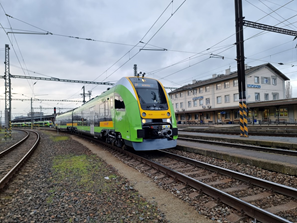
The Czech railway company RegioJet has won a tender to operate six electrified railway lines in the Ústí district. As RegioJet announced, they had submitted the lowest offer. With 90 percent weighting, the price was decisive for the outcome of the procedure. RegioJet will therefore take over the strategic lines U1 Děčín-Ústí nad Labem-Most-Kadaň, U2 Chomutov-Karlovy Vary and U3 (Děčín-) Ústí-Litvínov as well as the lines U32 Ústí-Lysá, U51 Ústí-Klášterec nad Ohří and U54 (Děčín - ) Ústí-Roudnice (-Hněvice). RegioJet already operates for the Ústí district on the routes Ústí nad Labem-Děčín on the right bank of the Elbe and Ústí-Upořiny-Most.
The Ústí district has not yet officially confirmed the outcome of the proceedings, citing the current objection period; the participants have been informed. However, the losing competitor České dráhy had made a statement, to which the Ústí district responded, thereby indirectly confirming the winner, RegioJet. So far, all lines have been operated by the state-owned České dráhy, for which the defeat is a significant loss. The Ústí district excluded České dráhy (ČD) due to a procedural error, writes the server zdopravy.cz. The company left it open whether ČD would object.
The new operator is scheduled to take over the routes when the timetable changes in December 2026. The operating contract is for 15 years.
Trekking huts for the Ore Mountains
The Krušnohoří (Ore Mountains) Tourism Agency plans to build 12 trekking cabins. They are intended to offer hikers a simple overnight camp. A simple wooden construction is planned. The huts should be equipped with photovoltaic systems and a small oven. The construction of the first two huts is planned in Adolfov near Telnice and in Sněžná near Kraslice in the Western Ore Mountains. The trekking huts are primarily intended to serve long-distance hikers. The new long-distance hiking trail Stezka Českem (Around the Czech Republic) runs through Adolfov.
Million-dollar projects for the Saxon-Czech border area
Improved early childhood education in the neighbor's language, cross-border cycle tourism and several nature conservation projects are among the projects that have received a commitment to receive funding from the European Union in the cross-border program Interreg Saxony-Czech Republic 2021-2027. At its meeting in Schönbach im Vogtland, the program's monitoring committee approved 17.7 million euros for 15 cross-border projects. The “Neighbouring Language from the Beginning” project was awarded almost 2 million euros under the leadership of the Euregio Egrensis, in which the Elbe/Labe Euroregion is also involved.
A little more than 2 million euros in funding will go to the “By bike to the neighbor” project led by the municipality of Doln'í Poustevna, in which the cities of Sebnitz and Hohnstein are involved.
A total of 28 Saxon-Czech projects have already been supported in the current funding period.
(This is an automatic translation by Google Translator.)
Digitální Kulturní pas EEL each možné letos získat stažením application zdarma zde:
Apple App Store: https://apps.apple.com/cz/app/uneeqly/id1610296683?l=cs
Google play: https://play.google.com/store/apps/details?id=com.uneeqly.app
(This is an automatic translation by Google Translator.)
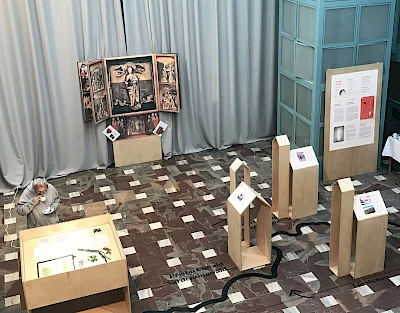
Die „Fürstenauer Madonna“ bringt seit langem die Menschen aus Böhmen und Sachsen zusammen. Sie ist die zentrale Figur eines eindrucksvollen Altars aus dem 15. Jh., der ursprünglich aus Pirna stammt und im Laufe der Jahrhunderte über Fürstenau und Vorderzinnwald nach Teplice wanderte.
Nun gibt es eine Ausstellung, die die Wanderschaft der Madonna nachzeichnet. Künstlerische Elemente beschreiben die einzelnen Stationen, zwei große Vitrinen zeigen archäologische Funde aus Vorderzinnwald, und der Altar ist als großformatige Fotokopie präsent. An jeder Station werden die Besucher mit Ereignissen, Sagen und einer historischen Persönlichkeit bekannt gemacht, die die engen Verbindungen zwischen Böhmen und Sachsen aufzeigen.
Die Ausstellung war bisher bereits in Dubí und in Krupka zu sehen. Vom 24. November 2023 bis zum 7. Januar 2024 wird sie in der Dresdner Kreuzkirche gezeigt. Der Eintritt ist frei. Die Eröffnung findet am 24. November um 14 Uhr statt (ursprünglich war fälschlich 17 Uhr genannt worden).
Educational agreement for bilingual high school
25 years after the start of the bilingual and binational German-Czech education branch at the Friedrich-Schiller-Gymnasium in Pirna, the education ministries of Saxony and the Czech Republic have decided on a permanent education agreement. The document was signed on November 8th by Head of Culture Wilfried Kühner and his Czech colleague, Vice Minister Jaroslav Miller.
This means that the long-standing project is now becoming a permanent institution, says the Saxon State Ministry for Culture. The agreement relates to the educational program and the boarding school. The revision resulted in a flexible, contemporary and permanent contract, which significantly strengthens the personal responsibility of the Friedrich-Schiller-Gymnasium, it goes on to say.
"With the new agreement, we are laying the foundation for long-term Saxon-Czech educational cooperation. The binational-bilingual educational program at the Friedrich-Schiller-Gymnasium is the flagship of our cross-border educational cooperation," said Kühner.
The binational-bilingual course lasts six years. It is intended for students from grade seven to grade twelve. Lessons are organized each school year in a binational-bilingual class with 14 Czech and 14 Saxon students.
Sister cities Dohna and Chlumec
It's not every day that a new partnership is formed between cities. The Saxon Dohna and the North Bohemian Chlumec (Kulm) did it. The partnership had been initiated organically over the past five years through collaboration between sports and cultural clubs. The fire departments have also been cooperating for a long time. Some of the projects were funded by the Elbe/Labe Euroregion. As the Sächsische Zeitung reports, the partnership was officially sealed in a two-page contract.
Dohna and Chlumec are separated by just 40 kilometers. Chlumec lies at the foot of the Ore Mountains and borders the district town of Ústí nad Labem (Aussig) to the northwest. The city has just over 4,000 inhabitants. Like Dohna, the city is located directly on the Dresden-Prague motorway. A monument in Chlumec commemorates the Battle of Kulm in 1813, when Napoleon's troops were defeated by the allied Russians, Austrians and Prussians.
The next exchange between the two cities will take place on November 25th, when the Dohna choir travels to Chlumec for a concert.
Does a wildcat live in Bohemian Switzerland?
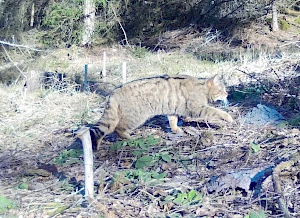
What was caught by a camera trap in the Bohemian Switzerland National Park in March 2022 could be a small sensation. In the photo in daylight light, a cat sneaks through the picture. This is not an ordinary house cat. The experts are very sure that it is a specimen of a wild cat. “The typical characteristics of a wild cat are easy to recognize, such as the stripes on the fur and the size,” says Martin Valášek, zoologist at the Bohemian Switzerland National Park. Valášek is even sure that it is not a cross with a domestic cat, but a pure wild cat.
It is still unclear whether the wildcat settled in the national park or was just passing through, and if so, where it came from. In the Czech Republic, wild cats live in small numbers in the Bohemian Forest (Šumava), in the Beskydy Mountains and in the Duppau Mountains (Doupovské hory) in northwest Bohemia. The national park has the photos evaluated externally by the Agricultural University in Prague. The find has only now become known due to the large number of recordings.
The national park has now placed wooden sticks coated with valerian near its camera traps. This is a proven lure for wild cats. If the cat rubs against it, it could lose a hair of its fur, which would allow researchers to conduct DNA analysis.
Wild cats are very shy animals. They need low-disturbance forests with dead wood in which they create caves and avoid open terrain with little cover.
Karel Schwarzenberg died
The Czech Republic mourns the death of former Czech Foreign Minister and lifelong fighter for democracy and freedom Karel Schwarzenberg. The nobleman, who was known only as the "Prince" in the Czech Republic, died on November 11th in a Vienna hospital. Schwarzenberg was 85 years old.
Born in Prague in 1937, Schwarzenberg grew up in Orlík Castle in southern Bohemia in one of the richest families in Europe. In 1941 the National Socialists confiscated the Schwarzenbergs' property, some of which they got back after 1945. After the communist coup and renewed expropriation, the family emigrated to Austria in 1948. Before 1989, Schwarzenberg supported the political opposition in his home country. He was appointed office manager (chancellor) by President Václav Havel in the early 1990s. He later became a senator and was elected to parliament for the Greens. From 2007 to 2009 and again from 2010 to 2013 he was Foreign Minister of the Czech Republic. This makes him the foreign minister with the longest service to date. In 2013 he ran for President of the Czech Republic and narrowly lost to Miloš Zeman in the runoff election.
Karel Schwarzenberg was the head of the House of Schwarzenberg since 1979. The Czech government has decided to hold a funeral with state honors for Schwarzenberg. His body will be on display in the Church of Saint Mary Under the Chain (Kostel Panny Marie pod řetězem) in Prague's Lesser Town from December 6th to 8th. The funeral mass will take place on December 9th in Prague's St. Vitus Cathedral on Hradcany.
(This is an automatic translation by Google Translator.)
Schicht factory receives monument status

The Czech Ministry of Culture has granted monument status to the administrative building of the historic strata works in Ústí nad Labem (Aussig). This is only part of the building. The owner, the company STZ Development, had the oldest part demolished in March to make way for a parking space. There was strong protest against this by architects, historians and many citizens. But the demolition permit was valid, among other things because the building was not listed at the time.
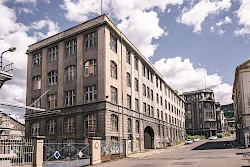
An initiative therefore immediately applied for monument protection to the Ministry of Culture, which has now been granted. However, this decision is not yet legally binding; the company STZ Development has lodged an objection against it.
The Schicht works are located on the right bank of the Elbe in Ústí in the Střekov (Schreckenstein) district and have played a decisive role in the rise of Ústí to an industrial city of European standing. In the 1920s, the Schicht family's factories merged with the Dutch Margarine Unie and the British Lever Brothers to form the Unilever corporation, which still exists today.
Kyjov dam is being renovated
For the first time in 47 years, the Kyjov (Khaa) dam on the edge of Bohemian Switzerland was drained. The background is the renovation of the building from the 1960s. The dam is to be upgraded as a fire water reservoir. A fund created by the Czech government for fire protection in Bohemian Switzerland covers the majority of the costs with 15 million crowns. By excavating 7,500 cubic meters of sediment alone, the dam's capacity increases. The improved water depth also makes it possible for water to be extracted by helicopter. In addition, the weir will be renewed. A paved fire water extraction point with access will be created. Access for bathers should also be improved. The dam is a popular swimming lake. The renovation is scheduled to be completed in spring 2025 and the dam will be filled with water again.
Since one bank of the dam is already in the Bohemian Switzerland National Park, the town of Krásná Lípa (Schönlinde), to which Kyjov belongs, must fulfill several requirements. The mud can only be dredged until the end of February 2024. “Then we will interrupt this work for now and only start it again next winter,” says Mayor Jan Kolář. When the water was drained, a surprise awaited the community: there were masses of pond mussels in the water and mud. “We were expecting a few hundred, but in the end there were almost 20,000,” says Kolář. This incredible number could only be partially distributed among the other community-owned ponds. Neighboring communities like Chřibská (Kreibitz) helped out. A very small portion of the shells served as food for forest animals such as foxes and wild boars.
Forest arsonist charged
The public prosecutor's office has brought charges against the alleged cause of the forest fire that engulfed and destroyed large parts of Bohemian and Saxon Switzerland last summer. “The indictment was sent to the district court this week,” Kateřina Doušová, prosecutor at the Ústí District Prosecutor’s Office, confirmed to the idnes.cz server. The public prosecutor's office accuses the former national park ranger not only of arson in the major fire, but also of other acts such as the burning of parts of the observation tower on the Vlčí hora (Wolfsberg) and the neighboring building, perches and feeding places. According to police, the 36-year-old is said to have admitted the crimes.
The largest forest fire in the history of Bohemian Switzerland caused damage worth 350 million crowns. This increases the maximum possible sentence for arson to 15 years in prison. The public prosecutor's office is demanding 12 years' imprisonment for the defendant.
(This is an automatic translation by Google Translator.)
VW moves battery factory in Czech Republic
Volkswagen is not building its gigafactory planned in Central Europe for the time being. The group cited the slower development of electromobility as the reason. Volkswagen's decision is, above all, against the Czech Republic. That's where the negotiations were most advanced. Recently, the Czech government pushed Volkswagen to speed up. The Czech Republic had prepared a plot of land in Líně, near Plzeň Airport. The property is conveniently located close to the D5 Prague-Plzeň-Regensburg motorway. On Monday, CEO Oliver Blume met Prime Minister Petr Fiala and gave him the bad news.
The decision is only about not tackling the battery factory now, but later. VW is sticking to its three other planned factories in Germany, Spain and Canada. But in the Czech Republic the news was received as a serious setback. Industry Minister Jozef Síkela emphasized that the government is currently negotiating with five additional investors. Of these, two projects would be the size of what Volkswagen planned, two would be medium-sized and one project would be smaller. Síkela did not name names.
The vice president of the Industry and Transport Association Radek Špicar does not believe that this decision will set the Czech Republic back, but said on Czech television Česká televize: "The automotive industry is going through a dramatic, complicated and expensive transformation towards alternative drives. It would be important to do so to get an investment, also in view of the fact that we want to mine and process lithium in the Ore Mountains." He also pointed out that the Czech Republic had lost its former location advantage of cheap and sufficiently available workers. In addition, energy prices in the Czech Republic are now higher than in Poland or Hungary. The government must work on these problems.
The Ústí district had also long had hopes of setting up a gigafactory in northern Bohemia, near Saxony. Whether the VW decision increased the chances for the location near Prunéřov near Kadaň was initially not an issue.
New wind power rules in the Ústí district
The Ústí District plans to adopt a new policy on the construction of wind turbines. The Supreme Administrative Court declared this part of the principles of regional planning to be invalid a few weeks ago. The previous regulation had made the construction of wind turbines almost impossible. Plaintiffs, however, successfully sued for discrimination. Other construction projects are not subject to such strict regulations. Municipalities, private individuals and companies had sued. The district also did not take public interest in renewable energies into account enough.
The Ústí district wants to develop the new principles within the next few months and adopt them this year. Nature conservation remains the top criterion against the construction of wind turbines, which is why nature conservation organizations and the Ministry of the Environment should be involved in the reformulation process. However, it is foreseeable that a future regulation will open the way to more wind turbines, but uncontrolled growth should be prevented, it is said.
There are a total of 50 wind turbines in the Ústí district, a quarter of all wind turbines in the entire Czech Republic. Almost all wind turbines in the Ústí district are located at high altitudes in the Ore Mountains.
Hřensko charges a tourist fee
Starting next year, overnight guests will have to pay 20 crowns per night in Hřensko (Herrnskretschen). The local council decided this. The border village hopes to compensate for the loss of income that has torn a deep hole in the community's coffers due to the closure of the Edmundsklamm. The income from parking fees is unchanged. But overall the income is only a third compared to a normal year with the Edmundsklamm open.
The accommodation fee is collected by hotels and guesthouses and passed on to the municipality. However, payment is only due from the second night.
German-Czech mayor meeting in Hohnstein
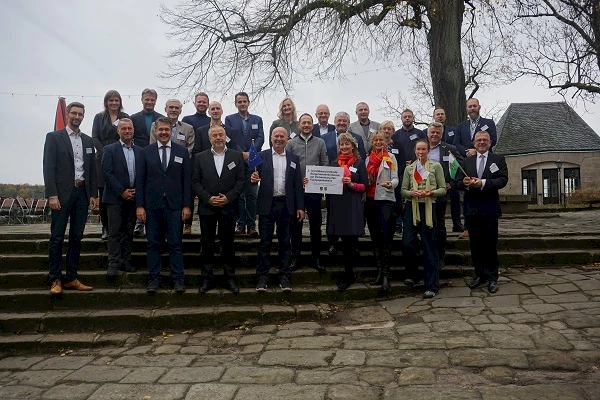 On Friday, mayors from municipalities on both sides of the border met in Hohnstein for a networking meeting. It was the second meeting of this kind after April. The conference was organized and initiated by the Saxon Switzerland Economic Initiative. The aim is to better network communities and cooperate on cross-border projects. The first meeting took place in Krásná Lípa. The second meeting was also attended by District Administrator Michael Geisler, the Czech Consul General in Dresden Mark´´éta Meissnerová, the managing directors of the Euroregions Elbe/Labe and Nisa/Neiße, Rüdiger Kubsch and Ondřej Havlíček, representatives of the Saxon Switzerland and Bohemian Switzerland tourism associations and a representative from German-Czech Future Fund.
On Friday, mayors from municipalities on both sides of the border met in Hohnstein for a networking meeting. It was the second meeting of this kind after April. The conference was organized and initiated by the Saxon Switzerland Economic Initiative. The aim is to better network communities and cooperate on cross-border projects. The first meeting took place in Krásná Lípa. The second meeting was also attended by District Administrator Michael Geisler, the Czech Consul General in Dresden Mark´´éta Meissnerová, the managing directors of the Euroregions Elbe/Labe and Nisa/Neiße, Rüdiger Kubsch and Ondřej Havlíček, representatives of the Saxon Switzerland and Bohemian Switzerland tourism associations and a representative from German-Czech Future Fund.
"The great interest shown by the mayors shows us the importance of this event. We aim to repeat these meetings twice a year in the future," announced the mayor of Hohnstein and host, Daniel Brade.
(This is an automatic translation by Google Translator.)
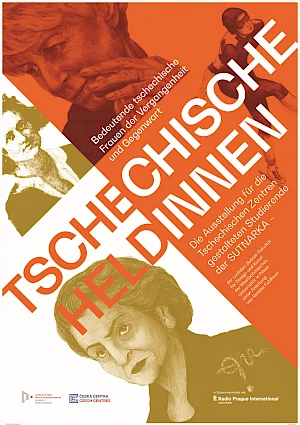 Forty important women from history and the present are portrayed in a poster exhibition at the Czech Center. The posters were designed by students from the University of Plze'n. Each poster is a specially designed work of art in its own style. Among those portrayed are rulers, painters, writers, politicians, scientists, athletes and much more.
Forty important women from history and the present are portrayed in a poster exhibition at the Czech Center. The posters were designed by students from the University of Plze'n. Each poster is a specially designed work of art in its own style. Among those portrayed are rulers, painters, writers, politicians, scientists, athletes and much more.
The exhibition will open in the Dresden Cultural City Hall on November 2nd at 7:30 p.m. Annekatrin Klepsch (Deputy for Culture, Science and Tourism of the State Capital Dresden) and Dr. Markéta Meissnerová (Consul General of the Czech Republic in Dresden) will welcome those present. Historian Hana Pištorová from the Czech Centers will introduce the content of the exhibition. Eli Kalčeva will provide the musical accompaniment.
All interested parties are cordially invited to take part in the exhibition opening. Admission is free.
(This is an automatic translation by Google Translator.)
October 2023
November 1st is Czech Film Wednesday again. Since this issue falls into the TDKT, this time there is no classic, but a current film: “Banger”.
The film follows Alex (Adam Mišík), a drug dealer with the best coke in Prague, for just a few hours. His goal: He has to quickly raise 5,000 euros to record a feat with the well-known rapper Sergei Barracuda (he really does exist). He should become a real Bagner and fulfill his dream of becoming a famous rapper. And above all, he should bring his girlfriend back. He is accompanied by his best friend Laďa ( Marsell Bendig, who won an award for this in Karlový Vary), who throws pretty much everything into himself. The film rushes through the evening until the bitter end.
Aesthetically, “Banger” is very unusual: It was shot entirely on an iPhone and always stays incredibly close to the characters. This really brings out the rushed mood.
(This is an automatic translation by Google Translator.)
Due to illness, this week's newsletter is a little shorter.
Shift epic in the Senate
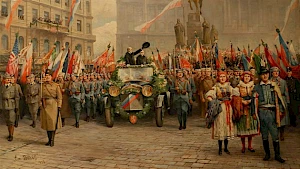 In 1928, the Schalt family of industrialists from Ústí nad Labem - best known for their deer soap - had an epic with 22 paintings made about events from Czech history in order to donate them to the Czechoslovak state. These paintings became the basis of large-format prints that were used in many schools. The 14 motifs for Czech schools were painted by Emanuel Boháč, the 8 for German schools by different painters. The layers, for whom the nationality question played no role in their companies, wanted to underline their loyalty to the Czechoslovakian state. The most famous painting is “The Arrival of the First President of Czechoslovakia Dr. TG Masaryk in Prague on December 21, 1918”. This is also shown in the exhibition "Our Germans" in the city museum in Ústí nad Labem.
In 1928, the Schalt family of industrialists from Ústí nad Labem - best known for their deer soap - had an epic with 22 paintings made about events from Czech history in order to donate them to the Czechoslovak state. These paintings became the basis of large-format prints that were used in many schools. The 14 motifs for Czech schools were painted by Emanuel Boháč, the 8 for German schools by different painters. The layers, for whom the nationality question played no role in their companies, wanted to underline their loyalty to the Czechoslovakian state. The most famous painting is “The Arrival of the First President of Czechoslovakia Dr. TG Masaryk in Prague on December 21, 1918”. This is also shown in the exhibition "Our Germans" in the city museum in Ústí nad Labem.
Martin Krsek, senator, historian and employee of the Ústí City Museum, has now organized an exhibition of some of the images in the Senate in Prague. This is until November 5th. can be seen in the anteroom of the meeting room in the Wallenstein Palace (Valdštejnský palác).
Visits are possible on Mondays between 2 p.m. and 3 p.m., but must be registered in advance by calling 257 072 678.
Source: Radio Prague International
Czech National Day on October 28th
Every year on October 28th In the Czech Republic, people commemorate the founding of independent Czechoslovakia in 1918. Because it fits so well with the motto of this year's Cultural Days (see below), we would like to draw attention to it: It certainly says a lot that, on the one hand, it is the anniversary of the founding of a state that no longer exists continues to be a national holiday, while on the other hand the founding of the current Czech Republic in 1993 is not celebrated. Short advertising block: background information will be published on November 9th. discussed in Sebnitz .
Please note: Most shops in the Czech Republic will be closed tomorrow.
25th Czech-German Cultural Days opened
The 25th Czech-German Cultural Days opened yesterday in the Dresden Palace of Culture with a great concert by the Dresden Philharmonic Orchestra and the Prague Philharmonic Choir. This year's theme "Breaks" was originally inspired by the 30th anniversary of the dissolution of Czechoslovakia and aims to show that such upheavals can also be departures. Until November 12th, almost 90 events will take place on both sides of the border throughout the Elbe/Labe Euroregion.
(This is an automatic translation by Google Translator.)
Stationary border controls
Since Monday evening, Germany has resumed stationary controls at the border with the Czech Republic for the first time since the corona pandemic. Fixed controls were set up at the A17, Heideholz rest area. From the direction of the Czech Republic, traffic behind the state border was narrowed to one lane and routed through the Heideholz rest area. There are further fixed checkpoints at the Reitzenhain/Hora Svatého Šebestiána border crossing (B172/I7). There were also temporary checks at smaller border crossings.
Depending on the time of day and the intensity of the inspection, there were sometimes significant delays in travel time. Czech employees who commute to work in Saxony reported waiting times of up to half an hour. When a Euroregion employee re-entered Saxony from the Czech Republic on the Dresden-Prague motorway on Wednesday afternoon, a kilometer-long queue of trucks had formed in the right-hand lane, stretching far into the Czech Republic. However, cars were able to drive past the truck queue and queue up just before the narrowing. The federal police only carry out random checks and allow most vehicles to roll through slowly. This way the time delay was only up to two minutes. At regular intervals, suspicious vehicles (delivery trucks, but also semi-trailers) were brought into the parking lot and searched.
Czech commuters expressed themselves predominantly negatively in Facebook groups (Pendleři). The controls would make the daily commute to work much more difficult. Saxony relies on Czech skilled workers in many industries. Czech politicians such as Interior Minister Vít Rakušan expressed understanding and the belief that Germany only carries out random checks and thus affects entry as little as possible. They also expect that the inpatient controls will only be used temporarily.
After much hesitation, Germany requested inpatient controls from the European Union. The background is the growing number of migrants who enter Germany illegally across the Czech-German border with the help of smugglers. The state of Saxony had previously supported the federal police's veil search with its police.
Bust for August the Strong
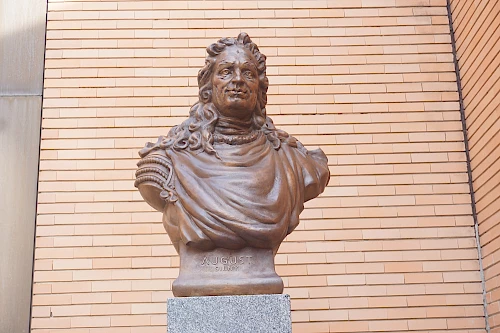
A bust of August the Strong was unveiled in Teplice. At the back of the Beethoven spa house, the bust sits on a pedestal in Lázeňská (Badgasse). The spa company commissioned the bust from the sculptor Libor Pisklák and wanted to use it to honor the spa town's close ties to the Saxon court. Every year August and his court moved into Teplice. His entourage numbered up to 1,500 people and 1,000 horses. In 1705, for example, he was accompanied by the court guard. 220 men of infantry and 209 of cavalry. This year marked the 340th anniversary of August's first spa stay in Teplice. The elector and later Polish king wasn't just here to take a cure. Teplice was also governed properly. The place was ideal for foreign policy because August was not the only ruler here. Teplice has always been the spa town of rulers. Augustus was also not the first Saxon ruler, he just continued a tradition that continued until his great-great-grandson, King Friedrich Augst II.
Teplice modernizes cultural center
The North Bohemian Philharmonic Orchestra from Teplice has to move to the neighboring Erzgebirge Theater because its venue, the Culture House, is being renovated. The work of star architect Karel Hubáček, who became known for his radio tower and mountain hotel on Ještěd, will receive a new foyer and a new main entrance. This means that the cultural center can now be accessed from two sides. The foyer area is complemented by a new café with outdoor seating. New escape routes had already been created beforehand. The house also gets new and more toilets, new electrics, new air conditioning and new heating.
However, the rest of the building remains unaffected by the renovation. The heart of the cultural center, which borders directly on the well-known colonnade made of steel and glass, is the concert hall with 550 seats. It is the most modern in the Czech Republic outside of Prague and is known for its great acoustics.
New podcast: Czech Republic six times
The Czech Republic is the focus of the Saxon State Center for Civic Education (SLpB). With the new podcast “Six Times Czech Republic” the institution is getting closer to the neighboring country. The first episode deals with the topic "Climate and Environment", with guests such as former Environment Minister Bedřich Moldan, analyst Romana Březovská, environmental psychologist Jan Krajhanzl and MEP and former Defense Minister Alexandr Vondra. The second episode has already been published. It is dedicated to the topic of "Czech Republic's relationship with Russia". Guests include the historian Karel Svoboda, the political geographer Michael Romancov and the extremism expert Jan Charvát.
As the name suggests, a total of six episodes are planned on six different topics. The podcasts are created in collaboration with Radio Prague International and will be published gradually. Episode three on the topic of “LGBTQIA+ and the Catholic Church” will be published in November.
(This is an automatic translation by Google Translator.)
German gravestones in the rose garden
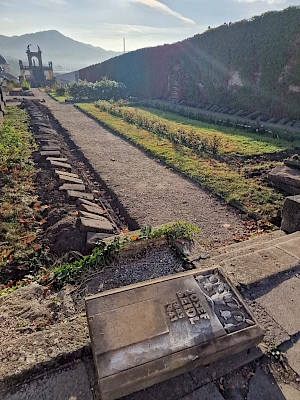 The rose garden at Děčín Castle will be renovated by the end of 2025. The workers came across a surprising find. Nine gravestones served as bases for vases and plant pots. Research has shown that they used to stand in the municipal cemetery of Podmokly (Bodenbach) in Škrabky and were apparently later removed and taken to the construction yard. During the renovation of the rose garden in the 1960s, they came to the castle as building material. Since they lay with their backs facing up, most of the grave inscriptions have been preserved. The names come from German residents before 1945, when the city was predominantly populated by Germans.
The rose garden at Děčín Castle will be renovated by the end of 2025. The workers came across a surprising find. Nine gravestones served as bases for vases and plant pots. Research has shown that they used to stand in the municipal cemetery of Podmokly (Bodenbach) in Škrabky and were apparently later removed and taken to the construction yard. During the renovation of the rose garden in the 1960s, they came to the castle as building material. Since they lay with their backs facing up, most of the grave inscriptions have been preserved. The names come from German residents before 1945, when the city was predominantly populated by Germans.
The castle management would like to return the gravestones to their original location. “In two weeks, when the work on the cemetery fence is completed, the stones will return to the cemetery,” announced castle director Miroslava Poskočilová. Historian Petr Joza, from the regional archives in Děčín, pointed out that the tombstones are worth preserving because they were made in the Germanic style in the 1930s. Some of them have already been left in the cemetery as an example.
The renovation will return the rose garden to its original form. As a result, there are no steps and the garden will be deeper in the future, but on one level. New additions include water features and access to the bastion. The roses are also being replanted. The current roses have already moved to the south garden. The rose garden is scheduled to reopen at the end of 2025.
Buses instead of ECs
Due to construction work on the control and safety technology in the Königstein - Kurort Rathen section, all international connections from Dresden to Ústí nad Labem (Aussig) will be canceled between October 17th and 27th. Instead, replacement buses will run from Dresden main station, Strehlener Straße. The buses leave 10 minutes earlier than the trains. From Ústí there is a connection to the onward journey to Prague or Graz and Budapest. Replacement buses also run on the return journey. These depart from Ústí six minutes later and arrive in Dresden later. From Dresden there is a connection to trains to Leipzig as well as Berlin and Hamburg. You can find the exact timetable here .
Tourist club buys Wolfsberg property
The Czech Tourist Club (KČT), section Krásná Lípa (Schönlinde), bought the property right next to the observation tower on Vlčí hora (Wolfsberg). There was a cabin on the property that burned down in the spring. The tower was also damaged, but was able to remain open. The tower belongs to the city of Krásná Lípa, with which the tourist club cooperates. “It was important to us that the summit remained in one hand and that no one built anything privately,” said club chairman Václav Hieke. The club paid the purchase price of 150,000 crowns out of its own pocket.
Last reminder: New newsletter from the Euroregion Elbe/Labe
A third and final time on our own behalf: So far we have only had one newsletter from the Elbe/Labe Euroregion. In the future, however, we will send out more information on different topics and are setting up several newsletter lists for this purpose.
So far we have mainly sent information about cultural events via the existing newsletter list, in the last few months especially about Czech Film Wednesday. There is now a new newsletter list that you must subscribe to in order to continue to receive information from us.
You can do this very easily by clicking on this link: Register for the cultural newsletter of the Euroregion Elbe/Labe
Furthermore, in the future we want to send a weekly overview of interesting events in the Czech Republic and the border region, from politics, society and everyday life. You are currently reading the second edition. This newsletter could be a good replacement, especially for those who sorely miss the “Look at the Neighbor” page in the SZ Dresden edition.
You can register directly by clicking on this link: Registration for the weekly newsletter of the Euroregion Elbe/Labe
(This is an automatic translation by Google Translator.)
September 2023
Město Krupka a Euroregion Elbe/Labe zvou in výstavu Madona in vandru, která se koná od 9.10. Thu 16.11. in městské knihovně Krupka na Mariánském náměstí 22. 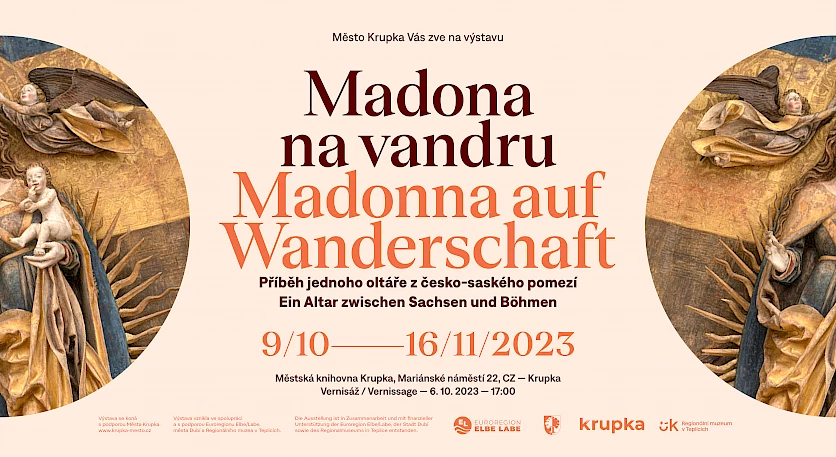
There is a beautiful view of the Madonou pochází pravděpodobně původně z Pirny av kostele ve Fürstenau se pak nacházel po mnoho desetiletí (spíše staletí). Poté, co byly poutě v Rakousku-Uhersku - a tedy iv Čechách - v 18. století za císaře Josefa II táři Madony do Fürstenau, tedy do Protestantského kostela v Sasku.
Když byl kostel ve Fürstenau v roce 1887 přestavěn, nezbylo již per oltář místo a byl přenesen do Předního Cínovce. Tam, jen pár metrů od hranic, per něj byla postavena kaple, která byla však po odsunu Němců po druhé světové válce zbořena.
Oltář se nakonec ocitl v Regionalálním muzeu v Teplicích, kde je k vidění dodnes.
(This is an automatic translation by Google Translator.)
Symbolic closure of the gap in Louka on Saturday

The resumption of railway operations from Holzhau to Moldava in the Czech Republic is still up in the air. But supporters of the rail connection continue to campaign undaunted to close this gap in cross-border traffic. On Saturday, September 30th , the 5th symbolic closure of the gap will take place at Louka u Litvínova (Meadow) train station. A variety of offers are on the program from 10 a.m. A special historical train also starts in Moldava at 10 a.m. After his arrival on October 11, the official program begins with railway and model railway technology, children's theater, live music and cuisine from Carpatho-Ukraine, the part that belonged to Czechoslovakia between 1918 and 1938.
The train station in Louka is an important junction of two railway lines. The route to Moldava meets the so-called “Goat Railway” (Kozí dráha) to Děčín (Tetschen), which is currently only used between Děčín and Telnice. The Ústí district is therefore planning to expand the train station into a tourist visitor center.
Regular trains to Moldava and back also run all day on Saturday. The special train starts the return journey after the end of the program at 21.05 (arrival in Moldava at 22.35). Tickets can be reserved by email info@erzgebirgs-zeitung.de . There is still a small contingent of tickets available. One trip costs 3 EUR.
Czech Railways increases prices
With the timetable change on December 10th, prices will rise at the Czech state railway České dráhy. As the company announced, prices will increase by an average of 9.5 percent. According to the railway, a ticket without a discount for a 45-kilometer route would then cost 101 crowns, instead of the previous 92. For 100 kilometers, the price increases from 188 to 205 crowns. However, travelers can extend the validity of the old prices for a while if they have bought their ticket by December 9th. Until then, tickets can be purchased up to two months in advance.
České dráhy regularly adjusts prices, most recently by 15 percent in December last year. As is the case today, the railways cited increased costs as the main reason. Conversely, the railway was able to record an increase in passenger numbers. After the corona pandemic, passengers returned to the railway. Passenger numbers rose by 6 percent to 79 million passengers in the first half of this year compared to the same period last year.
Former castle director moves to the presidential castle
Iveta Krupičková ran the castle in Děčín for 12 years and made it the most visited castle in the Ústí district. Above all, she managed the renovation and restoration of almost the entire castle and the castle gardens and managed to ensure that parts of the furnishings returned to the castle on at least a loan basis. But in 2019 the castle director was fired. The reasons were - as it quickly became clear - fictitious. Allegedly errors in economic management were the basis for the termination. Krupičková had always denied this. Police and prosecutors later confirmed that the allegations were completely unfounded. Apparently the city just wanted to get rid of the successful manager and replace her with someone she liked. Two years after the expulsion, the city issued a half-hearted apology.
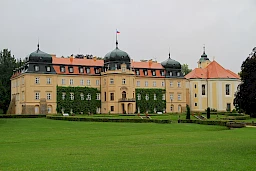
Now Krupičková could move to a particularly prestigious position. According to a report in the daily newspaper Děčínský deník, she will take over the management of the castle in Lany from October 1st. This information has not been officially confirmed. The castle in Central Bohemia serves as a country residence for the Czech presidents (and previously for the Czechoslovak ones). However, the presidents after 1990 used it very differently. While Václav Havel only stayed there occasionally, but took up the "Conversations from Lany" of his famous predecessor Tomáš G. Masaryk and published them on the radio, his successor Václav Klaus also avoided the castle. In turn, Miloš Zeman, who was seriously ill at the end, hardly showed up in Prague at all and stayed almost entirely in Lany. President Petr Pavel, who has been in office since the spring, has already announced that he does not want to use the castle for private or official purposes. If Ms. Krupičková takes over the management, the castle could also see a completely new use.
Voting for Czech Film Wednesday ends tomorrow
You still have the opportunity to vote for December's film at Czech Film Wednesday until tomorrow evening. There is currently a neck-and-neck race between two films. So your vote could be decisive.
To vote for your favorite film
Reminder: New newsletter from the Elbe/Labe Euroregion
A second time on our own behalf: So far we have only had one newsletter from the Elbe/Labe Euroregion. In the future, however, we will send out more information on different topics and are setting up several newsletter lists for this purpose.
So far we have mainly sent information about cultural events via the existing newsletter list, in the last few months especially about Czech Film Wednesday. There is now a new newsletter list that you must subscribe to in order to continue to receive information from us.
You can do this very easily by clicking on this link: Register for the cultural newsletter of the Euroregion Elbe/Labe
Furthermore, in the future we want to send a weekly overview of interesting events in the Czech Republic and the border region, from politics, society and everyday life. You are currently reading the first edition of this. This newsletter could be a good replacement, especially for those who sorely miss the “Look at the Neighbor” page in the SZ Dresden edition.
You can register directly by clicking on this link: Registration for the weekly newsletter of the Euroregion Elbe/Labe
We will only send the weekly review once again via this list. After that, it will only be used for the most important reports from the Euroregion and the border region, i.e. much less often. If you don't want to miss anything, please sign up for one of the other newsletters.
(This is an automatic translation by Google Translator.)
Příští týden je opět ten správný čas: 4.10. There are plenty of places in the world, and there is also a "Czech Film Festival" cycle at 8:00 p.m. in the Central Cinema Promítat českou Filmovou Klasiku. V říjnu je to film Příběhy obyčejného šílenství.
Příběh se točí kolem poněkud nenápadného Petra, který chce vlastně jen zpátky svou Janu, ale neustále se dost 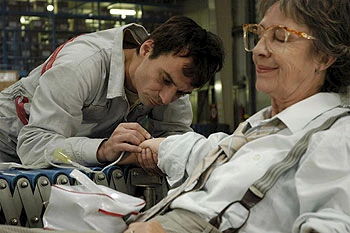 ává do absurdních situation a je obklopen bizarními lidmi: bláznivou matkou dárkyní krve, která chce zachránit svět, a jejím manželem, který zase zná nazpaměť socialistické zpravy ze 70. let, šéfem s italskou figurí nou, sousedy, u kterých nic nefunguje bez diváků v posteli , .... Díky svým vlastním sklonům k poněkud neobvyklým rozhodnutím však není zcela nevinný v mnoha propletencích, které vypadají jako každodenní šílenství.
ává do absurdních situation a je obklopen bizarními lidmi: bláznivou matkou dárkyní krve, která chce zachránit svět, a jejím manželem, který zase zná nazpaměť socialistické zpravy ze 70. let, šéfem s italskou figurí nou, sousedy, u kterých nic nefunguje bez diváků v posteli , .... Díky svým vlastním sklonům k poněkud neobvyklým rozhodnutím však není zcela nevinný v mnoha propletencích, které vypadají jako každodenní šílenství.
Ale (téměř) nikdo tu není doopravdy šílený, každý se jen po svém vyrovnává s životními nepřízněmi a příležitostmi. Celkově tak vzniká poměrně klidný a lakonický film s jemným, někdy až záhadným smyslem pro humor, but also to your českých komedií bývá. Proto je přece máme tak rádi, right?
PS: If you have any other names or a Czech film series, you will be able to see the results of the Euroregion Elbe/Labe region. Pokud byste chtěli být o Filmové středě a dalších akcích české kultury informováni iv budoucnu, je třeba se zaregistrovat k odběru new kulturního zpravodaje Euroregionu. Nejjednodušší způsob je sledovat tento odkaz: Registrace k odběru kulturního zpravodaje Euroregionu Elbe/Labe
(This is an automatic translation by Google Translator.)
Žatec is a world heritage site
The town of Žatec (Saaz) and the hop landscape around the town have been included in the UNESCO World Heritage List. The decision was made at the ongoing meeting of the World Heritage Commission in Riyadh, Saudi Arabia.
This is the first time that a hop-growing region has been added to the World Heritage List. UNESCO recognized the hop landscape, which has been intact for centuries, with the typical hop fields and functional buildings where the hops were processed on site. Specifically, it's about the hop landscape around Žatec and Stekník with the castle. The second complex recognized by UNESCO concerns parts of the historic center of Žatec, especially the Prague suburb, which was built at the end of the 19th century. The buildings intended for hop storage, production and trading still stand here today and hops are also stored, traded and shipped here to this day. Characteristic of the district are the high chimneys, 39 of which are still preserved today. The hops were preserved by sulfurization and the exhaust gases were discharged via the high food.
With the UNESCO World Heritage title, an almost 20-year process comes to an end. In 2018, the application had already made it to the World Heritage Commission. However, the application was recommended for revision again. The decision was supposed to have been made last year, but because of the Russian invasion of Ukraine, the planned world heritage in Kazan could not take place.
For the Czech Republic, Žatec and the hop landscape are already the 16th World Heritage Site. There is also a world natural heritage site in the Czech Republic with the beech forests of the Jizera Mountains.
Ústí district is recruiting doctors
The Ústí district is tackling the shortage of doctors. With a generous financial package, the district would like to encourage graduates to start working in the Ústí district after their medical studies. The new healthcare concept in the Ústí district expects up to 300,000 crowns (around 12,400 euros) in financial support for studies if the students commit to opening a practice in the district. An additional up to 800,000 crowns will be made available to equip the practice. In total, the district has provided around 60 million crowns (around 2.5 million euros) for the first phase of the scholarship program.
The district assumes that due to the increasing number of baby boomers retiring, there will be staff shortages for at least another five years before the measures that have now been decided take effect.
The Krajská zdravotní hospital network, which brings together several hospitals in the district, is already successfully using a similar scholarship program. According to the hospital association, sufficient staff have so far been found to fill vacancies through various measures, including financial measures.
Erzgebirge nature reserve in planning
What effects would a nature reserve (NSG) in the Erzgebirge have? The information campaign of the Czech State Agency for Nature and Landscape Protection is currently providing information about this. She is currently consulting the plans with the affected communities. So far, the agency representatives have already spoken to 25 of 69 municipalities in the Ústí and Karlovy Vary districts. The process is expected to be completed by the end of the year.
In the most strictly protected areas, fears of greater restrictions in life are naturally higher. “We want to achieve maximum agreement with the communities before the approval process begins,” says Environment Minister Petr Hladík. “So far, a correct exchange of opinions has prevailed,” says agency boss František Pelc, describing the atmosphere.
The establishment of a uniform protection status for the Erzgebirge has been planned for some time. So far, only individual nature reserves, natural monuments and Natura 2000 areas have been distributed as protected areas across the Ore Mountains. However, the new designation as a landscape protection area would only apply to the Czech part.
New newsletter from the Elbe/Labe Euroregion
So far we have only had one newsletter from the Elbe/Labe Euroregion. In the future, more information will be sent out on different topics.
Through this newsletter list (if you are currently reading an email: from which you receive this message) we have mainly sent information about cultural events , in the last few months especially Czech Film Wednesday. There is now a new newsletter list that you must subscribe to in order to continue to receive information from us.
You can do this very easily by clicking on this link: Register for the cultural newsletter of the Euroregion Elbe/Labe
Furthermore, in the future we want to send a weekly overview of interesting events in the Czech Republic and the border region, from politics, society and everyday life. You are currently reading the first edition of this. This newsletter could be a good replacement, especially for those who sorely miss the “Look at the Neighbor” page in the SZ Dresden edition.
You can register directly by clicking on this link: Registration for the weekly newsletter of the Euroregion Elbe/Labe
We will send the weekly review three times using this list. After that, it will only be used for the most important reports from the Euroregion and the border region, i.e. much less often. If you don't want to miss anything, please sign up for one of the other newsletters.
(This is an automatic translation by Google Translator.)
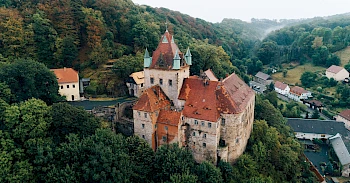
Kuckuckstein Castle in Liebstadt promises an experience for all the senses this weekend. Regional products such as vegetables, honey, chocolate, beer and wine, but also ceramics, textile art and live music await visitors. There are also petting goats and ponies for riding.
In addition to a tour of the castle, the current exhibition by the German-Austrian-Czech sculptor Jana Büttner and the painter Mirjam Jahn from Upper Bavaria can also be viewed.
Open on Saturday, 11 a.m. to 7 p.m. and Sunday 11 a.m. to 5 p.m., entry 7 euros.
(This is an automatic translation by Google Translator.)
 In the “Czech Film Wednesday” series, a film will be shown on December 6th that our viewers can choose. The vote is now underway!
In the “Czech Film Wednesday” series, a film will be shown on December 6th that our viewers can choose. The vote is now underway!
In the last few weeks we have received 15 film suggestions. We're really impressed by the range shown in terms of both age and character or genre. Almost all of the films are among the best works in Czech film history. We are very pleased with the good taste of our audience.
Now it's up to you to decide on the Santa Claus film! Voting is open until September 30th.
(This is an automatic translation by Google Translator.)
August 2023
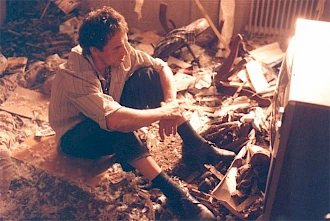
As on the first Wednesday of each month, we will be showing a Czech film classic in the "Czech Film Wednesday" series on August 2nd at 8 p.m. in the central cinema. This time the imaginative action comedy »Akumulátor 1« from 1994 is shown.
The film depicts the world behind the screen, where mirror beings live on our lives, feeding on leeching our energy while we watch television. This also applies to Olda (Petr Forman) after he was interviewed by television. dr Fišarek (Zdeněk Svěrák) supports him with many natural energies in the fight against his doppelganger. And a new found love helps him too. But he has to fight himself.
With this film in 1994, the two Svěráks created a work that falls a little outside the scope of their other work. There is more action and excitement here - albeit rather ironically than Hollywood blockbusters - and the technical possibilities that were new at the time were also clearly used. In view of the ubiquitous media consumption, the message is probably more relevant today than ever.
More about the film and tickets
(This is an automatic translation by Google Translator.)
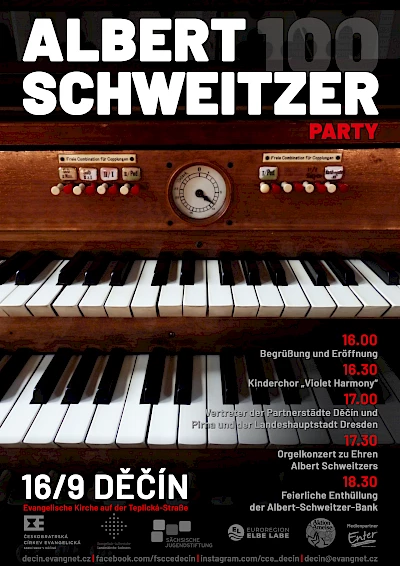 On January 15, 1923, Albert Schweitzer visited the Church of Christ in Tetschen (today Děčín). There he played a concert and reported on his work in Africa.
On January 15, 1923, Albert Schweitzer visited the Church of Christ in Tetschen (today Děčín). There he played a concert and reported on his work in Africa.
To mark the 100th anniversary of this event, the concert will now be repeated at the same venue on the same instrument. In addition, the choir "Violet Harmony" and soloists from the elementary school Kamenická will perform.
The Euroregion Elbe/Labe provides a shuttle bus from Dresden.
More about the event and
registration for the shuttle bus
The event is sponsored by the Evangelical Lutheran Church of Saxony/Children and Youth Education Office in Dresden, the Saxon Youth Foundation and the Evangelical Church of Bohemian Brethren in Děčín.
July 2023
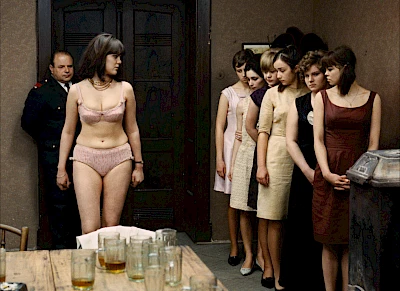
Like every first Wednesday of the month, on June 7th at 8 p.m. we will be showing a Czech film classic in the "Czech Film Wednesday" series in the central cinema. This time Miloš Forman's bitter satire »Hoří, má panenko« (The Firemen's Ball) from 1967 is shown.
A fire brigade ball in Vrchlabi turns into a complete fiasco: everyone lets themselves be mercilessly flooded and behaves accordingly. For a spontaneous beauty election, candidates must be "won" quickly. However, they are so reluctant that in the end an even more stupid solution is found. As the festival progresses, more and more of the raffle prizes disappear. Nobody here seems to have any qualms about helping themselves. At the peak there is a fire alarm...
In the run-up to the Prague Spring, Miloš Forman shot this evil satire of everyday life in his homeland. The idea came to him after attending a firemen's ball in Vrchlabí. The censors interpreted the film as a criticism of the system and banned it after three weeks. However, he went abroad, became internationally known and was even nominated for an Oscar in 1969.
More about the film and tickets
(This is an automatic translation by Google Translator.)
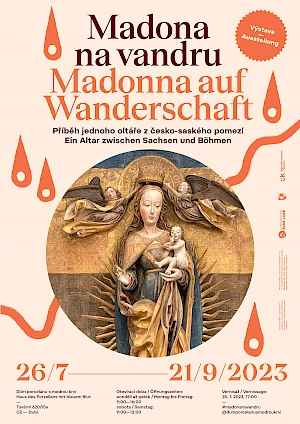 Pirna - Fürstenau - Vorderzinnwald - Hinterzinnwald - Teplice, these are the previous stations of a beautifully carved medieval Madonna altar, which - because it stayed there the longest - is also known as the Fürstenau Madonna altar.
Pirna - Fürstenau - Vorderzinnwald - Hinterzinnwald - Teplice, these are the previous stations of a beautifully carved medieval Madonna altar, which - because it stayed there the longest - is also known as the Fürstenau Madonna altar.
A new exhibition is now dedicated to the eventful history of this Madonna, who wandered between Saxony and Bohemia. This will be shown in Dubí from July 25, 2023 to September 21, 2023, after which it will set off on its own journey. In November and December it will be shown in Dresden, next year in Pirna and Lauenstein.
The station of the Madonna in Vorderzinnwald in its own chapel can be experienced virtually on site since last year. A modern smartphone or tablet is enough, and both the chapel and the Madonna altar appear to be back in their original place.
In the Fürstenau church you can see a glass replica of the Madonna statue, illuminated from the inside. This was also made last year.
(This is an automatic translation by Google Translator.)
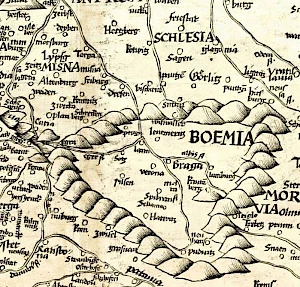
Some new copies of the popular atlas with historical maps of Bohemia, Saxony and above all the area of the Euroregion Elbe/Labe have reached us again from the bookbindery. They are available online, in a few points of sale and in our office in Dresden.
Unfortunately, the bookbindery was once again unable to produce all copies in perfect quality. We therefore offer those with small flaws as 2nd choice at a reduced price of 20 euros.
More about the historical atlas and ordering
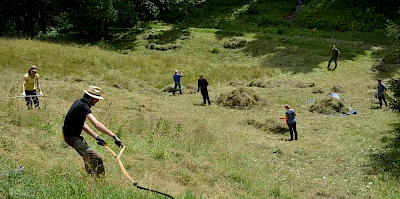
BUND Dresden and the Czech partner organization ČSOP Ophidia invite you to the 3rd German-Czech Care4Nature Camp:
From 14th to 20th August 2023 you can travel with us to the Ore Mountains for a week and have the opportunity to learn a lot about meadow care, to discover the species-rich mountain meadows and to get involved in nature conservation in a very practical way. Together with young adults from the Czech Republic and Germany, we tackle it and, with a lot of fun and energy, we are committed to preserving biodiversity in the Ore Mountains.
What awaits you?
A varied program awaits you: the focus is on tending the mountain meadows with a scythe. Never sen? No problem: we have a scythe instructor who will support us with the traditional hand mowing. Practice all the steps of making hay and try out other biotope care measures. There are also technical contributions and excursions, and the beautiful mine grounds and their immediate surroundings are also explored every year. You can also look forward to a trip to the organic farm. There we will make cheese ourselves and enjoy delicious food. We end the evenings with games or spending time together around the campfire. Do you want to be there? Then register now until 15.07. at! We look forward to you!
Where does the camp take place?
The camp takes place on the German-Czech border in the Ore Mountains. We find accommodation in an apartment house on the German-Czech border near Oberwiesenthal. On our daily way to the care areas, we walk through the beautiful mine grounds with giant ferns and rare plants such as arnica, blue tarantula, fire lily and gaping monkshood. There is also time to snack on raspberries and blueberries along the way and to jump into the cool water on the way back.
The area has a long and interesting history - where mountain farmers used to graze their cattle, valuable meadows and moors were created, which have a high natural value as a cultural landscape due to their former use and are home to rare species.
The project is funded by:
the German-Czech future fund and the Tandem D-CZ coordination center.
Who's in?
The Care4Nature Camp is aimed at young adults aged 16 to 26 from Germany and the Czech Republic. The number of participants is limited to 20 people. So register quickly and be there!
How much does that cost you?
This adventure costs you nothing! Participation in the camp, including travel expenses, accommodation and meals, is free of charge.
Further information and the registration form can be found on the website: https://www.bund-dresden.de/was-wir-tun/care4nature-camp/ .
(This is an automatic translation by Google Translator.)
June 2023
As the mayor of Budyně nad Ohří for many years, Mr. Petr Medáček was the deputy chairman of the Association of Municipalities of the Labe Euroregion (Czech side of the Elbe/Labe Euroregion). The Council of the Euroregion Labe honored his many years of work in the field of Czech-Saxon cross-border cooperation and would like to use his experience in the next funding period.
(This is an automatic translation by Google Translator.)
The train Wanderexpress Bohemica runs from April to October on weekends and public holidays between Dresden and Litoměřice (Leitmeritz), the Letní kometa (also known as Vánocní kometa during the Christmas season) between Ústí nad Labem and Dresden, each morning one way and back in the afternoon. Both are important connections for weekend getaways.
The corresponding contracts expire in December. According to a report in the newspaper Dresdner Neuste Nachrichten today, however, both sides have committed to continuing the offer to the same extent over the next few years. In view of rising costs, this is not a matter of course.
In the medium term (i.e. after 2025), the Ústecký kraj is aiming for an additional connection by extending an express train from Prague via Ústí n.L. to Dresden. However, the necessary financing is still open, as is the available capacity in the Elbe valley.
Source: Dresdner Neuste Nachrichten from June 20th, 2023, p. 16 (also online )
May 2023
On a run-down railway site in Ostrava, two boys find a corpse prepared like a hunting trophy. The police investigations lead into all social strata of the city, into high political circles and into nouveau riche entrepreneurs, into prostitutes and into broken families. The author skilfully links a murder case in the present with a German-Jewish family history that goes back many decades and shows how easily a person can fall victim to anger, history and a suppressed past. A social panorama as an excursion into the hell of the present.
Nela Rywiková, born in Ostrava in 1979, is one of the most interesting new names in Czech crime fiction, which is experiencing a kind of renaissance. Her debut novel Dům číslo 6 (House Number 6) was published in 2013.
Cooperation between: Czech Literature Center (Moravian State Library), Czech Center Berlin, Salon of German-Czech Dialogue, Staatsschauspiel Dresden and the Department for European and International Affairs of the state capital Dresden. Under the patronage of the Consul General of the Czech Republic in Dresden.
(This is an automatic translation by Google Translator.)
The Ostsächsische Sparkasse Dresden has been providing financial support to the municipal community Euroregion OE/OE eV (German side of the Euroregion Elbe/Labe) for many years. Today, at the meeting of the working committee, the new sponsorship contract for the next two years was approved by Heiko Lachmann, board member of the Ostsächsische Sparkasse Dresden, Dirk Hilbert (Mayor of the state capital Dresden and President of the KG Euroregion), and Daniel Brade (Mayor of the city of Hohnstein and Vice President of the KG Euroregion) signed. We sincerely thank the Ostsächsische Sparkasse Dresden for continuing this long-term support.
(This is an automatic translation by Google Translator.)
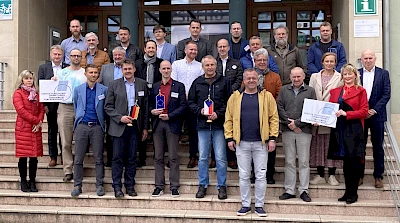
On Thursday, April 27, 2023, the first cross-border conference of mayors in the Schluckenau tip took place in Krasna Lipa. This was brought to life by the economic initiative Saxon Switzerland eV and the mayors' association Sever from the Schluckenauer corner.
The following 12 cities (mayors) took part from the Czech side: Dolni Poustevna, Jirikov, Krasna Lipa, Lipova, Lobendava, Mikulasovice, Rumburk, Stare Krecany, Sluknov, Velky Senov, Vilemov and Varndorf.
From the German side took part: Bad Schandau, Sebnitz, Neustadt, Hohnstein, Sohland an der Spree and Großschönau.
The aim of the meeting was to get to know, introduce and network the German and Czech communities. As a result, there should be concrete cross-border projects and joint activities.
Guests at this conference were Jan Šmid and Jirí Rak (České Švycarsko ops), Mgr Ondrej Havliček (Euroregion Neiße), Rüdiger Kubsch (Euroregion Elbe/Labe), Senator Zbynek Linhart and Jan Kvapil (German-Czech Future Fund).
The conference was moderated in two languages by Martina Böhme and Irena Kubicova.
Finally, the chairman of the economic initiative Saxon Switzerland and mayor of the city of Hohnstein, Mr. Daniel Brade, invited to a second cross-border conference of mayors in Hohnstein in autumn.
This event was kindly funded by the German-Czech Future Fund.
(This is an automatic translation by Google Translator.)
V souladu se stanovami DSO EL zvolila Rada EL na svém prvním řádném zasedání po volebním Sněmu EL z konce roku 2022.
Staronovým předsedou byl zvolen primátor most Ústí nad Labem pan Petr Nedvědický. Prvním místopředsedou EL zůstává primátor města Děčín pan Jiří Anděl. Druhou místopředsedkyní je starostka města Bílina paní Zuzana Schwarz-Bařtipánová.
Funkční předsednictva období je čtyřleté
(This is an automatic translation by Google Translator.)
April 2023
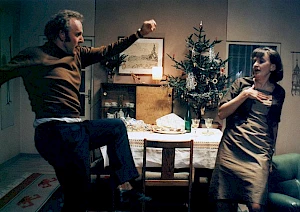
With gentle poetry and humorous exaggeration, the life of three generations of men and women in a special period of Czech history in 1968 is told...
The Šebek and Kraus families are neighbors in a two-story villa in Prague. Father Šebek is an officer and a loyal party soldier, but basically a simple, good-natured man. He praises the virtues of communism and the advances of the Eastern Bloc. Unbreakable plastic glasses from the GDR play an important role as proof of the superiority of communism.
The Kraus family above him maintains a middle-class lifestyle in which art and culture as well as old traditions play a major role. Father Kraus, a former resistance fighter against the Nazis and a staunch anti-communist, not only despises his neighbor's political attitude, but also looks down on his lack of culture. The two, who are also convinced - also in their families - that they are fundamentally right, regularly clash.
Your children, on the other hand, get along well. Michal Šebek is in love with his neighbor, but she has her eyes on someone else. Various visits, drinking bouts, a Christmas party and a funeral bring both families together again and again, resulting in a firework of subtle humor. For young people, the attractions of the capitalist world contrast with the aforementioned unbreakable plastic glasses from the socialist brothers from the GDR. The invasion of Warsaw Pact troops ultimately marks a deep turning point.
(This is an automatic translation by Google Translator.)
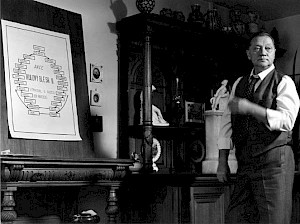 The film "Kulový blesk" is about the biggest maneuver in the history of moving: an apartment ring exchange with 12 parties involved. Everyone has to move on the same day, everything has to work, otherwise the chain will fall apart. dr Radosta is an experienced organizer of such actions, but there has never been a 12-ring exchange. This is world-class moving! And it's like watching for fleas. There is always someone wanting to change something, wanting to get an advantage, or has changed their mind and prefers not to move. Some get divorced, others have to marry quickly beforehand. dr Radosta and Knotek, his semi-voluntary assistant, have their hands full. And when it starts, of course, everything gets much worse.
The film "Kulový blesk" is about the biggest maneuver in the history of moving: an apartment ring exchange with 12 parties involved. Everyone has to move on the same day, everything has to work, otherwise the chain will fall apart. dr Radosta is an experienced organizer of such actions, but there has never been a 12-ring exchange. This is world-class moving! And it's like watching for fleas. There is always someone wanting to change something, wanting to get an advantage, or has changed their mind and prefers not to move. Some get divorced, others have to marry quickly beforehand. dr Radosta and Knotek, his semi-voluntary assistant, have their hands full. And when it starts, of course, everything gets much worse.
More about the film and Czech Film Wednesday
(This is an automatic translation by Google Translator.)
March 2023
Chcete strávit odpoledne objevováním nového, posloucháním neznámého a opětovným poznáváním starých známých sbírek a světoznámých pokladů. Ukázky historických experimentů, otevřené ateliéry a dílny nebo vypravěči zvou ke strávení inspirationalního odpoledne s rodinami a přáteli všech věkových kategorií.
Aktuální termíny
No 26.03. 15:30 - Neděle v muzeu - neděle od tří hodin - vstup zdarma:
Kennel - Matematicko-fyzikální salon
per deti a rodiny
No 02.04. 15:30
Draci jsou volni. Vzhůru do sbírky porcelánu s vypravěčem!
Kennel - sbírka porcelánu
per deti a rodiny
No 16.04. 15:00
Neděle v muzeu: od tří hodin vstup zdarma!
Albertinum - Albertinum
No 23.04. 15:30
Neděle v muzeu - neděle od tří hodin - vstup zdarma:
Kennel - Matematicko-fyzikální salon
per deti a rodiny
No 07.05. 15:30
Draci jsou volni. Vzhůru do sbírky porcelánu s vypravěčem!
Kennel - sbírka porcelánu
per deti a rodiny
No 21.05. 15:00
Neděle v muzeu: od tří hodin vstup zdarma! Otevřený studio per male i velké
Albertinum - Albertinum
(This is an automatic translation by Google Translator.)
Předsedou Asociace Euroregionů ČR se stal do konce roku 2023 zástupce Euroregionu Šumava Libor Picek a tajemníkem Ondřej Havlíček, výkonný ředitel Euroregionu Nisa.
Akce se konala pod záštitou vicepremiera a ministra per místní rozvoj Ivana Bartoše. Stanovy i orgány spolku odsouhlasilo všech 13 subjectů, které se aktivně hlásí ke spolupráci Euroregionů na všech 5 hranicích, kde se realizují přeshraniční aktivity. Jde o česko-rakouskou, česko-slovenskou, česko-polskou, česko-saskou and česko-bavorskou hranici. Ve všech těchto příhraničních regionech bude fungovat Program Interreg 2021 - 2027, a Euroregiony budou vykonávat funkci administrátorů Fondů malých projektů. 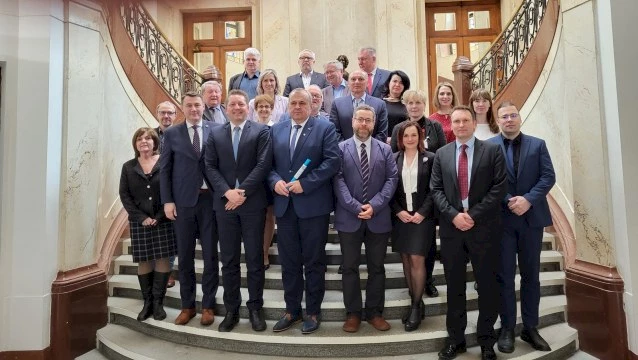
MMR, podle slov náměstka ministra Sršně, podporuje činnost Euroregionů a hodlá pomoct rovněž formou dotací na aktivity Asociace. Očekává taktéž podněty z euroregionů na zlepšení hospodářské a social situation v periferních oblastech. Na jednání zazněly hlasy na ustanovení či opětovné nastartování fungování mezivládních komisí pro přeshraniční oblasti, kde je nutné urychlit proces řešení takových otázek jako přeshraniční doprava, fungování IZS přes hranici, udržení vody v krajině v kontextu klimatických změn, efektivní spolupráce nemocnic a zdravotnických složek ve prospěch pacientů v pohraničních oblastech apod. Asociace jako den z nových členů Národní stálé konference bude usilovat o prezentaci aktivit spolku i jednotlivých členů už na nejbližším jednání NSK začátkem dubna 2023 v Plzni.
Za Euroregion Labe se jednání zúčastnili místopředseda Euroregionu Labe a primátor města Děčín pan Jiří Anděl a ředitel Euroregionu Labe Vladimír Lipský.
(This is an automatic translation by Google Translator.)
February 2023
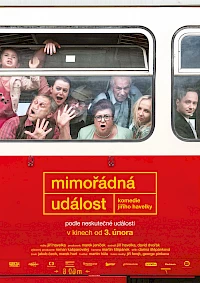 On March 1st we will start the film series "Czech Film Wednesday" in the Dresden Central Cinema, in which we will show an original Czech film with subtitles on every 1st Wednesday of the month at 8 p.m.
On March 1st we will start the film series "Czech Film Wednesday" in the Dresden Central Cinema, in which we will show an original Czech film with subtitles on every 1st Wednesday of the month at 8 p.m.
The film "Mimořádná událost" (Exceptional Situation) was a great success at the Czech-German Culture Days, with sold-out screens and many people asking us when we would be showing it again. That's why we start the film series with this absurd comedy.
(This is an automatic translation by Google Translator.)
There are small project funds (SPF) in all four Saxon-Czech Euroregions. They aim to bring people on both sides of the border closer to one another by promoting suitable projects. Unfortunately, applications will probably be possible from this summer. However, all project sponsors can look forward to significant simplifications in the processes.
The SAB has compiled initial information on the SPF: Presentation of the Small Projects Fund (PDF, 1MB) .
K celoročnímu zapojení do tohoto programu se hledají nadšenci a machři (ž/m) z česko-německých příhraničních regionů na období trvání programu od 1. 5. 2023 do 30. 4. 2024
Po celý rok budete součástí tohoto programu a budete with dostatek prostoru per creativení a nezávislý přístup. Activity probíhají ve výměně s ostatními účastníky programu as pracovníky Česko-německého fondu budoucnosti.
Časová náročnost účasti v programu odpovídá zhruba 2 and 3 dnům týdně. Česko-německý fond budoucnosti (nadační fond) podpoří Vaší účast na tomto programu formou grantu.
Veškéré informace naleznete zde
(This is an automatic translation by Google Translator.)
In the X-Dörfer project, the Staatsschauspiel Dresden supports a wide range of cultural projects in rural areas. In addition to financial support, the content-related support provided by theater professionals is particularly important.
For projects after the summer of 2023, the small project fund of the Euroregion Elbe/Labe can be used as a supplement to organize such projects across borders. The offices of the Euroregion will be happy to advise you (see Contact ).
TENDER
The Staatsschauspiel Dresden is looking for people of all ages who are interested in culture and want to jointly invent and implement cultural projects in rural areas. The aim of the initiative is to initiate and support sustainable impulses for a culture of togetherness.
Concerts in the barn, landscape theater projects, writing festivals for everyone, culture cafés, history workshops, cinema in the hairdresser's salon and much more. develop. Cultural institutions, associations, civic initiatives, cultural workers or lay people of all ages interested in culture from Saxon communities with up to 40,000 inhabitants that are no further than 60 km away from Dresden can apply.
In the application, a rough idea or a question should be outlined. It is important that no single person applies, but that it becomes apparent that several people are interested in the idea and want to get involved.
If your application is selected, the X-Dörfer project management will come to your location to develop the idea further together and to find out where the project needs support. Do you still need a brilliant idea, more committed fellow campaigners from the village or neighboring communities, an organizational structure, cooperation partners or professional artists from outside? Ultimately, the idea is to be implemented on site by those involved with the support of the X-Dörfer project management.
The project period is 2023 and/or 2024.
THE PROJECT PROVIDES AS REQUIRED:
- Advice on brainstorming
- Organizational support
- Fees for artists who live locally or who are invited from outside.
- possibly travel and accommodation costs
- Material costs for the project
- Public relations support
- if the project is successfully completed, assistance with applications for funding for the following year
APPLICATION REQUIREMENTS:
- First idea
- Short letter of motivation
- Brief self-portrayal
- Approximate time table
- Who else could you include?
The application should not comprise more than one or two A4 pages in total.
APPLICATION EXPLANATIONS:
After a pre-selection of the applications received, one or two exchange meetings take place on site. A final decision is then made as to whether cooperation is in the interest of all parties involved.
If the application is a barrier and if you have any questions, the project team Miriam Tscholl and Claudia Leutemann can be reached at xdoerferstaatsschauspiel-dresden.de. We are also happy to advise you in an online meeting or telephone call.
Deadline:
You can apply now, but no later than March 15, 2023
(This is an automatic translation by Google Translator.)
Since this year, the State Office for Early Education in the Neighbor Language has offered “čaj & kawa with the LaNa”, an open advisory service on education in the neighboring language in Czech and Polish.
From now on you can meet the LaNa staff online every 1st Tuesday of the month between 1:00 p.m. and 2:00 p.m. and discuss your questions and topics relating to education in the neighboring language with them.
These are the upcoming dates:
- February 7th
- March 7th
- April 4th
- May 2nd
- 06 June
How to take part in "čaj & kawa with LaNa": The events take place via the GoToConnect video conference module. Registration is not necessary: simply open the access link, enter the virtual room and bring your favorite drink and your conversation needs.
You can find more information and the access link to this advisory service at www.nachbarsprachen-sachsen.eu/caj-und-kawa.
(This is an automatic translation by Google Translator.)
The second round of presidential elections in the Czech Republic took place on January 27-28, 2023. The candidates who emerged from the first round were Petr Pavel and Andrej Babiš.
Petr Pavel won and became President of the Czech Republic with 58.32% of the vote. Andrej Babiš received 958,655 fewer votes, ie 41.67% of the votes.
Election results in the Ústí district:
Petr Pavel - 45.53%.
Andrei Babis - 54.47%.
Election results by district
Decin :
Petr Pavel - 49.75%.
Andrei Babis - 50.25%
Usti nad Labem:
Petr Pavel - 44.75%
Andrei Babis - 55.25%.
Teplice :
Petr Pavel - 43.15%
Andrei Babis - 56.85%.
Litomerice :
Petr Pavel - 53.32%.
Andrei Babis - 46.6%
Overview of the results at idnes.cz (Czech)
(This is an automatic translation by Google Translator.)
January 2023
At its meeting on December 22, 2022, the general meeting of the municipal community Euroregion OE/OE eV (i.e. the German side of the Euroregion Elbe/Labe) decided to admit the large district town of Sebnitz as a member.
We are very happy about this step and warmly welcome the city of Sebnitz in our midst.
(This is an automatic translation by Google Translator.)
December 2022
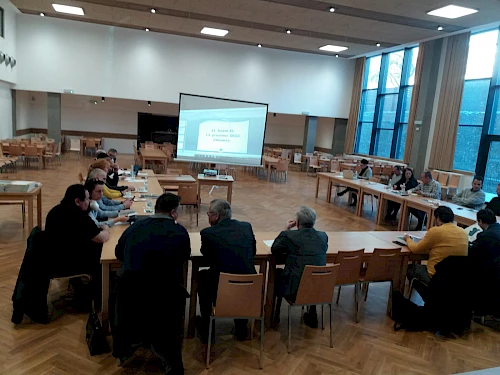 Due to the local elections in the Czech Republic in September 2022, the 33rd General Assembly of the Euroregion Labe was held on an unusual date.
Due to the local elections in the Czech Republic in September 2022, the 33rd General Assembly of the Euroregion Labe was held on an unusual date.
The main point of the meeting was the election of new organs of the Association of Municipalities. An equally important point during the deliberations of the meeting were the issues related to the launch of the Czech-Saxon Interreg program and the Small Projects Fund 2021-2027.
(This is an automatic translation by Google Translator.)
November 2022
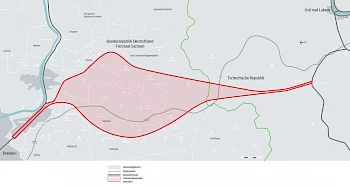
Planning for the high-speed railway line between Dresden and Prague is progressing. There are now three proposed variants of the Deutsche Bahn, two completely in the tunnel and one with an above-ground section. The picture shows the examination area for the three variants. You can already get a lot of information at neubaustrecke-dresden-prag.de .
From November 24th, 2022, Deutsche Bahn will provide detailed information about the plans and the different variants at a so-called information market.
On November 30th, 2022, an online public dialogue will take place, in which questions can be asked which - if possible - will be answered directly.
To the information market of Deutsche Bahn
(This is an automatic translation by Google Translator.)
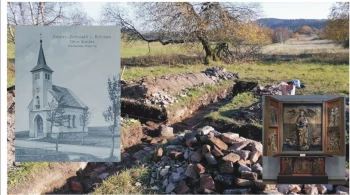 The relatively young chapel, built in 1887, was demolished in the 1950s in connection with the establishment of the border strip. Crowds of pilgrims used to come here on the feast of the Visitation until World War II, and efforts are being made to restore this tradition today.
The relatively young chapel, built in 1887, was demolished in the 1950s in connection with the establishment of the border strip. Crowds of pilgrims used to come here on the feast of the Visitation until World War II, and efforts are being made to restore this tradition today.
The archaeological investigations were carried out in October and November of this year by the regional museum in Teplitz (Teplice) in cooperation with the nature conservation station in the Eastern Ore Mountains from Altenberg and funded by the Federal Agency for Political Education.
At the end of the event, the uncovered excavations will be filled up again together. Visitors have the unique opportunity to see the finds "in situ".
The event takes place in any weather!
Arrival by public transport: With bus 360 at 11:42 a.m. from Dresden main station via Dippoldiswalde and Altenberg to Zinnwald Wendeplatz (arrival 12:52 p.m., walk to the chapel approx. 4 km on the road) or České Pomezi (arrival 12:55 p.m o'clock, footpath to the chapel approx. 4 km through the forest).
Danger! The road Cinovec - Fojtovice is not cleared in winter! On-site parking is not permitted for security reasons.
Contact for more information: jankvapil@post.cz, tel. +420 732 921 250 & +49 157 52 611 600.
(This is an automatic translation by Google Translator.)
Benno Benešovi se za totality aktivně podílel tajných salesiánských aktivitách per mládež, po revoluci stál za vznikem salesiánského nakladatelství Portál, social-teologické školy Jabok či salesianských misií v Bulharsku.
Od roku 2003 působil v Teplicích, kde léta vedl místní salesianskou komunitu a zanechal zde po sobě nesmazatelnou stopu; již od počátku 90. let dbal na rozvoj zdejšího salesiánského díla, které by bez něj nemělo zdaleka takové zázemí a nepomohlo tolika obyvatelům našeho mesta. Notně se věnoval nápravě pošramocených vztahů mezi Němci a Čechy – pocházel z česko-německé rodiny av mládí na vlastní kůži zakusil plody nacionalismem motivované nenávisti. Za tuto činnost získal v roce 2015 Zlatou holubici míru – putovní ocenění, kterým se mohl pyšnit např. Václav Havelči XIV. dalajláma.

(This is an automatic translation by Google Translator.)
You are cordially invited to the opening of the exhibition by Prague graphic artist Šimon Brejcha entitled Tissues.
Date: Friday, November 18, 2022 at 8 p.m
Location: Kunsthaus Raskolnikov , Böhmische Str. 34, Dresden
Introduction: Veronika Krülle Kotoučová / Euroregion Elbe/Labe, Eva Bendová / curator
*
OPEN AIR from 8:30 p.m.: Light-sound collage "Hillumination" by Andrea Hilger & Hartmut Dorschner
House facade at the corner of Böhmische Str./Salinger Weg
*
In cooperation and with the friendly support of the Euroregion Elbe/Labe, in the frame" stays curious Dresden City of Culture 2022.
Duration of the exhibition: until January 20, 2023
(This is an automatic translation by Google Translator.)
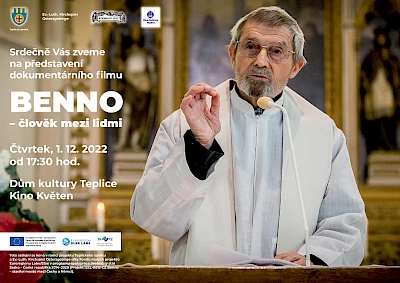 During the totalitarian regime, Benno Beneš was actively involved in secret Salesian activities for young people, after reunification he was behind the founding of the Salesian publishing house Portal, the social-theological school Jabok and the Salesian missions in Bulgaria.
During the totalitarian regime, Benno Beneš was actively involved in secret Salesian activities for young people, after reunification he was behind the founding of the Salesian publishing house Portal, the social-theological school Jabok and the Salesian missions in Bulgaria.
He has been active in Teplice since 2003, where he has been leading the local Salesian community for years and has had a significant impact on it; since the early 1990's he has been involved in the development of the local Salesian ministry which without him would not have nearly the same background and could not serve as many people in the city. He was very active in restoring damaged relations between Germans and Czechs. Coming from a Czech-German family, he experienced the consequences of nationalist hatred in his youth. In 2015 he was awarded the Golden Dove of Peace for his work.
On Thursday, December 1st, 2022 at 5.30 p.m. the premiere of the biographical film "Benno - a man among us" about the Salesian Benno Beneš from Osek will take place in the Teplice House of Culture in the Květen cinema.
(This is an automatic translation by Google Translator.)
what's new
1 Schmilka winter village – the special winter break
2 LEADER excursion 2022
3 Climate protection and digitization as topics for the future of national natural landscapes
4 Learning from the fire
5 We build for you in the Swedish holes.
6 SBB is building a new extinguishing water cistern at the Saupsdorfer Hütte
7 A little closer to the wilderness in the Saxon Switzerland National Park
8 Sautanz in Mockethal
9 The "Goldene Henne" for a hot job
10 Sensational donation result after an unforgettable football experience
11 Successful start to the Pirna 800 planting campaign
12 No hibernation for the Saxon Steamship Company
13 recipe of the month
Source: Joint initiative by the state enterprise Sachsenforst National Park Administration Saxon Switzerland and association Landschaf(f)t Zukunft e. V
(This is an automatic translation by Google Translator.)
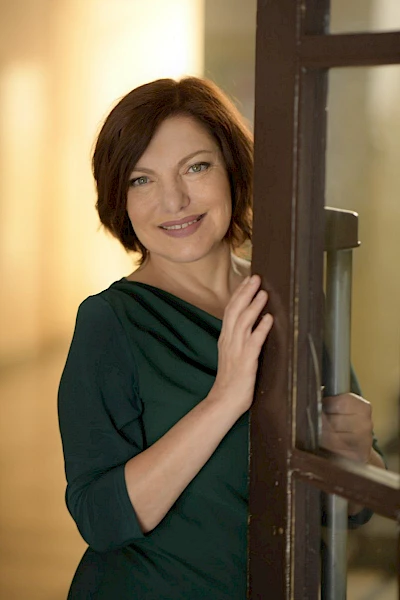
A Moravian town 1954: Mira defies her parents and goes ice-skating. She is punished with not getting a cupcake, but this event changes her life forever. Tragedy binds her to her taciturn, oddball Aunt Hana, and the two must learn to live together. Gradually, the story of her Jewish ancestors is revealed and Mira learns to understand why her aunt finds it so difficult to find her way in life.
Three generations of family history in the 20th century. Two skilfully interwoven time levels and destinies in cruel times. In addition to the suffering they have endured, two women also have to deal with the question of guilt when their own actions cause suffering to others, consciously or unconsciously. And how do you bear to be the only one to survive.
The story, based on true events, is written at a gripping pace, dramatic like a movie. Alena Mornštajnová's multi-award-winning novel has been translated into more than a dozen languages and is a bestseller in the Czech Republic.
Alena Mornštajnová, born 1963, is a Czech writer and translator. She wrote four novels and a children's book. Alena Mornštajnová studied English and Czech at the University of Ostrava. She made her debut in 2013 with the novel Slepá mapa (Blind Map) and in 2015 her second novel Hotýlek (The Little Hotel). Mainly because of her third novel, Hana, Alena Mornštajnová has been one of the most popular contemporary Czech writers since 2017. Her novel Hana was awarded the Czech Book Prize 2018, among others, and was named Book of the Year 2017 on the Databáze knih (Database of Books) website.
Location: Klemperer Hall (1st floor)
Admission free
A cooperation of: Euroregion Elbe/Labe, Municipal Libraries Dresden, SLUB, Czech Center Berlin and Czech Literature Center (ČLC). Under the patronage of the Consul General of the Czech Republic in Dresden JUDr. Marketa Meissnerova.
October 2022
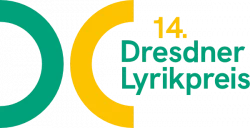 Der Dresdner Lyrikpreis wird zur Förderung des gegenwärtigen poetischen Schaffens durch den Oberbürgermeister der Landeshauptstadt Dresden ausgelobt und alle zwei Jahre vergeben, in diesem Jahr bereits zum 14. Mal. Teilnehmen können Bewerber*innen, die in Europa leben und in deutscher oder tschechischer Sprache schreiben. Die Jury ist jeweils mit tschechischen und deutschsprachigen Mitgliedern besetzt.
Der Dresdner Lyrikpreis wird zur Förderung des gegenwärtigen poetischen Schaffens durch den Oberbürgermeister der Landeshauptstadt Dresden ausgelobt und alle zwei Jahre vergeben, in diesem Jahr bereits zum 14. Mal. Teilnehmen können Bewerber*innen, die in Europa leben und in deutscher oder tschechischer Sprache schreiben. Die Jury ist jeweils mit tschechischen und deutschsprachigen Mitgliedern besetzt.
Gewinner des diesjährigen Wettbewerbs ist Pavel Novotný.
Den zusätzlich vergebenen Publikumspreis stiftet die Euroregion Elbe/Labe. In den Wochen vor der Preisverleihung können die Beiträge der Finalist*innen online angeschaut und anschließend ebenfalls online abgestimmt werden. Daraus ging Paul Henry Campbell als Sieger hervor. Den entsprechenden Beitrag können Sie hier anschauen.
Mehr dazu erfahren Sie unter www.dresdner-lyrikpreis.org.
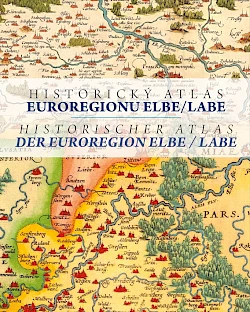
Historically, there are very close relations between Saxony and Bohemia. This can also be seen on old maps. For this reason, the Euroregion Elbe/Labe has published an atlas with historical maps of Bohemia and Saxony with a special focus on the territory of today's Euroregion.
There are 62 maps on 128 pages. The oldest is from 1280, the most recent are tourist maps from 1930. Explanations in German and Czech are included for all maps and various cartographic and historical topics (see below for table of contents). Thanks to the large format (38 cm by 31 cm) and high quality printing, many details are visible. Some special features are highlighted again in enlargements.
The atlas is now available at the Euroregion office in Dresden as well as in some bookshops in the region at a price of 30 Euro. For a shipping fee of 5 Euro and against prepayment we will also gladly send it to you. If you want to get an idea beforehand, you can download the atlas as PDF (Attention: 55 MB).
 The creation of the atlas was supported with funds from the European Union from the Small Projects Fund in the Elbe/Labe Euroregion.
The creation of the atlas was supported with funds from the European Union from the Small Projects Fund in the Elbe/Labe Euroregion.
Benno Benešovi se za totality aktivně podílel tajných salesiánských aktivitách per mládež, po revoluci stál za vznikem salesiánského nakladatelství Portál, social-teologické školy Jabok či salesianských misií v Bulharsku.
Od roku 2003 působil v Teplicích, kde léta vedl místní salesianskou komunitu a zanechal zde po sobě nesmazatelnou stopu; již od počátku 90. let dbal na rozvoj zdejšího salesiánského díla, které by bez něj nemělo zdaleka takové zázemí a nepomohlo tolika obyvatelům našeho mesta. Notně se věnoval nápravě pošramocených vztahů mezi Němci a Čechy – pocházel z česko-německé rodiny av mládí na vlastní kůži zakusil plody nacionalismem motivované nenávisti. Za tuto činnost získal v roce 2015 Zlatou holubici míru – putovní ocenění, kterým se mohl pyšnit např. Václav Havelči XIV. dalajláma.

(This is an automatic translation by Google Translator.)
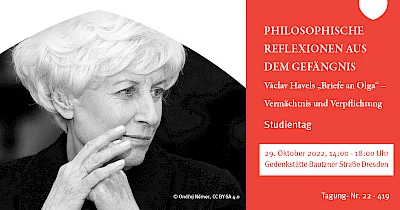 The later Czech President Václav Havel wrote exactly 165 letters to his wife Olga during the almost five years he spent in prison. These letters were not mere correspondence. Václav Havel's letters represent a legacy of European intellectual history. They are letters out of love and in a philosophical search for horizons and truth for a free society.
The later Czech President Václav Havel wrote exactly 165 letters to his wife Olga during the almost five years he spent in prison. These letters were not mere correspondence. Václav Havel's letters represent a legacy of European intellectual history. They are letters out of love and in a philosophical search for horizons and truth for a free society.
The event will take place at the Bautzner Strasse Memorial, Bautzner Strasse 112a, 01099 Dresden, from 2:00 p.m. to 6:00 p.m.
More information and registration at: https://ea-sachsen.de/veranstaltungen/philosophische-reflexionen-aus-dem-gefaengnis/
Source and photo:
Evangelical Academy of Saxony
in the Dreikönigsforum Dresden
(This is an automatic translation by Google Translator.)
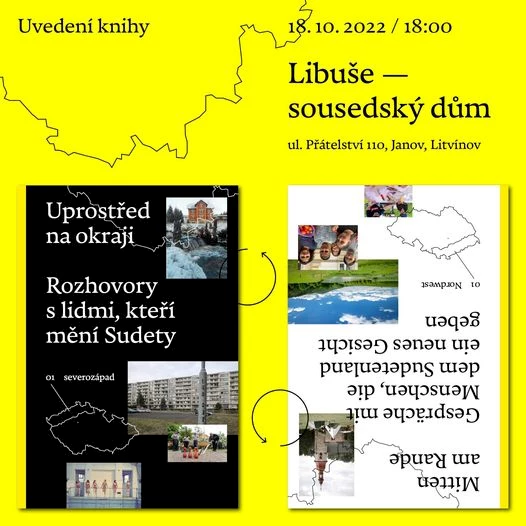 The main project result is the Czech-German publication Mitten am Rande, interviews with people who are changing the Sudetenland. The book offers 13 interviews with people who are actively contributing to a changed view of the Czech-Saxon border area.
The main project result is the Czech-German publication Mitten am Rande, interviews with people who are changing the Sudetenland. The book offers 13 interviews with people who are actively contributing to a changed view of the Czech-Saxon border area.
As part of the project, short medallions of five personalities who appear in the book were filmed. There are:
Jitka Pollakis from Erzgebirge,
Erich Vodňanský from Strann near Bleiswedel,
Alice Janstová from Jelení ,
Petr Globočník from Litvínov,
Jarmila Ptáčková Gross Schönau.

(This is an automatic translation by Google Translator.)
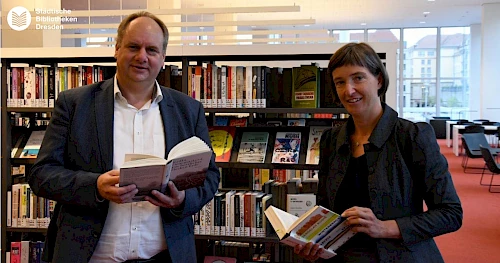
From now on, users of the Dresden libraries can also borrow Czech books in their original language. Of the 63 titles available so far, around half were handed over today as a donation from the Euroregion Elbe/Labe by the President of the Euroregion and Mayor Dirk Hilbert from Dresden. They now find themselves on their own Czech shelf. We intend to fill this up even further.
(This is an automatic translation by Google Translator.)
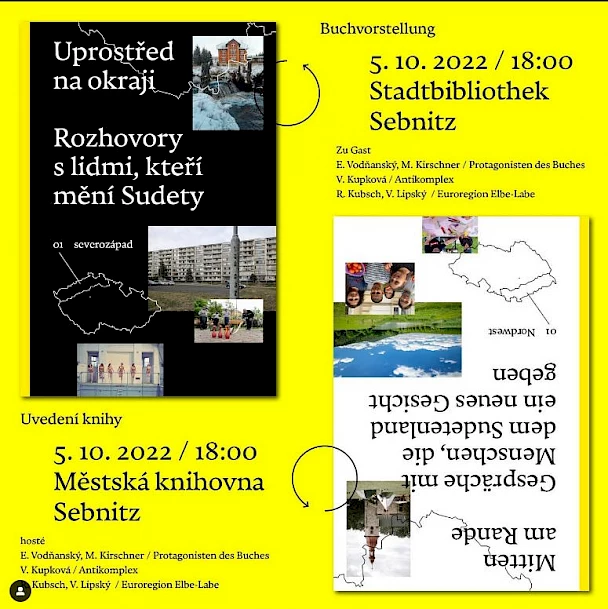 The main project result is the Czech-German publication Mitten am Rande, interviews with people who are changing the Sudetenland. The book offers 13 interviews with people who are actively contributing to a changed view of the Czech-Saxon border area.
The main project result is the Czech-German publication Mitten am Rande, interviews with people who are changing the Sudetenland. The book offers 13 interviews with people who are actively contributing to a changed view of the Czech-Saxon border area.
As part of the project, short medallions of five personalities who appear in the book were filmed. There are:
Jitka Pollakis from Erzgebirge,
Erich Vodňanský from Strann near Bleiswedel,
Alice Janstová from Jelení ,
Petr Globočník from Litvínov,
Jarmila Ptáčková from Gross Schönau.
(This is an automatic translation by Google Translator.)
Heinrich Lumpe was the founder of the Lumpepark bird sanctuary, which was located on the site of today's zoo in Ústí nad Labem.
During this event we will remember his legacy and Heinrich Lumpe himself will guide you through the sites that have survived to this day.
The event begins at 11:00 am when Mr. Lumpe arrives at the zoo and meets the current director. Together they will talk about the history and future of the zoo (also in German).
A map and information sheet in German will be available at the cash desk.
(This is an automatic translation by Google Translator.)
September 2022
Local elections were held in the Czech Republic on September 23 and 24, 2022. The turnout in the Ústí nad Labem region was 40.60%. Voter turnout in local elections has traditionally been relatively low. In the districts of the Elbe/Labe Euroregion (Litoměřice, Děčín, Ústí nad Labem, Teplice), the highest turnout was recorded in the Litoměřice district (48.21%) and the lowest in Ústí nad Labem (38.39%).
There are more than 6,250 municipalities in the Czech Republic, half of which have fewer than 500 inhabitants. Typical are large differences between larger towns (county and county towns) and smaller "rural settlements".
In smaller cities and towns, local associations of independent candidates usually won. In the larger county or district towns, parties with a national presence have been successful.
As far as general trends are concerned, it should be noted that the ANO 2011 movement in the big cities of the Ústí nad Labem region became even stronger. The Freedom and Direct Democracy party (SPD), which in many places is making its debut on municipal councils, is also among the victors.
Negotiations are currently underway to form coalitions in individual municipalities and cities. Due to legal deadlines, the first meetings of the new councils, in which new mayors and deputy mayors are elected, will take place in most municipalities within 25 days of the election.
At the same time, senate elections were held for a third of the country's senate. In the Ústí district, two candidates made it to the second round of the Senate elections that will be held on September 30 and October 1: Petr Nedvědický (Mayor of Ústí) for ANO 2011 and Martin Krsek (historian from Ústí) for SEN 21.
Detailed results of local elections can be found on the volby.cz website (only in Czech).
(This is an automatic translation by Google Translator.)
From 07.10.-08.10.2022 the trinational conference Under Pressure on the topics of right-wing populism, conspiracy myths and fake news will take place at the Goethe-Institut Dresden. The following questions will be discussed: What can countries learn from each other when it comes to civil society support for refugees? And how can democratic actors work together across borders?
In the Czech Republic, Poland and (East) Germany there are numerous parallel developments with regard to dealing with right-wing populism, conspiracy ideologies and fake news. The political public in these countries is highly polarized. The influence of anti-democratic attitudes is growing, especially in rural areas. In the context of the disputes surrounding the corona pandemic or the conflict in Ukraine, we are seeing a significant increase in conspiracy stories and targeted disinformation.
New alliances have emerged between organized right-wing extremism, right-wing populism and supporters of conspiracy ideas. At the same time, committed people support the refugees from Ukraine who arrive in Poland, the Czech Republic and Germany. All of these developments mean that democratic civil societies are moving into the focus of new undemocratic alliances and are coming under increasing pressure.
The specialist conference Under Pressure is a joint event by: Kulturbüro Sachsen eV , Bundesverband Mobileberatung eV and the Center for International Cultural Education at the Goethe-Institut Dresden in cooperation with the Friedrich-Ebert Foundation and the Foundation against Racism . Look forward to lectures, exchange, networking opportunities and discussions with numerous actors and experts, including Prof. Dr. Jens Christian Wagner, Dr. Olga Richterová and Bartosz Jozefiak.
The organizers would like to draw attention to another program highlight. Katharina Nocun will be released on Friday, October 7th, 2022 from her book “True Facts. What really helps against conspiracy narratives".
The full program can be found here .
You can register for the event here.
(This is an automatic translation by Google Translator.)
August 2022
The Euroregion Elbe/Labe is asking for offers to create an image film for the virtual chapel in Vorderzinnwald (see here ). This includes the following:
- Drone recordings in Vorderzinnwald and Fürstenau
- Fitting the 3D model of the chapel to drone images
- up to 3 short interviews
- Demonstration of the AR representation of the chapel and the altar
- Filming of the altar in the Teplice Museum
- monolingual Czech with German subtitles
- Movie length: 2 minutes
- Completion by October 15, 2022
The screenplay for the film is created by the customer in consultation with the commissioned company.
Bids must be submitted by September 4th, 2022. If you have any questions, please contact the Euroregion (see Contact ).
(This is an automatic translation by Google Translator.)
information from public authorities
The Pirna district office publishes the current situation regarding the fire on the Saxon and partly on the Czech side on the website every day. You will find the information right on the start page on the right-hand side.
To the website of the Pirna District Office
satellite imagery
The satellite images of the European Emergency Management Service provide an overview of the areas affected by the forest fire, which is updated every few days. The link below leads directly to the page for the forest fires in Bohemian-Saxon Switzerland. There it is best to click on the "200 dpi" link next to "PDF" or "JPEG" in the lower table in the rows with satellite images under "Downloadable items".
Go to the Emergency Management Service website
The current sources of fire can be roughly identified using heat maps. Zoom Earth also shows this over time.
(This is an automatic translation by Google Translator.)
July 2022
Together with the Czech partner organization ČSOP Ophidia, BUND Dresden is organizing the German-Czech Care4Nature Camp for the second time this year.
From 15th to 21st August 2022 you can travel with us to the Ore Mountains for a week and have the opportunity to learn a lot about meadow care, to discover the species-rich mountain meadows and to get involved in nature conservation in a very practical way. Together with young adults from the Czech Republic and Germany, we tackle it and, with a lot of fun and energy, we are committed to preserving biodiversity in the Ore Mountains.
What awaits you?
A varied program awaits you: the focus is on tending the mountain meadows with a scythe. Never sen? No problem: we have a scythe instructor who will support us with the traditional hand mowing. Practice all the steps of making hay and try out other biotope care measures. There are also technical contributions and excursions, and the beautiful mine grounds and their immediate surroundings are also explored every year. You can also look forward to a trip to the organic farm. There we will make cheese ourselves and enjoy delicious food. We end the evenings with games or spending time together around the campfire. Do you want to be there? Then register now until 19.07. on! We look forward to you!
Where does the camp take place?
The camp takes place on the German-Czech border in the Ore Mountains. We find accommodation in a pension in Oberwiesenthal. On our daily way to the care areas, we hike through the beautiful mine grounds with giant ferns and rare plants such as arnica, blue tarantula, fire lily and gaping monkshood. There is also time to snack on raspberries and blueberries along the way and to jump into the cool water on the way back.
The area has a long and interesting history - where mountain farmers used to graze their cattle, valuable meadows and moors were created, which have a high natural value as a cultural landscape due to their former use and are home to rare species.
The project is funded by the German-Czech Future Fund, the Heidehof Foundation and the GLS Bank.
Who's in?
The Care4Nature Camp is particularly aimed at young adults aged 16 to 27 from Germany and the Czech Republic. The number of participants is limited to 20 people. So register quickly and be there!
How much does that cost you?
This adventure costs you nothing! Participation in the camp, including travel expenses, accommodation and meals, is free of charge.
If you are interested, please send an email to naturschutz@bund-dresden.de and browse through the reports on our website.
You can register at: www.bund-dresden.de/was-wir-tun/care4nature-camp/
We are looking forward to you!
Source and contact:
BUND Dresden
Kamenzer Str. 35 | 01099 Dresden
T. 0351 27514800
https://www.bund-dresden.de/
(This is an automatic translation by Google Translator.)
The current Julischweizer is chock full of forward-looking projects by people with courage, enthusiasm and the spirit of the times.
what's new
1 Fresh from the garden straight to the table
2 The blue poppy from Helbigsdorf
3 Trara, the post is here!
4 To the insect of the year 2022
5 artificial tree cavities for biodiversity research
6 Dietrich Hasse 1933 – 2022, an obituary
7 Renovation of the Schauenstein completed
8th day of the open half-timbered house
9 New to the Landschaf(f)t Zukunft e. V
10 Silver for National Park Short Film
11 Green Theater in the Saxon Switzerland National Park
12 News from the Paddle Steamers
13 Silk Flowers for Conservation
14 A fresh breeze and new sights on a boat trip on the upper lock
15 Pirna Sculpture Summer 2022/23 – in honor of Canaletto
16 recipe of the month
17 dates and events
18 Preview
Source: Joint initiative by the Sachsenforst national park administration for Saxon Switzerland and the Landschaf(f)t Zukunft e. V
(This is an automatic translation by Google Translator.)
June 2022
In order to see the meadows in the Eastern Ore Mountains in full bloom and to preserve biodiversity, these biotopes need annual care. You contribute to the preservation of the cultural landscape of the Ore Mountains. You are actively involved in the development of the border region and have a lot of fun. On the last day of the camp we organize the German-Czech neighborhood festival in Bohemian-Zinnwald.
Spend 4 days on blooming mountain meadows and wet meadows - with the scythes, brush cutters and hand saws tending to the rocks, with pitchforks and rakes at the hay harvest.
Explore the culture and history of the border region for 3 days - we will cycle through the countryside and look for traces of human fate in nature.
(This is an automatic translation by Google Translator.)
On June 25, 2022, the Euroregion Elbe/Labe celebrated the 30th anniversary of its founding with a German-Czech cultural festival at the Mückentürmchen . This place was ideal due to its location almost on the border and the wide view of almost the entire Euroregion.
The opening of the resurrected chapel in Vorderzinnwald with the so-called Fürstenau Madonna altar started at 9 a.m. In a Euroregion project, both were made tangible in 3D using modern technology (augmented reality). Around 40 people came to the meeting point early in the morning in damp weather to try it out for the first time. Then they hiked through the former Vorderzinnwald to the mosquito tower. Luckily, the group was spared the rain, even though the clouds hung low.
The program started at 11 a.m. The guests present were welcomed by Rüdiger Kubsch, Managing Director of the Euroregion on the German side, Petr Nedvědicky, the Czech Co-President, and Manuela Förster as the German Vice-President.
Will Eifell from Ústí nad Labem and Ju von Dölzschen from Dresden entertained the guests with music on the restaurant terrace. In the St. Wolfgang Chapel, Renata Bulvová, Radek Fridrich, Milan Hrabal, Uwe Kolbe and Michael Zschech offered various insights into their literary work. The Pohadlo Theater performed two performances for the children and did handicrafts with them. Thomas Preibisch invited to the potato print, the result of which will adorn the Euroregion's office. Painter Naďa Hoštová introduced plein-air painting, landscape artists from JT Landartrio created an installation next to the cemetery.
In the anteroom of the restaurant, visitors could find out about places that had disappeared in the border area and go on a guided tour through the former towns of Ebersdorf (Habartice) and Vorderzinnwald (Přední Cínovec) in search of traces. Three tours were offered in the Starý Martin tunnel, a little below the mosquito tower.
Unfortunately, the weather was not so kind to the Euroregion. It was raining the night before and the morning of the festival, and the sun didn't come out until the afternoon. As a result, the number of guests who didn't come specifically for the anniversary celebration was significantly lower than expected. Nevertheless, according to a rough estimate, around 500 people were at the mosquito tower during the day.
We would like to thank all the artistic participants, the expert guides of the excursions and Mr. Stifter from the Mückentürmchen for their commitment and good cooperation. The event was funded from the small projects fund in the Euroregion Elbe/Labe.
A report with many photos can be found here .
(This is an automatic translation by Google Translator.)
U příležitosti oslav 30 let EEL dne 25.6. 2022 on Komáří vížce byla veřejnosti představena česko-německá publicace Historický atlas Euroregionu Elbe/Labe.
Na 128 stranách se prezentuje výběr nejzajímavějších starých map s územím dnešního EEL.
(This is an automatic translation by Google Translator.)
CZECH SEASON - Opening of the outdoor exhibition "Relocated"
Georg-Treu-Platz — Dresden State Art Collections
"Relocated". Czech season in Dresden
On June 24th the Czech Season will open and at the same time its first part, the outdoor exhibition "Relocated". The sculptural installations in public space feature works by Čestmír Suška, František Skála, Michal Gabriel, Milena Dopitová, David Černý, Krištof Kintera and Jakub Nepraš.
Program:
1:00 p.m. Start of ceremony
14:00 Performance Circus Mlejn
14:30 Concert Ivan Hlas Trio
- Break -
19:00 Concert MYDY
20:50 Performance Circus Mlejn
Food and drinks can be purchased on site.
More on this on the website of the Dresden State Art Collections .
(This is an automatic translation by Google Translator.)
The Großsedlitz Baroque Garden (more precisely the State Palaces, Castles and Gardens of Saxony non-profit GmbH) is looking for an employee for the visitor service. The position is temporary as part of a sick leave cover. The application period ends on
07/08/2022 .
Knowledge of Czech is expressly desired for the job.
All further information and the link for an online application can be found at https://werbung.sbg-intern.de/arbeiter-wmd-im-Besucherservice-de-j98.html .
(This is an automatic translation by Google Translator.)
May 2022
Author reading and discussion
Czech Republic selected : Jiří Hájíček - vignettes with a sailing ship
Marie, a divorced 47-year-old literature professor, is spending her summer vacation in Český Krumlov in her sister's nearly empty apartment. As she strolls through the streets in the stream of tourists, she meets the young bookseller Filip. Their budding romance has something of the atmosphere of a hot July day and is reminiscent of literary models. Marie had chosen the city mainly because she hoped to be able to improve her relationship with her sister and her old and sick parents and to take care of her own loneliness. Because she is in a life crisis: memories of the past overwhelm her, and the prospect of approaching old age is not pleasant either. The literary scholar recapitulates what was and considers how she wants to live in the future and what she can expect from a "Shakespearean love".
Jiří Hájíček (born in České Budějovice) is one of the outstanding Czech authors of our time. He has received numerous high awards for his novels, all of which are set in the South Bohemian countryside. In Dresden he presents his book "Vignettes with a Sailing Ship" (Plachetnice na vinětách).
Translated from the Czech by Kristina Kallert.
When: June 15, 2022, 7 p.m
Where: Library Dresden-Südvorstadt , Münchner Platz 2, 01187 Dresden, Telephone: 0351 - 471 34 26
Admission free
Moderation and interpreting: Jana Krötzsch
A cooperation of: Euroregion Elbe/Labe, Municipal Libraries Dresden, Czech Center Berlin and Czech Literature Center (ČLC). Under the patronage of the Consul General of the Czech Republic in Dresden JUDr. Marketa Meissnerova.
For many years, the Sorbian National Ensemble with orchestra, ballet and choir has been developing a unique thematic gala program year after year, which is enriched by renowned guest artists. In addition to a special gastronomic offer, the atmospheric summer evening is rounded off on a weekend at the beginning of July with musical and dancing highlights for the several hundred visitors per evening.
After the successful "Argentinian Nights" in 2019 and "Napoléon & the Agent" in 2021, the "Czech Nights" on July 1 and 2, 2022 - thanks to the friendly support of the Cultural Foundation of the Free State of Saxony - promise a new highlight in a long series of country-specific music festivals -evenings to be.
(This is an automatic translation by Google Translator.)
This edition of the Swiss Sandstone was published under the motto "Appreciation is the trapeze in the art of communication".
what's new
1 Königstein Fortress – living history with a panoramic view
2 Environment Minister Günther presents a report on the development of the Saxon Switzerland National Park region
3 Regional development in practice and on site
4 For the protection of nature: Temporary Boofen ban comes into force
5 reinforcements for the National Park Guard
6 Training of the helpers of the nature conservation warden
7 Shelter rethought
8 mobility modules to solve the traffic challenge in Saxon Switzerland
9 New member in the network Good things from here.
10 Presentation of the LEADER funding strategy 2023 - 2027 (LES)
11 Science pioneer Prof. Dr. Otto Beyer
12 New FahrradBUS trailers take bicycles and e-bikes with them
13 Pirna lives #Canaletto300
14 recipe of the month
15 dates and events
16 24th Sellnitz Festival | June 12, 2022, 11 a.m. – 6 p.m
Source: Joint initiative by the Sachsenforst national park administration for Saxon Switzerland and the Landschaf(f)t Zukunft e. V
(This is an automatic translation by Google Translator.)
Cestování po Německu bude v létě levnější: Ve čtvrtek schválil Spolkový sněm, že zlevní na tři měsíce nejen tankování benzinu, at tím i jízdu autem, ale take jízdu autobusem a vlakem. Následně Spolková rada 20.5. v pátek odhlasovala financování jízdenku za devět eur.
Podle plánů SPD, Zelených a FDP budou v červnu, červenci a srpnu k dispozici měsíční jízdenky v ceně devět eur, které umožní využívat všechny autobusy a vlaky v místní a regionální dopravě v celém Německu.
Podle zákona schvaleného Spolkovým sněmem má ztrátu příjmů kompenzovat spolková vláda. Plánovaná dotace je ve výši 2.5 billion euros.
(This is an automatic translation by Google Translator.)
How the crisis in the East saved European identity
Open Europe has created a new generation of immigrants. Academics, professionals, artists - successful Europeans.
They are envied by many. They no longer do the dirty work. They therefore see themselves neither as guests nor as workers - they feel as citizens of Europe. Of course they want to belong everywhere, but they also want to leave if they like it better somewhere else.
But what is behind the facades of the successful EU academics? How do they deal with long-distance relationships, loneliness, or expectations of gratitude and loyalty? Can they share their sorrows with those close to them? Or has the topic become a taboo that is not talked about?
And what does all this have to do with European identity?
The documentary, physical theater piece looks behind the scenes of freedom of movement and success.
The production was funded by the festival "The frame is the program" and "Ran an die Arbeit!", the German-Czech Future Fund, the Federal Association of Socio-Culture and the Cultural Foundation of the Free State of Saxony. This measure is co-financed by taxes on the basis of the budget approved by the members of the Saxon state parliament.
(This is an automatic translation by Google Translator.)
The KG Euroregion is currently carrying out a project for the virtual resurrection of the former chapel in Vorderzinnwald as well as the Madonna altar inside. Both 3D models have been created and now need to be published using WebAR. We are asking for offers for this. We will gladly send you the exact conditions on request. The bids are to be submitted by 02.06.2022. The service must be completed by 23.06.2022.
5TH INTERNATIONAL ELBE DOCK FESTIVAL IN DRESDEN
From 20.-21. May the 5th international film festival ELBE DOCK takes place in the GEH8. Everything revolves around the question "Quo vadis?", which deals with the development of the regions on both sides of the German-Czech. border busy. The competition focuses on films by students as well as debut and second films by filmmakers from Central Europe. A German-Czech Expert jury awards the ELBE DOCK AWARD to the winner of the competition.
In addition, there is a varied supporting program with panel discussions, a networking workshop, a tour of the central work and a concert by the Czech musician Jakub König.
More information is available here:
--> Program: https://elbedock.cz/en/
--> Tickets: https://goout.net/de/elbe-dock-2022/szoylos/
--> Festival passes: https://goout.net/de/tickets/elbe-dock-2022-akreditace/fakn/
--> Facebook event: https://www.facebook.com/events/1384967622002411
(This is an automatic translation by Google Translator.)
Cordial invitation to the book lounge and double vernissage in the riesa efau on Friday, May 20th, 2022, 8 p.m .:
In the Round Corner , Libuše Jarcovjáková and Lucie Cerna present the freshly printed catalog "If you go home, pick me up". Works by the exceptional Prague photographer Libuše Jarcovjáková can be seen in Dresden for the first time and on this evening you also have the opportunity to get to know the artist and curator personally (the exhibition ends on May 27).
The engine hall presents the exhibition "Speed Dating" . 40 painterly encounters between the students and graduates of the Dresden University of Fine Arts and the Nina Childress studio at the Beaux-Arts in Paris.
In addition, the gallery Adlergasse opens the exhibition "Cast Pictures from the Caste Republic VII" with works by Sándor Dóró.
(This is an automatic translation by Google Translator.)
Would you like to learn how to present a (favourite) place in an exciting and to the point way? Or are you a teacher, nature guide, volunteer or active in the Ore Mountains? Then join us!
The course is open to everyone who is interested in getting to know the basics of nature and culture interpretation using the example of the cultural landscape of the Eastern Erzgebirge and in taking part in German-Czech encounters. We will move in the German-Czech border region, get to know the abandoned village of Vorderzinnwald and the mountain meadow landscape around Altenberg. You become part of the interpretation process yourself, by mastering a group task (TeamWork) and by doing practical nature maintenance work (scything and raking a meadow, ie WorkOut).
Knowledge of the Czech language is not a prerequisite for participation: openness and language mediators will ensure understanding! All lectures will be interpreted.
Call for papers! Wanted: concepts of Czech and German artists, who will produce work on the theme of „We have no formula“ from October 14 to 23 2022 at riesa efau in Dresden. The results of this symposium will be presented in the showroom „Runde Ecke“, opening 22 October 2022.
For more information please contact Sylvia.Angele@riesa-efau.de or Lenka Holiková, kc.rehlovice@gmail.com.
For further information: www.riesa-efau.de and www.kcrehlo.cz.
The project has been sponsored by the German-Czech-Future Fond, the State of Saxony, and the Saxon State Capital of Dresden, Bureau of Culture and Monument Preservation.
The German-Czech Youth Exchange Coordination Center – Tandem Pilsen is looking for a volunteer for the ahoj.info project on September 1st, 2022 for a stay abroad as part of the European Solidarity Corps until August 31st, 2023.
In parallel, Tandem Regensburg is looking for a volunteer residing in the Czech Republic for the project. The voluntary service is carried out within the framework of the European Solidarity Corps (formerly Erasmus+ / European Voluntary Service).
Further information on the framework conditions and the application can be found in the advertisements:
Announcement for tandem in Pilsen (German)
Advertisement for tandem in Regensburg (Czech)
The application deadline for both volunteer positions at Tandem is May 31, 2022.
(This is an automatic translation by Google Translator.)
The sales exhibition by Ukrainian artist Igor Iščuk will take place in a small Dresden gallery from May 10 to September 30, 2022.
The vernissage will take place on May 21st at 7 p.m. For more information, see:
https://galerie-art-erlebnis.de/index.php/de/raeume/aktuelles2
(This is an automatic translation by Google Translator.)
KG Euroregion is asking for offers for the following services on June 25, 2022:
- Rental of 12 beer tables and 24 beer benches
- Rental of 4 tents: 2 pieces 4m x 6m, 2 pieces 3m x 3m
The objects are to be transported to and from the mosquito tower (Komáří vížka) and set up and dismantled independently. You must be ready for action from 11am to 4pm.
Please address your offers to the municipal community Euroregion OE/OE eV (address see contact ) and send them by email to the address info@elbelabe.eu . We are happy to answer any questions you may have (see Contact ).
(This is an automatic translation by Google Translator.)
The Euroregion Elbe/Labe is asking for offers for the following artistic performances on June 25, 2022 between 11 a.m. and 4 p.m.:
- Music performance on the terrace of the mosquito tower; 3 rounds of 45 minutes each
- Theater performance for children (puppet theatre, children's theater or similar); 3 rounds of 45 minutes each in a tent on a meadow
- Reading together with other artists in the St-Wolfgangs-Kapelle; 3 rounds of 30 minutes each; content related to the respective neighboring country is necessary
We are looking for artists from Saxony and the Czech Republic. All artistic performances must be able to be experienced by both German and Czech-speaking audiences without language barriers. Further details will be determined in consultation with KG Euroregion (see Contact ).
Please address your offers to the municipal community Euroregion OE/OE eV (address see contact ) and send them by email to the address info@elbelabe.eu .
(This is an automatic translation by Google Translator.)
The Euroregion Elbe/Labe is asking for offers for the following bus transport services on June 25, 2022:
1. Transport with 3 buses, each with at least 40 seats, from Dresden, An der Kreuzkirche 6, to the Mückentürmchen;
A stopover in Dippoldiswalde to accommodate further passengers is to be planned.
The route has to go via Zinnwald, as a stopover is to be made at the former village of Vorderzinnwald (coord. 50.728838, 13.813742) in order to let some passengers disembark there.
Departure at 8 a.m
2. Transport between Mückentürmchen and Habartice (coord. 50.7223125, 13.88041222) by bus at 12 noon; wait there for approx. 1 hour, then transport back to the mosquito tower
3. Bus shuttle between Mückentürmchen and Hst. Zinnwald/Wendeplatz at 2 p.m. and 4 p.m. with one bus each (which returns)
4. Transport between Mückentürmchen and the former village of Vorderzinnwald (coord. 50.728838, 13.813742) by bus at 2.30 p.m. (to turn around you may have to continue to Cinovec)
5. Return transport of guests from the Mückentürmchen to Dresden at 3 p.m., 5 p.m. and 6 p.m. with one bus each
Please send your offers to the address info@elbelabe.eu . We are happy to answer any questions you may have (see Contact ).
(This is an automatic translation by Google Translator.)
KG Euroregion would like to receive offers for the following printing services:
- printing of 9 banners
- weatherproof mesh material
- size: 2m x 2m
- 4/0-color
- delivery until 20.06.2022
Please send your offers to the address info@elbelabe.eu . We are happy to answer any questions you may have (see contact ).
April 2022
 The 25th International Dresden Summer Academy for Fine Arts will take place from July 24 to August 6, 2022. Young artists up to the age of 35 are invited.
The 25th International Dresden Summer Academy for Fine Arts will take place from July 24 to August 6, 2022. Young artists up to the age of 35 are invited.
Scholarships will be awarded for participation. These include travel expenses and the participation fee for a course. Accommodation costs are also financed for participants from the Czech Republic and Poland.
The application deadline is June 12, 2022.
More information in the info flyer and at https://riesa-efau.de/kunst-erfahren/internationale-dresdner-sommerakademie/kursprogramm/ .
(This is an automatic translation by Google Translator.)
The Euroregion is looking for a freelancer to research excursion destinations in the region and enter them on the Euroregion's website. The excursion destinations should be on both sides of the border and the entries should be made in German and Czech. The work is remunerated on the basis of a fee agreement.
If you are interested in taking on such a task for us, please contact us (see contact ).
(This is an automatic translation by Google Translator.)
Debatujeme spolu o společných tematech
Abychom ukázali témata v jejich kontroverznosti, vyvinuli jsme v Aktion Bürgercourage eV v únoru 2021 new format akcí, který jsme nazvali "Debatujeme kurážně odvážně". Tento formát si klade za cíl představit široké spektrum rozmanitých argumentů k danému tématu a přispět tak k tomu, aby si člověk mohl vytvořit fundovaný názor, a zároveň podnítit aktivní zapojení publika.
Česko-německé debaty se sousedy představují v rámci tohoto formátu vlastní řadu a mají význam pro další mezinárodní a sousedské sbližování obou stran. Česko-německé vztahy jsou úzce provázány av mnohém ohledu již mohou být příkladem soudržnosti dvou sousedních států. Přesto obě země v našem globalizovaném světě často stojí před výzvami, které samy nemohou zvládnout – v aktuálních krizích a vzhledem k válce na Ukrajině to platí více než kdy jindy. Řada debat se koná v cooperaci s euroregionem Elbe/Labe.

(This is an automatic translation by Google Translator.)
The culture pass of the Euroregion Elbe/Labe grants holders reduced admission to a number of museums and other institutions in Saxony. It is only sold in the Czech Republic.
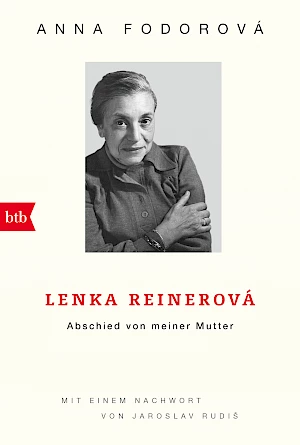 Translated from Czech by Christina Frankenberg
Translated from Czech by Christina Frankenberg
When: April 28, 2022, 7:30 p.m
Where: Central Library in the Kulturpalast Dresden
Admission: free, registration required at central library@bibo-dresden.de
Lenka Reinerová was the last German-speaking author in Prague, the great lady of German-Czech literature, Jewish, and she survived them all until her death in Prague in 2008: Anna Seghers, Egon Erwin Kisch, Max Brod. She fled from the Nazis via Paris, Marseille and Casablanca to Mexico City, after her return she was imprisoned in Czechoslovakia as part of the Stalinist purges – without a doubt, Lenka Reinerová lived one of the most moving biographies of the past century.
In her book, which is as poetic as it is personal, her daughter Anna Fodorová, who now lives in London as a psychotherapist, bids farewell to her famous mother. It is the story of Lenka Reinerová's final years, it is a new encounter with the great lady of German-Czech literature, and it is a grown-up daughter's view of life with her mother - personal, poetic and deeply touching.
A cooperation of: Euroregion Elbe/Labe, Municipal Libraries Dresden, Czech Center Berlin and Czech Literature Center (ČLC). Under the patronage of the Consul General of the Czech Republic in Dresden JUDr. Marketa Meissnerova.
With a book table from Buchers Best
(This is an automatic translation by Google Translator.)
what's new
1 experience – boat trip on the Elbe
2 Start of the 2022 summer season with bus - ferry - Kirnitzschtalbahn
3 From carrot beds to fortress forest – new special exhibition at Königstein Fortress
4 Congratulations, Yellowstone!
5 30 years of landscape maintenance with black "Scots" in Saxony's only national park
6 Emergency aid for Ukrainian protected areas
7 Kahn Ahoy! The Obere Schleuse in Hinterhermsdorf starts the season
8 The Gottleubatal Panoramaweg
9 Landgasthof Ziegelscheune in Krippen – tradition for the love of hospitality
10 Mowing for Biodiversity
11 The most beautiful and fastest planting ever!
12 Tourism Round Table – Presentation of the “Dynamic Traffic and Parking Guidance System” concept
13 Explore the Kirnitzsch Valley and the panorama villages with the hiking buses
14 A good example of sustained perseverance and good timing!
15 recipe of the month
16 appointments and events
Newsletter for download
Source: Joint initiative by the Sachsenforst state enterprise, Saxon Switzerland National Park Administration and the Landschaf(f)t Zukunft e. V
(This is an automatic translation by Google Translator.)
In this video, the State Office for Early Neighborhood Language Education explains the possibilities of partnerships between daycare centers in Saxony, the Czech Republic and Poland.
(This is an automatic translation by Google Translator.)
March 2022
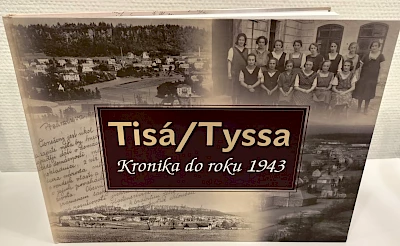 The municipality of Tisá together with the Euroregion Elbe/Labe (and funded by the EU) published the chronicle of Tisá until 1943 in autumn 2021. This is now available in some free copies at the Euroregion offices in Dresden and in Ústí.
The municipality of Tisá together with the Euroregion Elbe/Labe (and funded by the EU) published the chronicle of Tisá until 1943 in autumn 2021. This is now available in some free copies at the Euroregion offices in Dresden and in Ústí.
The chronicle proper does not begin until after the founding of Czechoslovakia, but the first chapters present a detailed review of the history of the village since the Middle Ages. Of particular interest, however, are the contemporary descriptions of the 1920s and 1930s, which give a good insight into the life and views of the people of that time.
The chronicle was kept until 1943. There is another booklet covering the years 1945/1946, but only in Czech. This is also available from the Euroregion.
If you are interested, please contact the respective Euroregion office (see Contact) and arrange to pick up the book.
Translated with www.DeepL.com/Translator (free version)
This issue has a special theme: our sustainability for a more climate-friendly future. How can everyone plan sustainable steps in everyday life?
From the content:
- We ask Barbara & Andreas Motz, owners of the Brückenschänke in Sebnitz
- What motivates young people to become fish farmers?
- "Please don't complain"
- Pirna is arming itself against the consequences of climate change
- Mobile guest card: free public transport for overnight guests
- Felsenbühne Festival 2022 in the spa town of Rathen - the green theatre
- Sustainability in the Saxon Switzerland National Park Center in Bad Schandau
- Thoughtful times – where do we draw our strength from?
- The new sustainability manager in tourism introduces herself
- Shaping tourism together – with heart and mind!
- Tourism with a future
- Naked and unpacked - the new unpacked shop in Neustadt
- The LEADER region "Saxon Switzerland" is drafting its plan for 2023 - 2027
- recipe of the month
- A new start for the market hustle and bustle on Saturdays in Pirna
- Sustainability week Saxon Switzerland
Source: Joint initiative by the Sachsenforst state enterprise, Saxon Switzerland National Park Administration and the Landschaf(f)t Zukunft e. V
(This is an automatic translation by Google Translator.)
Today the members of the local steering committee met for the last time as part of the ongoing small projects fund in Děčín Castle to decide on the funding of 7 Saxon and 5 Czech projects. All project applications were approved unanimously. The funding volume for the approved projects totals EUR 158,586.76.
Some projects - especially on the Czech side - have to wait on a waiting list so that funds that are still committed from ongoing projects are not being used in order to receive their funding. However, it can be assumed that ultimately all projects can actually be supported.
to the list of approved projects
(This is an automatic translation by Google Translator.)
Due to the lower probability of suffering a severe COVID disease from the omicron variant, the Robert Koch Institute today removed all countries from the list of risk areas. This eliminates the obligation to register for entry electronically and to quarantine. Only the 3G proof must still be carried.
on the Corona regulations in Saxony and the Czech Republic
(This is an automatic translation by Google Translator.)
Our European continent has already experienced too many wars in the past that have left generations scarred. The process of European and cross-border integration is therefore essential for promoting peace and security and respecting fundamental rights and freedoms.
The Executive Committee of the Association of European Border Regions condemns the invasion of Ukrainian territory by the armed forces of the Russian Federation. Determining the borders by means of war does not belong into the 21st Century, and falls apart from AEBR expectations from Russia, as declared in our Annual Conference in Kursk (close to the Russian-Ukrainian border) on 21 September 2011: good practices in cross-border cooperation and neighbourhood.
We also support the measures taken by the institutions of the European Union and international organisations to protect the Ukrainian population, regions and cities, the respect to the Rule of Law and the international obligations deriving from treaties, as well as the interests of the Union.
AEBR Executive Committee calls on the Russian Federation to respect Ukraine's state integrity and sovereignty and its existing territorial borders. It, therefore, calls to cease its military actions against Ukraine immediately, withdraw its troops from Ukraine and return to a peaceful diplomatic solution. Similarly, Russia must immediately withdraw the recognition of the so-called 'People's Republics' Donetsk and Luhansk, which is contrary to international law.
In Arnhem, Basel, Berlin, Bruges, Brussels, Cottbus, Drama, Dresden, Eupen, Évora, Freyung, Gronau, Groningen, Guben, Hamar, Joensuu, Lappeenranta, Liberec, Linz, Maastricht, Mérida, Salzburg, Santiago de Compostela, Sevilla, Strasbourg, Szczecin, Vaasa, Winterswijk, Xanthi and other locations all over Europe.
Online AEBR Executive Committee meeting, 25 February 2022
see: https://www.aebr.eu/resolution-aebrwithukraine/
February 2022
January 2022
Here is the announcement of the future fund for the new program "A year at the border" :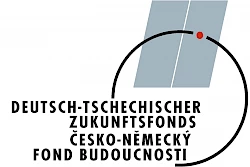
The German-Czech border region plays a key role for mutual relations and thus also for the future fund, as it offers people from both countries the opportunity to get in touch with each other over short distances, to meet each other directly and to learn from each other. Many people and organizations along the border are already actively shaping the German-Czech neighborhood. Nevertheless, we believe that there is still hidden potential for cooperation and partnership to be discovered and used.
On the occasion of the 25th anniversary of the German-Czech Declaration, the Future Fund is launching the One Year at the Border program for the year 2022/23 with the aim of strengthening local German-Czech neighborliness and thus contributing to the development of a lively border region. A total of eight Germans and Czechs will be active on both sides of the border in the various border regions: They will sound out and evaluate potential for encounters and cooperation, arrange offers and contacts and help to set up joint projects - wherever German and Czech partners need support, the bilingual enablers will lend a helping hand.
To participate in this program, by May 1st, 2022
Enthusiasts and creators (m/f)
searched.
The area of responsibility includes in particular:
- Discovering and using the potential for encounters, cooperation and partnership in the border region
- Gaining new target groups for German-Czech project work
- Renewal and strengthening of German-Czech cooperation in the border region
- Networking of German and Czech partners on both sides of the border
- Support in the implementation of joint cross-border projects
What you should bring with you:
- Interest and relation to German-Czech topics
- Active language skills CZ/DE (mother tongue / foreign language at least B2)
- Very good communication skills and open demeanor
- Place of residence in the German-Czech border region is an advantage
- Independent planning and action, organizational skills, ability to work in a team, as well as flexible working hours and willingness to travel
- Driving license class B and own car an advantage
- Good IT-Skills
What you can look forward to:
- An interesting and varied job with room for creativity
- Opportunity for independent project development (with your own budget)
- Scope of work 20h/week, duration 12 months, adequate payment
- Provision of a laptop and assumption of telephone and travel expenses
- Monitoring and regular evaluation by employees of the fund
Please send your meaningful documents with a letter of motivation, curriculum vitae, proof of language skills and certificates to Ms. Helena Vaňková (helena.vankova@fb.cz) by February 28th, 2022.
Please name at least two of the regions listed below in which you would like to work:
- Upper Lusatia - Liberecko
- Elbe Valley - Ústecko
- Eastern Ore Mountains - východní Krušnohoří
- Western Ore Mountains - západní Krušnohoří
- Upper Franconia - Chebsko
- Upper Palatinate - Domažlicko
- Northern Lower Bavaria - západní Šumava
- Southern Lower Bavaria - východní Šumava
Contact:
Helena Vankova
helena.vankova@fb.cz
+420 283 850 512
+420 605 028 151 (mobile)
(This is an automatic translation by Google Translator.)
December 2021
This film was made by the Joint Secretariat of the Saxony-Czech Republic 2014-2020 cooperation program in order to illustrate the results of the cooperation on the basis of several projects.
(This is an automatic translation by Google Translator.)
On December 23rd the Czech government has issued a new regulation on entry to the Czech Republic, which will apply from December 27th, 2021.
On the one hand, this means that people who have been vaccinated twice must show a negative PCR test. The only exceptions are people with a booster vaccination and children. In some cases, an antigen test is sufficient.
On the other hand, small border traffic will be suspended from December 30th, 2021 to January 1st, 2022. During those three days the same rules apply to short trips to the Czech Republic as to longer visits.
Cross-border commuters are not affected by these new regulations.
This 141st edition is the conclusion of twelve more Swiss people of the year, with events from the region:
1 On a digital round of visits to the national park partners
2 Clearing of hiking trails in the national park
3 Halloween and the end of the pumpkin season
4 kick-off meeting "Food vending machines in the Saxon Switzerland National Park region"
5 About the eagle owl that didn't want to fly
6 It's 10! 7 Full steam ahead against
7 Full steam ahead against grafitti
8 Three wolf pups in the Bohemian Switzerland National Park
9 Flying trees - traffic safety with a helicopter in the Kirnitzschklamm
10 Producer database “Good things from here.” Is getting a makeover.
11 Start of the new LEADER development strategy 2023 - 2027
12 Gold for Pirna - Sandstone City receives European Energy Gold Award for exemplary climate protection
13 The last Käferbus - let nature be nature!
14 recipe of the month
15 Donation to the Friends' Association
16 Train traffic
Source: Joint initiative of Staatsbetrieb Sachsenforst National Park Administration Saxon Switzerland and Association Landschaf (f) t Zukunft e. V.
|
|
(This is an automatic translation by Google Translator.)
November 2021
In an online meeting, the local steering committee for the small project fund in the Euroregion Elbe/Labe aprroved 5 Saxon and 4 Czech project applications. These include a total funding volume of 115,183.01 euros.
To the overview of the approved projects
The funds on the Czech side are formally exhausted, on the Saxon side € 32,854.70 are still available. In both cases, however, it is to be expected that further means will be available, since not all current projects will fully use their approved funding.
In January 2022 there will be one last opportunity to submit applications to the small project fund. The projects must be finished by the end of October 2022 and then settled within 2 months.
In the Czech-German border region, cross-border hiking, shopping and doing sports as well as mutual visits have fortunately become part of everyday life in cross-border relationships. The format Couragiert debattiert - Neighborhood Talks is dedicated to this friendship and offers bilingual conversation and discussion formats on current topics in order to continuously strengthen Czech-German relations.
But what about the cross-border medical care of patients? The next edition of the format on November 25, 2021, 7:00 p.m.
What happens if the nearest hospital is across the border after an accident? What special challenge does the border region have to face? Aside from communication difficulties, what are the greatest common challenges? How can both countries and the Czech-German border region strengthen and expand medical (emergency) care together? What is needed for well-functioning basic medical care in the Euroregion?
A Czech-German panel with the following experts will deal with these and other questions:
- Dr. Bernd Brenner, specialist in anesthesiology and emergency medicine, medical director of rescue services in the Görlitz district
- Petr Severa, Head of the Health Care Unit, Ústi District Office
- Pavel Šebesta Head of the Medical Control Center of the Rescue Service of the Ústí n. L. District
The evening will be moderated by Markéta Knoppik, specialist at Aktion Civil Courage e. V., the competence center for communal political education and advice in Saxony. The event is bilingual. Simultaneous translation into both Czech and German has been set up.
participation
Participation in the conversation takes place digitally via the Zoom video platform under the following link: https://aktion-zivilcourage-de.zoom.us/j/87679116448
Meeting ID: 876 7911 6448
If you have any questions about the project or the evening of debate, Markéta Knoppik is available at: m.knoppik@aktion-zivilcourage.de and Andreas Tietze at a.tietze@aktion-zivilcourage.de and 03501 460882.

(This is an automatic translation by Google Translator.)
What's new in the Saxon Switzerland National Park?
• Schmilka winter village
• Schmidt country bakery
• "Wool bloom" gives the sheep wool
• The National Park Guard has a new head
• The story of the "ball tree"
• Species-rich meadows awarded at the Mountain Meadow Festival
• With special technology against impassable paths
• Competence network for tourism mobility
• Saxon Switzerland tourism model
• Press release from SIB Stadtradeln und Fahrradgarage
• Wild boar with oven pumpkin
• Dates and events
Source: Joint initiative of Staatsbetrieb Sachsenforst National Park Administration Saxon Switzerland and Association Landschaf (f) t Zukunft e. V.
(This is an automatic translation by Google Translator.)
The exhibition on the about 800-year history of the German-speaking population in the Bohemian countries, implemented by the Collegium Bohemicum in the Municipal Museum Ústí nad Labem, will be officially opened on November 17th, 2021, and can be visited from November 18th by the public.
If you are on Facebook, you can see a few recent photos of the exhibition in a post from the Collegium Bohemicum.
Invitation of the Saxon State Ministry of Justice and for Democracy, Europe and Equality:
As the Saxon State Ministry of Justice and for Democracy, Europe and Equality (SMJusDEG), we want to actively participate in the future process of the EU. That is why we are launching a cross-border dialogue. On 10 and 11 December 2021, about 100 citizens from Saxony, Lower Silesia, Karlovy Vary Region, Ústí Region, Grand Est (France) and Baden-Württemberg (Germany) will meet at the 6-Regions Dialogue. Here they debate about living together in the border regions and share their experiences.
All citizens from the participating regions can take part. We would be particularly pleased if the participants of the trinational dialogue "Seams of Europe: Border Regions in Dialogue" were to take part once again and bring the ideas they found there to this six-region dialogue.
Invitation from the Saxon State Ministry of Justice and Democracy, Europe and Equality:
As the Saxon State Ministry of Justice and for Democracy, Europe and Equality (SMJusDEG), we want to actively participate in the future process of the EU. That is why we are starting a cross-border dialogue. The tri-national youth forum in Görlitz kicked off this dialogue process at the beginning of October.
We now invite you to take part in a dialogue with citizens from Saxony, Lower Silesia (Poland), the Karlovy Vary region, the Ústí region (Czech Republic), Grand Est (France) and Baden-Württemberg. This dialogue takes place in three events.
The geographical location of the Free State of Saxony in the triangle between Germany, Poland and the Czech Republic offers the best conditions for cross-border dialogue formats. We want to listen to the border regions and find out what is particularly important to you as citizens in relation to the European Union. Where do you see the greatest challenges? Is it climate change? Is it the desire for more direct democracy? Or something completely different?
We would like to ask you how closely you feel connected to the European Union. Could you envision European citizenship? Should the regions have a greater say at European level? Should EU citizens aged 16 and over be able to vote? What about respect for human rights in the EU?
Through the exchange, we want to collect your ideas for future coexistence in the border regions in the east and west of the European Union and together make a contribution to the future of Europe.
NOTE: The follow-up event will take place as a six-region dialogue with the participation of Baden-Württemberg (DEU) and Grand Est (FRA) on December 10-11, 2021 (Fridays from 6 p.m. to 9 p.m. and Saturdays from 9 a.m. to 3.30 p.m.) as Online event. Please make a note of this date in advance! Here is the link to register for the six-region dialogue: https://mithaben.sachsen.de/1026874
(This is an automatic translation by Google Translator.)
October 2021
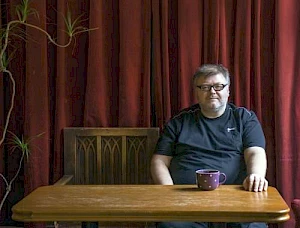 Petr Stančík and Iris Milde present his exciting story from the Second World War: a man with steel springs on his shoes, who can jump unusually far and high, uses his skills to sabotage the German war economy. A resistance fighter and an elusive ghost above the rooftops of Prague at night. He was also involved in the assassination attempt on Reinhard Heydrich, Hitler's husband in the Protectorate of Bohemia and Moravia. The name of the mysterious hero is Franz Pérák - the jump man. In the novel, he falls in love with the beautiful resistance fighter Jitka, who fights with him against the occupiers. At the same time he tries to solve the riddle of his own identity. So who is Pérák, the superhero from Prague? The answer that Petr Stančík offers is beyond imagination
Petr Stančík and Iris Milde present his exciting story from the Second World War: a man with steel springs on his shoes, who can jump unusually far and high, uses his skills to sabotage the German war economy. A resistance fighter and an elusive ghost above the rooftops of Prague at night. He was also involved in the assassination attempt on Reinhard Heydrich, Hitler's husband in the Protectorate of Bohemia and Moravia. The name of the mysterious hero is Franz Pérák - the jump man. In the novel, he falls in love with the beautiful resistance fighter Jitka, who fights with him against the occupiers. At the same time he tries to solve the riddle of his own identity. So who is Pérák, the superhero from Prague? The answer that Petr Stančík offers is beyond imagination  power.
power.
The writer, poet and playwright Petr Stančík (1968) delights readers in his diverse work with a mixture of facts, mysticism, humor and unbridled imagination. For his novel The Mummy Mill (Mlýn na mumie), published in 2014, Stančík received the Czech Republic's most prestigious literary prize Magnesia Litera. The bestseller has so far been translated into five languages. His sci-fi adventure for young readers H2O and the secret water mission was awarded the Golden Ribbon for best children's literature.
A cooperation between: Euroregion Elbe / Labe, Dresden City Libraries, Czech Literature Center (ČLC) and Czech Center Berlin.
Under the auspices of the Consul General of the Czech Republic in Dresden JUDr. Markéta Meissnerová.
With the kind support of edition Clandestin.
(This is an automatic translation by Google Translator.)
At the end of the awarding of the 13th Dresden Poetry Prize, the specialist jury will read their texts in the Erich Kästner House for Literature (Antonstrasse 1, 01097 Dresden).
In order to do justice to the numerous facets and varieties of poetry when awarding the prize, which is awarded every two years by the state capital Dresden, the main jury is made up of versatile poets and literary scholars in German and Czech. In 1998, Petr Hruška was the winner of the Dresden Poetry Prize and, in addition to his poetic work, works as a literary scholar. Anja Utler also works in the literary and literary fields. She is particularly dedicated to the performative aspect of texts. With Radka Denemarková and Nico Bleutge, two multiple award-winning authors complete (t) the main jury of the 13th Dresden Poetry Prize and the field of readers that evening.
In addition to multi-faceted poetry, the evening will also feature a concert by pianist Karel Vrtiška.
* inspired by Nelly Sachs' poem "This chain of riddles"
Nico Bleutge: including Anna Seghers Prize, Eichendorff Literature Prize
Radka Denemarková: ao Magnesia Litera (prose, translation)
Petr Hruška: including the Dresden Poetry Prize, Jan Skácel Prize
Anja Utler: including Leonce and Lena Prize, Basler Poetry Prize
Florian Ernst will be happy to answer any questions you may have on tel. 8045087.
(This is an automatic translation by Google Translator.)
In this course, using the example of the 69th European competition, the didactic-methodological possibilities of virtual cooperation in Europe are to be developed and tried out in preparation.
Interested parties can find more information here: www.europaeischer-wettbewerb.de/nachrichten/69-europaeischer-wettbewerb-naechster-halt-nachhaltigkeit/
Registration here: https://www.kmk-pad.org/veranstaltungen/anmeldung/digital-und-europaeisch-lernen-mit-dem-europaeischen-wettbewerb-2705.html
Registration deadline: Wed, November 17, 2021, 6 p.m.
Source: eTwinning moderator on behalf of the PAD of the KMK and the district government of Düsseldorf
(This is an automatic translation by Google Translator.)
What's new in the Saxon Switzerland National Park?
1 “Growth” in the database for regional products
2 Our farm shops - a change from the classic supermarket
3 Out and about with the "BrotZeitTour"
4 Networks - Who with whom? Example: Milchhof Fiedler
5 Networking - What's in it for producers and marketers ?!
6 What does it bring for the region ?!
8 The first year on your own field
10 Finally, the Saxon Switzerland natural market again
Source: Joint initiative of Staatsbetrieb Sachsenforst National Park Administration Saxon Switzerland and Association Landschaf (f) t Zukunft e. V.
(This is an automatic translation by Google Translator.)
The association Aktion Zivilcourage eV Pirna and its partners invites you to discuss the current topic "Courage debated - Germany and the Czech Republic after the elections on Wednesday, October 13, 2021 from 7-10: 15 pm in the Pirna Council Chamber and via livestream (zoom) "Sincerely.
Further information and registration
A joint project of the Aktion Zivilcourage e. V. and the Euroregion Elbe / Labe, The project is funded by the European Union from the European Regional Development Fund.
Source: Aktion Zivilcourage Pirna eV
(This is an automatic translation by Google Translator.)
September 2021
Eight cross-border projects with a total volume of funding of 108,226.81 euros were approved today by the local steering committee in the small project fund. These included six Czech and two German projects.
To the overview of the projects
(This is an automatic translation by Google Translator.)
We are asking for quotes for the following printing services:
- 3 panels, at least 3 mm thick, format A0, 4/0 colored, printed on one side
- 7 panels, at least 3 mm thick, format A0, 4/4 colored, printed on both sides
Execution until 09/30/2021
Please send us your offer by September 24th, 2021 to the address given under Contact .
(This is an automatic translation by Google Translator.)
Zpravodaj ke stažení - pouze v němčině
zdroj: Joint initiative of Staatsbetrieb Sachsenforst National Park Administration Saxon Switzerland and Association Landschaf (f) t Zukunft e. V.
(This is an automatic translation by Google Translator.)
August 2021
We ask for offers for the following bus transfers to the Czech Republic and back (each from Dresden):
October 2nd, 2021 Chabařovice
Address: Roudníky 7, 40317 Chabařovice
Departure at 3 p.m.
Return from 7 p.m.
October 3rd, 2021 Roudnice / Litoměřice
Departure at 10 a.m. from Dresden-Albertplatz
Round trip via Pillnitz, Teplice and Roudnice nad Labem to Litoměřice with possible stops
Arrival in Litoměřice around 4 p.m., longer stay
Return from around 7 p.m.
09.10.2021 Markvartice
Address: Markvartice 194, 40742 Markvartice u Děčína
Departure at 2 p.m.
Return from 6 p.m.
October 16, 2021 Velké Březno
Address: Zámecká 63, 40323 Velké Březno
Departure at 3 p.m.
Return from 7 p.m.
Unless otherwise stated, the tours start and end at the Kreuzkirche Dresden. It's always about
a bus for about 40 people.
Please send your offers to info@elbelabe.eu by 14.09.2021.
(This is an automatic translation by Google Translator.)
Communication from the German-Czech Future Fund on the RESTART II program:
Even if the pandemic situation has improved significantly in both countries, it should be noted that the general uncertainty and the uncertainty regarding realistic dates, suitable formats and meaningful project content that have burdened us in the last few weeks have not yet completely subsided .
In order to facilitate the decision-making process in favor of future projects at this moment and to make their implementation possible at all, we have decided to launch a new special funding program RE-START II, which will replace the existing special funding programs (RE-START, digital or outdoors?) and expanded. We firmly believe that together we will succeed in the German-Czech restart.
In this program, all meeting formats can be continuously funded with a maximum of CZK 100,000 or € 4,000.
The RE-START-II program is aimed at German and Czech actors of all funding areas and ages (except renovation of monuments and publications) who want to implement projects from July to December 2021 but were unable to submit a regular project application to the future fund due to the short-term nature of the project.
Funding height:
- The maximum funding amount is CZK 100,000 or € 4,000 and can amount to up to 70% of the total costs.
Use of the grant:
- The grant is intended primarily for the items of travel expenses, accommodation and meals for the participants.
Funding conditions:
- In addition to the standard criteria for granting a grant, the funded projects must meet the following conditions:
- The project has to be realized between July and December 2021.
- Applicants who can apply for and implement their projects within the regular deadlines are excluded.
- The support may not be combined with other grants from the fund that have already been approved.
Type of application:
- Applications can be submitted via the online system from July 1, 2021 until November 15, 2021 at the latest, outside of the usual deadlines.
- The decision on the application is made by the management of the DTZF within a shortened period.
The exact details as well as the link to the application can be found on the website of the German-Czech Future Fund:
To the German-Czech Future Fund
(This is an automatic translation by Google Translator.)
July 2021
The Řehlovice cultural center invites you to the opening of the 20th German-Czech art symposium STRÖMUNGEN-PROUDĚNÍ on July 24th, 3 p.m. Please refer to the invitation for further items on the program.
Source: organizer
(This is an automatic translation by Google Translator.)
In the latest edition of SandsteinSchweizer you will find the following information:
- Your way into the sandstone cliffs - sandstone makes you mobile
- The alternatives to the car are waiting for you - you have a clear conscience in the bus!
- Your goal is getting closer
- The last mile begins
- Hiking buses
- New line 254 - the rock line
- Route map of Saxon-Bohemian Switzerland (excerpt)
- With the FahrradBUS in the mountains
- Boat trips in the gorges
- Kirnitzschtalbahn
- Touring ship
- Local traffic continues with the neighbors
- Routes to and from Schöna and Hřensko
- Cast off
- Bad Schandau-Ostrau passenger elevator
- Particular danger from dead trees
- We need to talk
Source: Joint initiative of Staatsbetrieb Sachsenforst National Park Administration Saxon Switzerland and Association Landschaf (f) t Zukunft e. V.
(This is an automatic translation by Google Translator.)
Thanks to the improving epidemiological situation and the easing of border traffic, the Elbe / Labe Euroregion has started selling the Euroregion's cultural pass for 2021. It is a popular and long-term relief for Czech guests in cultural institutions on the Saxon side of the EEL.
Holders of the culture pass receive reduced admission to more than 50 Saxon cultural institutions.
A new feature in 2021 is the discounted entry for families to the Oskarshausen children's adventure area in Freital.
The passes are currently being distributed to the tourist information offices in the Euroregion. The culture pass is also available from the Euroregion Secretariat in Ústí or by post.
(This is an automatic translation by Google Translator.)
June 2021
The local steering committee in the small project fund of the Euroregion Elbe / Labe decided in its meeting on June 18, 2021 to support 13 projects. 7 of these projects have a German lead partner and six have a Czech one. A total of 173,777.61 Euros in funding was committed.
The meeting took place in the culture hall in Chlumec, which offered enough space to keep the necessary distances. We thank the city of Chlumec for their kind support.
The Robert Koch Institute announced this afternoon that the Czech Republic will no longer be classified as a risk area as of Sunday due to the sharp decrease in the number of infections. This removes all restrictions on entry (including return) from the Czech Republic.
At the same time, the Czech government is moving Germany down to the orange category from 7.6. (Monday!), so to medium risk. This does not remove all restrictions on entry, but in particular the obligation to quarantine and a second corona test is no longer necessary. Registration and a negative corona test are still required for entry.
We will update our page with all relevant Corona regulations on entry and residence as soon as the new regulations come into force.
May 2021
The pandemic situation is gradually improving on both sides of the border, but one year of Corona has had a huge impact on the lives of many. Children, young people and families are particularly affected, including people on short-time work and senior citizens. In the border regions in particular, the social consequences of the current crisis and its effects in the future could become particularly evident.
That is why the German-Czech Future Fund wants to once again support the ideas and activities of associations, non-profit organizations and initiatives that are able to counter the consequences of the pandemic exactly where it is really necessary. You would like to support those who do something against the above and similar effects of the corona pandemic and support social and health activities in the German-Czech border area.
Target group:
- Non-profit organizations, communities, associations
- Providers of social and health services, nursing homes, residential groups, children's facilities, etc.
- Educational and cultural initiatives
Funding conditions:
- Activities that react to problems that have arisen or intensified as a result of the corona crisis and lead to a lessening of the health and social consequences (e.g. activities that counteract social loneliness or the negative consequences of missed lessons, support for mental and physical health, help for disadvantaged groups, creative solutions for the current situation, etc.)
- the activities must be carried out in the German-Czech border area (up to 30 km from the border)
- In contrast to the usual funding, no Czech project partner is required
Funding height:
- max. 8000 euros
- Funding level 100%, co-financing is not necessary
Timeframe:
- Application: ongoing (until the funds are exhausted) until July 31, implementation of the project in the period from February 1 to September 30, 2021
All detailed information can be found on the website of the German-Czech Future Fund .
(This is an automatic translation by Google Translator.)
On May 13, 2021, an ordinance adopted today by the federal government will come into force. For the first time, this also regulates the quarantine obligation nationwide, while so far this has been done by the federal states.
According to the regulation, no quarantine is required when returning from a risk area if you have been there for a maximum of 24 hours. Contrary to the previous Saxon regulation, this also applies to travel without an important reason, i.e. also to tourism and recreation.
April 2021
Due to the steadily decreasing number of infections in the Czech Republic, the Robert Koch Institute announced today at noon that the Czech Republic will only be classified as a "normal" risk area from May 2nd. So far it was still a high incidence area.
That reduces the requirements for corona tests for cross-border commuters. The lower classification has no real significance for anyone else.
Around a third of EU citizens live and work in border regions. The boundaries have a direct and indirect effect on their daily life. People living in border regions often face particular challenges, be it in terms of job search, access to health care and other public services, or daily commuting and overcoming administrative problems. The most effective instrument for overcoming the separation effect of borders has been shown to be cross-border cooperation.
A Europe-wide conference on the future of Europe will open in Strasbourg on May 9th. The European Committee of the Regions wants to play an active role in this conference, so its members organize local debates in their regions. With this debate, the Euroregion Neisse would like to contribute to formulating a vision of how cross-border cooperation will work in the future and what role border regions should play in this.
The debate is public and we look forward to a broad discussion. People with important functions and many years of experience in cross-border cooperation will speak:
- Martin Půta , President of the Liberec Region, President of the Nisa Euroregion, member of the Committee of the Regions
- Bernd Lange , District Administrator of the district of Görlitz, President of the Euroregion Neisse, member of the Committee of the Regions
- Pavel Branda , Deputy Mayor of Rádlo, member of the Committee of the Regions, Vice-President of AEBR
- Thomas Zenker , Mayor of Zittau (to be confirmed)
- Iva Linderová, director of the District Chamber of Commerce in Jablonec nad Nisou
- Regina Gellrich , Head of the Saxon State Office for Early Neighbor Language Education
- Hedvika Zimmermannová , pastor of the Czechoslovak Hussite Church, representative of the city of Hrádek nad Nisou
- Hynek Böhm , Assistant Professor, Institute of Geography, Technical University of Liberec
- Blanka Konvalinová , emeritus director of the Regional Scientific Library in Liberec, chairwoman of the EUREX library
- Martín Guillermo Ramírez , General Secretary of AEBR (Association of European Border Regions)
- Slaven Klobucar , EGTC Monitoring Platform, European Committee of the Regions
Moderation: David Hamr, Czech Radio Liberec
Date: April 21, 2021, 2.30 p.m. to 4.30 p.m.
Take part in the debate too! The debate will take place online and you can participate at the following link:
https://euconf-eu.zoom.us/j/98598410661?pwd=aElKS1p0cnRQS0gxOGFlOVhGWWdDQT09
Discussion topics:
- What is the significance of cross-border cooperation for our region?
- What are the main obstacles to the development of cross-border cooperation (legal, administrative, linguistic, economic, human ...)? What's the best way to overcome it?
- What effects did / does the COVID-19 pandemic have on cross-border cooperation? How should action be taken in the future to prevent collaboration from being so impaired?
- What is the minimum level of cross-border cooperation that the EU and Member States must guarantee in similar crises?
- What should cross-border governance look like in the future? For example, should an integrated room planning system work? A common territorial development strategy?
- What should life in border regions look like? Access to public services? Education? Culture? Health care? Crisis management?
- Should a cross-border identity be developed? How can you reach them?
(This is an automatic translation by Google Translator.)
March 2021
Since March 28, 2021, the Robert Koch Institute has no longer classified the Czech Republic as a high-risk area due to the spread of particularly dangerous virus variants, but only because of its high incidence values.
Above all, this makes things easier for cross-border commuters, as well as for business travelers. But family visits and, to a limited extent, small border traffic are also made easier.
To the currently applicable regulations
(This is an automatic translation by Google Translator.)
In the current situation there are not many applicants who dare to apply for a cross-border project. Nevertheless, four project applications were submitted for the meeting of the local steering committee on March 19, 2021. All applications were approved in an online meeting.
Projekt CouReg zielt auf junge Menschen im sächsischen und böhmischen Grenzland. Unser Ziel ist die Stärkung und der Ausbau von demokratischen Potentialen. Konkret werden Bildungsmodule mit Lehrmaterialien 1) für Schüler und 2) für Studenten zum Thema Zivilcourage und zivilgesellschaftlichem Engagement entwickelt. Unser Projekt will diese Fähigkeiten trainieren und damit interkulturelle und demokratische Kompetenzen bei der jungen Generation zwischen 14 und 25 Jahren ausbauen.
The Newcastle University Bussiness School is currently researching the effects of the corona pandemic on cross-border commuters in Germany.
The aim of the study is to determine how the experience of work and stress among immigrants / temporary workers / cross-border commuters has changed during the corona pandemic. It is about your personal experience, experiences and points of view. [...]
This group of employees is not sufficiently represented in political discourse and research and generally has an increased risk of stress and psychological illnesses, which can potentially be attributed to the work situation and above all to the unfamiliar life situation (possibly no family environment , different language and culture). Since these factors could be intensified in times of Corona (travel restrictions, fewer opportunities to organize the daily routine outside of work, fewer contacts, increased workload), the aim of the study is to record how you perceive the current situation, what kind of support you need Available and what tools you would use and need in order to deal successfully with the given situation.
More information from Newcastle University
(This is an automatic translation by Google Translator.)
Nechte se nejnovějšími vydáním sandstoneSwiss vydat na jarní procházku ve stále zasněné krajině Saského Švýcarska .
Zpravodaj ke stažení - pouze v němčině
zdroj: Joint initiative of Staatsbetrieb Sachsenforst National Park Administration Saxon Switzerland and Association Landschaf (f) t Zukunft e. V.
(This is an automatic translation by Google Translator.)
Last week the Chamber of Commerce and Industry Chemnitz carried out a survey on the effects of the border closure with the Czech Republic on Saxon companies. Here are excerpts from the press release on the results:
IHK demands the fastest possible border opening for commuters
The current entry regulations on the border with the Czech Republic have serious effects on Saxon companies. This is borne out by the results of the most recent survey by the Chemnitz Chamber of Commerce and Industry on the issue of cross-border commuters. Until February 26th, 2021 a total of 255 companies with around 25,000 employees were involved. Around half of the companies come from industry.
“We call on politicians to restore normal conditions at the Czech border as soon as possible. It cannot be that companies are no longer able to work, or only to a limited extent, because they are losing their Czech workforce. Most of the companies would even accept daily testing of their employees”, emphasizes Hans-Joachim Wunderlich, General Manager of the Chemnitz Chamber of Commerce.
According to the results of the survey, the majority of respondents oppose closing the border to commuters. While 47 percent rate this measure as disproportionate, 14 percent consider it necessary. The short-term changes to the Saxon quarantine ordinance as well as the lack of reaction options and insufficient planning security are also seen as extremely critical. [...]
With a view to a possible opening of the border for commuters, two out of three companies are willing to have their commuters tested on a daily basis. This would then be the most frequently tested population group in Europe. Based on this knowledge, the federal and state governments in Bavaria and Saxony should take a joint decision as soon as possible to open the German-Czech border to commuters.
The entire press release and the detailed results can be found on the Chemnitz Chamber of Commerce website .
(This is an automatic translation by Google Translator.)
February 2021
The IHK calls for participation in a quick survey regarding the economic consequences of the border closure to the Czech Republic for Saxon companies as follows:
In view of the implementation of the Saxon Corona Quarantine Ordinance of February 15, 2021 and the classification of the Czech Republic as a virus variant area, numerous employees who commute from the Czech Republic to Saxony are no longer allowed to cross the border from the Czech Republic to Saxony. Exceptions to the quarantine requirement only apply to relatively few employees. The effects on your company are sometimes devastating, but at least are associated with considerable production-organizational problems, negative commercial effects such as impending contractual penalties and future problems in recruiting skilled workers.
We have to assume that the political actors are only superficially aware of the aforementioned consequences for your company. In order to make the political at the state and federal level the high level of concern in the border regions clear, we urge you to take part in our survey at short notice.
We are bundling many of your individual activities and expect politicians to exit the border closure for our Czech employees as quickly as possible.
Please support us in this joint task with the aim of ending the unlimited border closure for commuters as quickly as possible.
The survey takes a maximum of 5 minutes and is available here until 02/26/21: Survey on the border closure with the Czech Republic
(This is an automatic translation by Google Translator.)
From February 14, 2021, the entire Czech Republic will be classified as a virus variant area by the Federal Republic.
For all flight, train and bus operators, it is now the case that guests from areas with particularly dangerous virus variants cannot be transported to Germany. The only exception is for German citizens or for travelers who live in Germany permanently. Deutsche Bahn has already announced that it will cease all connections to the Czech Republic from Sunday (February 14, 2021).
Further information:
Status: 02/13/2021
(This is an automatic translation by Google Translator.)
The Sächsische Zeitung published the following article on February 5th:
Book about village history published
The money almost wasn't enough for the German-Czech publication.
From Steffen Neumann
Jitka Tumová from Teplice has worked for 13 years on her bilingual book “The life of the inhabitants below the Kaltenberg over time” about the two villages of Studený (Kaltenbach) and Lipnice (Limpach). She grew up in a weekend house in the villages below Studenec near the town of Česká Kamenice and spent the summer months of her life. After many additions and the extensive translation, the book was finally ready in autumn. To be able to print it, only 2,000 euros were missing.
But in the end they became a problem, despite the many donations Tumová had already received. All hope rested on the fund of the Czech bank ČSOB, which had called a vote to support regional projects. But only the winner could win. The very remote project of a chronicle of two small villages in the former Sudetes had to admit defeat. In addition, the corona pandemic returned and prevented all activities that Ms. Tumová could have developed to raise the necessary money.
Euroregion Elbe / Labe helps
The survey was lost for the book when help came as a surprise. The Sächsische Zeitung reported on the project in November, which is also read in the office of the Euroregion Elbe / Labe. And she decided to step in for the lost survey and contribute the remaining 2,000 euros. “Such publications make an important contribution to the identification with the home region, and that across the border”, explains Rüdiger Kubsch, managing director of the Euroregion, the support and adds: “We were impressed that here civic engagement without the goal of financial gain becomes one bilingual publication. Unfortunately there was no suitable funding program for this, which is why the Euroregion stepped in with its own funds. We didn't want to let this great project fail because of the manageable amount. "
The book has now been printed. Last week Jitka Tumová finally held the book in her hands, which has meanwhile arrived at the local office in neighboring Kunratice (Kunnersdorf). The book can be bought for 590 crowns. After the lockdown is over, it will also be sold in bookstores and tourist information centers. Ms. Tumová hopes to be able to sell the book, which is available in Czech and German, in Germany. The distribution has not yet been clarified.
(Source: Sächsische Zeitung of February 5, 2021, p. 18)
More information about the book
(This is an automatic translation by Google Translator.)
January 2021
In Saxony, a general decree will come into force on Jan. 23, 2021. Cross-border commuters who work in Saxony on the basis of an employment contract must be tested twice a week. Upon entry, the employment contract must be carried. If the test is taken before entry, the underlying smear test must have been taken no more than 48 hours before entry. If there is no negative test on entry, a test must be taken immediately after entry and before starting work. When the second test must be taken is not specified. It is therefore possible to take the test directly after entry at the place of work in Saxony! Evidence of the tests must be carried as soon as they are available.
Note: If you enter Saxony or Bavaria only weekly as a cross-border commuter, one test upon entry is sufficient. If you enter daily as a border crosser and work Monday through Friday, one test on Monday and one test on Wednesday would be sufficient to meet the 48-hour requirement. Quick tests will do!
More detailed info at DGB BEZIRK SACHSEN.
General ruling on the regulation of exemptions from the testing requirement for entry from high incidence areas according to § 4 paragraph 2 number 5 of the Coronavirus Entry Regulation dated 22.01.2021, valid from 24.01.2021.
The Saxon state government has shown some understanding: The originally planned obligation for border commuters to be tested twice a week has been toned down. Only one test per week is required, and the obligation does not come into force until January 18.
Czech (and Polish) tests will be recognized.
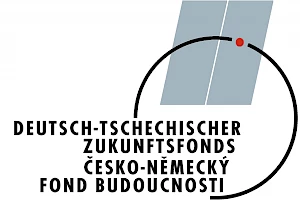 From the press release of the German-Czech Future Fund:
From the press release of the German-Czech Future Fund:
For months now, the public space has been dominated by news about a certain virus. It noticeably affects our private lives and at the same time we at the Future Fund are also aware of the long-term effects it can have on German-Czech relations - on the actors who are committed to them and also on the German-Czech border area.
We have therefore prepared some new special tenders and hope to use them to help mitigate the expected consequences of the pandemic and the measures associated with it. At the same time, we would like this to pave the way for new ideas for German-Czech activities.
We keep going!
Aid program for German-Czech networks in overcoming the Corona crisis
With this program, we would like to help organizations and individuals who have successfully implemented a German-Czech project supported by us in 2018-2020 and have found themselves in a difficult financial situation due to the current crisis. The support is especially aimed at artists, cultural institutions, associations and actors in the field of culture and youth work.
Application deadline: 15.1.2021
Help for the Border Area II
Border Area Social and Medical Mitigation Program
.
With this program we would like to mitigate the social and medical impact of the crisis on life in the German-Czech border area. We therefore support ACtivities of organizations that benefit those people who are particularly threatened by the pandemic.
Application deadline: 15.1.2021
Help for organizations caring for Nazi victims in the Czech Republic
.
Because of their age and the ordeals they endured, Nazi victims who are still alive are among the most vulnerable groups of people The Future Fund has already taken care of them in the course of compensation payments and continues to focus its attention on them.
The organizations will be approached directly.
Digital or outdoor?
Special funding for German-Czech projects in times of Corona
.
To ensure that the world of German-Czech cooperation does not come to a complete standstill, we would like to use this special call for proposals to facilitate the planning and implementation of projects that take place using digital formats or as an outdoor activity.
Application deadline:
- For applications for a grant of up to 4000 euros or 100 000 CZK continuously until 30.6.2021
- .
- For applications for a grant over 4000 euros or 100 000 CZK: at the usual quarterly deadlines (31.12.2020, 31.3.2021, 30.6.2021)
New times? New directions!
Theme of the Year 2021
.
With the theme of the year, we are responding to current social events and the challenges they bring. Within the framework of this special program, we support, with up to 70% of the total costs, projects that focus on the joint reflection of the Corona crisis and its consequences for German-Czech cooperation.
Application deadline: the usual quarterly deadlines (12/31/2020, 3/31/2021, 6/30/2021, 9/30/2021, 12/31/2021)
.
For the days and weeks ahead, let us wish each other strong health - and enthusiasm in shaping good German-Czech relations under these difficult conditions!
Your Future Fund
November 2020
Every Friday the Czech government reviews the list of countries with a low risk of infection with the corona virus. Germany has been on the list since last week, but this is no longer the case as of November 16.
The real effects are small. For foreigners, the necessity of an important reason for entry continued to apply. Only for those who had one, the procedure will now be more complex ( compulsory quarantine and testing).
You can find the details under Current Corona Rules in Saxony and Czech Republic.
The new entry rules for the Czech Republic will come into force on November 9th. For this purpose, the world will be divided into green, orange and red category countries, depending on how the COVID 19 pandemic develops in the country. Germany is in the orange category, so from there on you basically can enter the Czech Republic as before the pandemic. A scheme of the Czech Ministry of Health for entering the Czech Republic explains this very well.
But: As long as the state of emergency applies (for the time being until 20.11.), foreigners may only enter the Czech Republic for important reasons.
Further details can be found under Current regulations on Covid-19 in Saxony and Czechia.
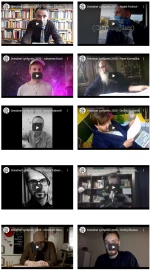 The Dresden Poetry Award is awarded every two years for poetry in German or Czech. This year the readings will take place online. The works are presented by their authors in videos, and the award ceremony on 8 November will take place in a zoom conference.
The Dresden Poetry Award is awarded every two years for poetry in German or Czech. This year the readings will take place online. The works are presented by their authors in videos, and the award ceremony on 8 November will take place in a zoom conference.
In addition to the main award, there will be an audience award donated by the Euroregion Elbe/Labe for the first time. Voting will also take place online.
To the videos of the authors To the vote
Why not take a look when the cultural sites are closed for the moment?
Following the agreement of all German states and the Federal Government, largely identical regulations to combat the corona pandemic will come into force nationwide from Monday. These are initially limited until 30 November.
These will lead to a so-called "lockdown light": almost all facilities for entertainment and leisure activities and all gastronomic establishments (except for takeaway sales) and all tourist accommodation will be banned.
In addition, a quarantine of 10 days will be mandatory from tomorrow on when entering the country from risk areas (including the Czech Republic). This can hardly be shortened: only after 5 days a corona test may be carried out, which will end the quarantine if the result is negative. As you normally have to wait at least 2 days for the result, you can shorten the quarantine by a maximum of 3 days.
All regulations in detail can be found in our overview of the corona rules in Saxony and the Czech Republic.
October 2020
After exceeding the incidence value of 50, the state capital Dresden issued a general decree with additional rules - following the Sächsische Corona-Schutz-Verordnung. These include, among other things, the obligation to wear a mouth-nose cover outdoors in the city center, in an area from the main train station through the old city and the main street bin to the entire Äußere Neustadt.
This comes into force on 27.10.
You can find more details in our updated overview of the Corona Rules in Saxony and the Czech Republic.
In the Czech Republic, measures the government is taking to slow the spread of the coronavirus are being tightened further. From Thursday, October 22, 2020, from 6 a.m., only shops with the basic range (groceries, drugstores, pharmacies) or shops with household supplies or animal feed will remain open. Service providers such as hairdressers and libraries are also closing. Schools or restaurants are still closed. You can currently find further details here .
30 years of the Saxon Switzerland National Park - a special day for the anniversary and further articles from the area of the national park, experiences and regional topics can be found in the 127th SandsteinSchweizer newsletter.
Source: Joint initiative of the Sachsenforst state enterprise, Saxon Switzerland National Park Administration and the Landschaf (f) t Zukunft e. V.
The planned general meeting of the Euroregion Labe on October 15th, 2020 was canceled due to the epidemiological situation in the Czech Republic.
Today, stricter regulations to fight the COVID 19 pandemic came into force in the Czech Republic. Cultural and sporting events are now completely prohibited.
The new regulations were announced last week, a few days after the state of emergency began, because the number of infections had not improved. This unplanned action does not increase confidence in the Czech government's forward-looking approach.
The currently effective regulations can be found here.
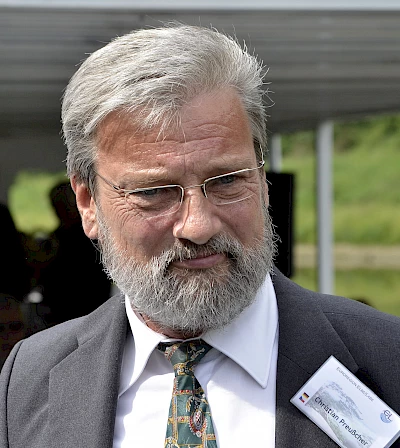 On Saturday, October 3rd, 2020, Christian Preußcher, long-time managing director of the Euroregion Elbe / Labe, died after a long illness.
On Saturday, October 3rd, 2020, Christian Preußcher, long-time managing director of the Euroregion Elbe / Labe, died after a long illness.
Christian Preußcher was a driving force behind the founding of the Elbe / Labe Euroregion and worked as its managing director on the German side from its founding in 1992 until he retired due to illness in 2014.
In this activity he has made an outstanding contribution to the development and intensification of diverse cross-border relationships between Saxony and the Czech Republic. On the other hand, as a convinced European, cooperation with other border regions and the growing together of Europe were important concerns to which he devoted himself wholeheartedly. It is fair to say that the Elbe / Labe Euroregion and probably also the Saxon-Czech relations would not be at the level they have achieved today without him.
We mourn the loss of this founding father of the Saxon-Czech euroregional cooperation and hereby express our condolences to his relatives.
The entire team of the Euroregion Elbe / Labe
September 2020
New joint website of the Europe Direct centers in the new federal states “ Reingeschlittert! 30 Years of East Germany in a United Europe ”with interviews, podcasts and interesting facts from the individual regions!
Do you know ... that Saxony has four Euroregions ? Euroregions are associations of districts and municipalities
at national internal and external borders. Four Euroregions have formed in Saxony: The Euroregions Neisse,
Elbe / Labe, Ore Mountains and Euregion Egrensis. The aim of these regional associations is the cross-border
To promote cooperation in the region in order to increase the competitiveness of the entire area.
Further information can be found in the press release
The Saxon Minister of Health Petra Köpping informed on Tuesday that Germans can stay in the Czech Republic for 48 hours without having to be in quarantine. Czech citizens are only allowed to stay in Germany for 24 hours without subsequent quarantine.
There are exceptions for commuters and direct neighbors
Commuters should be exempted from the quarantine requirement. Regular testing options continue to exist for them. In addition, people who live in the border region should continue to have neighborly encounters. In principle, Saxony wanted to treat the Czech Republic like a region in Germany in which such a difficult situation would arise.
Source: MDR Jump
On Wednesday, the whole of the Czech Republic, with the exception of the Ústí and Moravian-Silesian regions, was placed on the RKI's list of risk areas. These exceptions had caused some surprise, as they could not be justified by the development of infection rates alone. This is also shown by the current "traffic light" map of the Czech government (see map).
Now it is over: As Czech Foreign Minister Tomáš Petříček announced on Twitter, Germany will declare the entire Czech Republic a risk area today. This would have been decided at an extraordinary meeting of several federal ministries.
source: novinky.cz (in Czech)
More about the Corona rules in the Czech Republic and Saxony.
The Robert Koch Institute today declared the whole of the Czech Republic a risk area, with the exception of the Ústí and Moravian-Silesian regions. These exceptions are somewhat unexpected. It remains to be seen how long they will last.
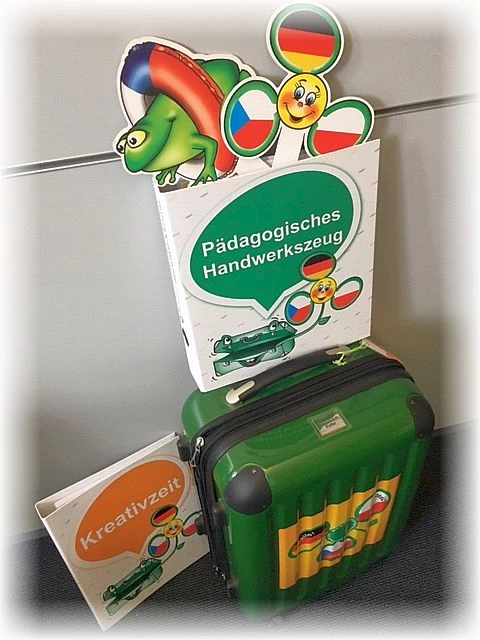
The Saxonian office for early neighbour-language education (LaNa) based in Görlitz has provided the offices of the Euroregions Egrensis, Erzgebirge / Krušnohoří, Elbe/Labe and Neisse-Nisa-Nysa with a neighbouring language kit for free lending. In the suit-case itself are among other things folders " pedagogical tools " in addition many suggestions, in order to discover the neighboring country with the children. With a variety of impulses, the pedagogical work in the day-care centers in the area of early neighborhood education in the border region can be improved.
If you are interested, please contact Mrs. Richter, telephone 0351 - 48 28 78 15 or by e-mail richter@elbelabe.eu.
Information on these play and learning materials can be found in the materials library at https://www.nachbarsprachen-sachsen.eu/de/materialpool.
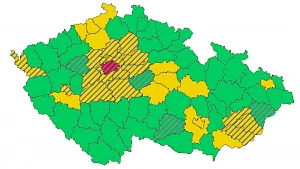 Due to the sharp rise in the number of infections and the resulting increasing difficulties in tracing infection chains, the Czech government also set all four districts in the Elbe/Labe Euroregion (Ústí, Děčín, Teplice and Litoměřice) to the second highest corona warning level on September 18th. According to the traffic light symbolism applied there, they therefore appear yellow.
Due to the sharp rise in the number of infections and the resulting increasing difficulties in tracing infection chains, the Czech government also set all four districts in the Elbe/Labe Euroregion (Ústí, Děčín, Teplice and Litoměřice) to the second highest corona warning level on September 18th. According to the traffic light symbolism applied there, they therefore appear yellow.
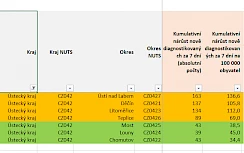 The number of new infections in the last 7 days, which is important for German decision makers, is also very high. In the district of Ústí it was 137 - calculated per 100,000 inhabitants. In Germany, the first measures are taken from 35 onwards, from 50 it's getting serious.
The number of new infections in the last 7 days, which is important for German decision makers, is also very high. In the district of Ústí it was 137 - calculated per 100,000 inhabitants. In Germany, the first measures are taken from 35 onwards, from 50 it's getting serious.
Due to these developments, it is expected that the whole of the Czech Republic will soon be declared a risk area by the Robert Koch Institute. Travellers from the Czech Republic would then have to be quarantined in Germany, including return travellers who have only been in the Czech Republic for a short time.
source: website of Czech Ministry of Health
More about the current corona rules in Saxony and the Czech Republic can be found here.
Despite the restrictions due to the COVID-19 situation, 150 Saxon and Czech young athletes and their coaches met in Bílina on Friday to test their athletic strength.
Due to the restrictions in force in the Czech Republic, this time the games took place only in three basic sports: Soccer - boys, Volleyball - girls, and Athletics for mixed teams. In each sport there were four teams in traditional colors, LABE team in blue, ELBE team in green, KRUŠNOHOŘÍ in red, and team ERZGEBIRGE in yellow.
The athletes were welcomed by the captain of the Ústí Oldřich district Bubeníček and the mayor of Bílina, Mrs. Zuzana Schwarz Bařtipánová, as well as Mr. Lipský, managing director Euroregion Labe.
In ideal weather, the individual competitions began at 11 a.m. in the stadiums FK Bílina, AK Bílina and in the Green Hall in Tyršová Street.
The athletics finished their competitions (60 m, distance, ball, 4x60 relay, 800 m and 4x800 m relay) first. After that, the soccer tournament ended. In our experience, the competitions in volleyball lasted the longest.
Results: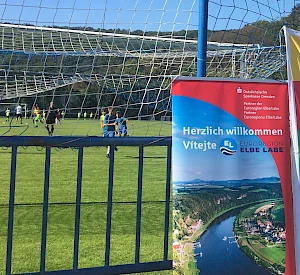
Soccer
- Erzgebirge
- Labe
- Krušnohoří
- Elbe
Athletics
- Erzgebirge
- Krušnohoří
- Labe
- Elbe
Volleyball
- Krušnohoří
- Labe
- Elbe
- Erzgebirge
The overall victory was won by the Euroregion Erzgebirge/Krušnohoří.
On September 11th, 2020, the binational local steering committee of the Euroregion Elbe / Labe gave the green light for German-Czech projects in the border area in the branch office of the Environmental Center Dresden eV. Four projects are financially supported with EU funding of around EUR 35,600.
You can find more detailed information on the approved projects here .
Yesterday the Robert Koch Institute classified the Prague city area as a risk area for corona infections. This means that persons who have been there in the last 14 days are generally obliged to remain in domestic quarantine for 14 days when entering Germany. This can be avoided by a fresh, negative corona test.
You can find more information on the regulations when entering Germany from risk areas here (in German or Czech only).
In the period from September to December 2020, the Aktion Zivilcourage eV organizes a series of online seminars as part of the voluntary training forum, which offer practical impulses on current and relevant educational topics around the topic of volunteering.
The seminars usually start at 6 p.m. and take place online via Zoom. You can take part in the seminar quickly and easily from anywhere and do not have to drive to the venue, which saves time and effort. All you need is a PC, tablet or smartphone.
Topics of the online seminars
- Introduction to association law - founding an association, tasks, rights and obligations of the association's board
- Introduction of finances in the club - accounting obligations and taxes in the club
- Project management - effectively organizing board meetings and discussions, formulation of goals and indicators, methods for seminars and workshops
- Human resource management
- Time management
- Recruiting - Methods and strategies for small and medium-sized clubs
- Donations, corporate volunteering and sponsoring - cooperate with companies
- Crowdfunding - from the idea to the campaign
- Online seminars for a better understanding of MS Office applications (Word, Excel, PowerPoint)
- Design of online seminars: focus on video moderation, tools and programs for working with groups
- Design of presentations for lectures and online seminars.
You can find an up-to- date overview of all online seminars and events, which are continuously updated, on the website: www.weiterbildung-ehrenamt.de .
Registration will be by e-mail: weiterbildungsforum-ehrenamt@aktion-zivilcourage.de or by calling 03501 460,882th
Source: Aktion Zivilcourage e. V., Lange Straße 43, 01796 Pirna, email: post@aktion-zivilcourage.de
"If you live in Dresden, Bohemia is practically on your doorstep. Ústí nad Labem and Teplice are closer than Chemnitz, Liberec is hardly further than Görlitz and Leipzig, Prague much closer than Berlin. And from the town of Wehlen it is just a few steps away. In spring 2017 I travelled for longer and several times in South and West Bohemia, in autumn 2018 I made two trips through the northern and eastern regions and another two days in Prague. Bohemia is mainly a region of small towns," says photographer Peter R. Fischer, who has been working in Dresden since 2008.
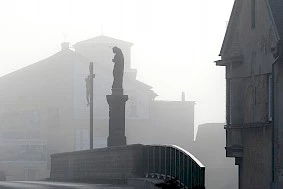 His photographs, he continues, "mostly come from smaller towns, small and occasionally large cities, rarely from landscapes. "Historical, important" motifs are not left out, but the focus here is on the search for one's own or new perspectives, the detection of unexpected connections. Apart from that, my eye is strongly devoted to the details that more or less tell how people deal with history, what has what value in the present, what an eye or no eye is there for, what is more vital or not".
His photographs, he continues, "mostly come from smaller towns, small and occasionally large cities, rarely from landscapes. "Historical, important" motifs are not left out, but the focus here is on the search for one's own or new perspectives, the detection of unexpected connections. Apart from that, my eye is strongly devoted to the details that more or less tell how people deal with history, what has what value in the present, what an eye or no eye is there for, what is more vital or not".
The exhibition is supported by the Euroregion Elbe/Labe.
August 2020
The Saxon Switzerland National Park Center invites you to an expert discussion on Saxon-Bohemian Switzerland "The Elbe - common natural heritage" on Thursday, September 10, 2020, 9:00 am to 3:30 pm. The event takes place in the National Park Center Saxon Switzerland in Bad Schandau. The free event, including moderation and discussion, will be fully interpreted simultaneously.
Registration until September 3rd, 2020
Invitation and program for download as well as information on the website of the organizer
Source: organizer
July 2020
The Saxon mountaineering choir "Kurt Schlosser" Dresden will give a guest performance on Sunday, August 16, 2020 in the Grosssedlitz Baroque Garden . From 5 p.m. the most beautiful mountain and folk songs from the ensemble's diverse repertoire will be heard under the baton of choir director Axel Langmann and conductor Christian Garbosnik. The program includes the legendary song of the mountains "La Montanara".
The organizer is the Elbe / Labe Euroregion. 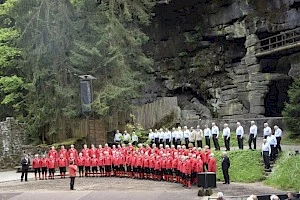
Tickets are available at the box office for 20 and 15 euros *. As Gabriele Löwe from the Baroque garden reports, there are enough chairs available. You are also welcome to bring blankets for extended seating.
* Only cash payments possible. The discount applies to pensioners, schoolchildren, apprentices, students, holders of the Dresden Pass or the volunteer pass, as well as people in the federal voluntary service or FSJ.
Photo: Manfred Döbler
The next submission deadline is July 24th. The application (by post and online), including a cost and financing plan with various attachments, must be submitted to the municipal association Euroregion OE / OE eV in Dresden with a meaningful project description with legally binding signatures from both cooperation partners.
 Further information can be found on our homepage under Funding / Small Project Fund.
Further information can be found on our homepage under Funding / Small Project Fund.
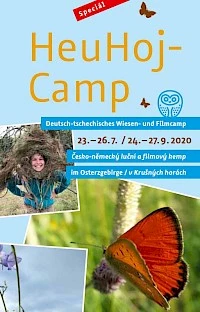 Green League Osterzgebirge e. V. and the Czech association Lužický horský spolek are organizing a German-Czech camp in the Eastern Ore Mountains in late July and late September.
Green League Osterzgebirge e. V. and the Czech association Lužický horský spolek are organizing a German-Czech camp in the Eastern Ore Mountains in late July and late September.
Registrations for the end of September are still possible.
The camp is open to adults and young people from the age of 17 who have fun in nature and in German-Czech encounters. Language skills are not a prerequisite for participation: hands, feet, openness and language mediators will ensure communication!
Registration using the online registration form at www.heuhoj.de or by email at heuhoj@gmail.com. More information on the website and on facebook.com/heuhoj .
Source: organizer
June 2020
On Friday, 19th of June, 2020, the Local Steering Committee of the Small Projects Fund in the Euroregion Elbe/Labe met in Ústí nad Labem. After the meeting in March had to be cancelled due to Corona, we were very glad to meet again in person.
The committee had six project applications with a total volume of 70,986.68 Euro for decision, three each from German and Czech side. These were all unanimously approved.
More detailed information on the approved projects can be found here.
From the press release of the German-Czech Future Fund:
The competition for the German-Czech Journalism Prize 2020 is open. Applications can be submitted until 30.6.2020.
In its fifth year, the German-Czech Future Fund, together with the journalist associations of both countries (DJV and Syndikát novinářů), is again awarding a total of eight prizes for outstanding journalists whose work arouses interest in the neighbouring country and contributes to a better understanding between Germans and Czechs through their differentiated and cliché-conscious reporting.
"The mutual perception is also currently strongly dominated by the Corona crisis, which unfortunately is also rekindling prejudices that were thought to have already been overcome, and is directing the focus of many media primarily towards Germany. This makes it all the more topical and urgent for us to offer this prize, which we would like to use to support journalists working across borders with an unbiased view," say Petra Ernstberger and Tomáš Jelínek, the managing directors of the German-Czech Future Fund.
Prizes will be awarded to the best German and Czech-language contributions of the past 12 months in the categories text, audio and multimedia (including TV). In addition, the special prize "Milena Jesenská" is awarded to a German or Czech contribution that focuses on the topics of moral courage, multicultural understanding and tolerance in a special way and with a contemporary relevance. With the special award for long-term outstanding journalistic activity, the organizers honor journalists or journalistic formats that have rendered outstanding services to more differentiated reporting on the neighboring country over a longer period of time.
The prize is endowed with 2000 Euros each, while the special award for long-term activity is an honorary award without prize money.
Contributions can be submitted by the authors themselves, or proposed by editorial offices or third parties. This year, for the first time, two entries per author and category may be submitted to the competition. A nomination by a third party is required for the special award.
The call for entries and the conditions of participation as well as further information on the award are available online at: www.deutsch-tschechischer-journalistenpreis.de.
A short video review of the last year can be found here: https://youtu.be/b6marzhVjq4.
Contact:
Silja Schultheis
Mail: silja.schultheis@fb.cz
GSM: +420 737 505 790
www.zukunftsfonds.cz
www.deutsch-tschechischer-journalistenpreis.de
"Our neighbors among us: How multilingual growing in Kita-day life can be supported?" - with this motto all interested parties to Saxon-Czech specialists and practice day as part of the are Czech-German Culture Days invited to Dresden. 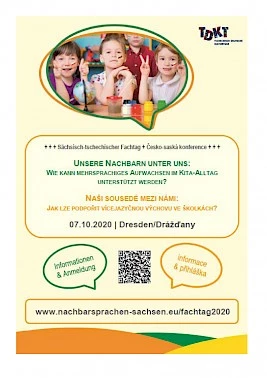
when: 07.10.2020, 10 a.m. - 4 p.m.
where: Saxon State Center for Political Education , Schützenhofstrasse 36, 01129 Dresden
Participants: Saxon, Czech and Polish actors from the field of pre-school education, in particular:
- Daycare professionals and daycare providers
- German / Czech / Polish native speakers who work in daycare centers in the respective neighboring country
as well as everyone interested in the topic.
Conference languages: German, Czech
You can find detailed information, the conference program and the option to register online at www.nachbarsprach-sachsen.eu/fachag2020 .
Source: Saxon State Office for Early Neighbor Language Education, Bahnhofstrasse 24, 02826 Görlitz
The Czech government decided this morning that the Czech borders with neighboring countries would be open again from noon. Entry and exit are possible without restrictions.
During a visit to the Karlovy Vary Region, Czech Prime Minister Andrej Babiš announced today, according to idnes.cz, that the government will hold an extraordinary meeting tomorrow morning at 7 a.m. to decide on the full opening of the borders with all neighbouring states. This should be effective from midnight, if it was up to him.
(source: idnes.cz)
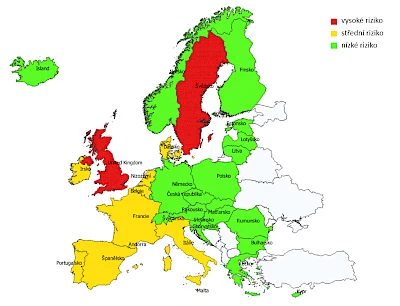 The Czech government installed today a system for classifying countries according to Corona risk, starting from June 15th. Safe countries are given the color green. Czech citizens can travel to and return from these countries without restrictions. It will also be possible to travel to the Czech Republic from these countries without restrictions.
The Czech government installed today a system for classifying countries according to Corona risk, starting from June 15th. Safe countries are given the color green. Czech citizens can travel to and return from these countries without restrictions. It will also be possible to travel to the Czech Republic from these countries without restrictions.
How lucky: Germany is green!
Countries marked in orange are a less safe, so foreigners still need a negative corona test to enter the Czech Republic from there. Traveling back from the countries marked in red, even Czechs will need a negative Corona test
(source: novinky.cz)
May 2020
Tomorrow once again some meetings along the Czech-German (and Polish) border will take placing, showing the strong desire for a real opening of the border. 12 locations are planned along the Saxon-Czech border (see map below). The Euroregion Elbe / Labe will be present at the Eulentor near Rosenthal. This time there will be a colloquium with lectures on rather different topics.
The Czech government decided today that from tomorrow, May 26th, there will be no continuous border controls at the borders with Germany and Austria, only random checks. However, the general restrictions for entering Czechia remain, i.e. the requirement for a negative corona test and a good reason to travel (you can find more information here).
There are also some Eurocity trains running between Berlin and Prague. The traffic will be expanded in June. The Nationalparkbahn/U28 does not yet run cross-border again.
(Source: landesecho.cz)
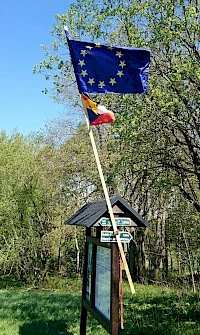 Everywhere along the Czech external border, people from the Czech Republic and neighbouring countries met yesterday - as they did two weeks ago - at the closed borders to demand it's opening. There were particularly many meetings on the German-Czech border. A map of all meetings can be found at www.hej-nachbar.de. A press release was published as well,
Everywhere along the Czech external border, people from the Czech Republic and neighbouring countries met yesterday - as they did two weeks ago - at the closed borders to demand it's opening. There were particularly many meetings on the German-Czech border. A map of all meetings can be found at www.hej-nachbar.de. A press release was published as well,
In the Euroregion Elbe/Labe the meeting took place between Špičák and Oelsen. This time about 120 people joined in. There was singing, talking, eating, drinking, sunbathing... The police on the Czech side was present, but did not intervene.
Both Saxon and Czech television were present this time:
Report in MDR Sachsenspiegel (DE)
Report in CNN Prima (CS, minute 25:00)
Further press reports:
Ústecký deník (CS)
Just like two weeks ago, people from the Czech Republic and Germany are meeting again this Saturday at the common border to send a signal about how much they miss the meeting with people from the neighbouring country and to call for an early opening of the borders.
In our region they will meet at the following two places:
- on the meadow between Oelsen and Krásný les below Špičák mountain, where the Euroregion will also be present,
Map - as well as on the meadow at the Žebrácký roh between Holzhau and Moldava.
Map
This is not a general demonstration against corona containment measures. All safety rules will be observed.
Next year the new funding period is to begin, also in the INTERREG area. For this purpose, the cooperation programme Saxony-Czech Republic is currently being developed.
In order to ensure that the funding priorities are not determined without taking into account the needs, we are interested in the feedback of potential project sponsors on which topics they could imagine projects, which is why a general survey is being conducted.
If you are interested in cross-border cooperation, think about project ideas or develop cross-border projects and want to carry them out with partners in the Czech Republic or Saxony, you can make an important contribution to the preparation of the programme with your information.
The German language version of the online survey can be found in the participation portal of the Saxon State Government under the following link:
https://buergerbeteiligung.sachsen.de/portal/sn-cz2020de/beteiligung/aktuelle-themen/1019849.
Before you start, one more technical note: On the start page of the survey, click on the link (top left) "to the questionnaire" to go to your own survey.
The survey starts on 11 May 2020 and will be active until June 5th, 2020.
From Monday, 11 May, it will be possible for all groups of people to cross the Saxon-Czech border at crossings which are currently only open to commuters and road freight traffic from 5 am to 11 pm.
At the same time, three more border crossings will be opened: Dolní Poustevna, Hřensko and Kraslice.
Source: https://www.mvcr.cz/clanek/od-11-kvetna-bude-vice-moznosti-kde-prekrocit-hranice.aspx
The mayor of Dolní Poustevna, Robert Holec, addressed a petition to the Czech government to open the Dolní Poustevna - Sebnitz border crossing for commuters. The petition demands a reasonable possibility to travel to work. Representatives of towns on the Czech and German sides of the Elbe/Labe Euroregion also demand that the border crossing be opened.
"The risk of the border closure being relaxed is not great compared to the impact on the lives of people who have to travel 150 km a day, because it is the same group of people who are affected by this concern and need, and the latter I have classified as more serious," said the mayor.
Since mid-March, the German-Czech border has only been passable in a few exceptional cases. This closing of the border has been criticized from various sides. Yesterday people from both countries met at six different places to send a signal that the border should be reopened as soon as possible. In the Euroregion Elbe/Labe, the meetings took place in Ostrov near Tisá and in Zinnwald/Cínovec. Some border crossings are said to have happened, without any intervention by the state.
Facebook-Group (with photos and discussion in DE/CS)
Just right for Labour Day in Corona times: As of June 30, 2019, 11,129 Czech citizens were employed in Saxony subject to social security contributions. In addition, there were 986 marginally employed persons who are not included in the following evaluations.
Most of these employees, namely 9,134, are cross-border commuters, i.e. they lived in the Czech Republic. This share of 82% commuters is much higher than, for example, for Polish employees in Saxony (53%).
If you look at the sectors, it is not - as one might expect - the hotel and restaurant industry or the health care sector that are in first place, but the manufacturing industry, which employs almost a quarter of the Czech workforce.
In Euroregion Elbe/Labe, 3,307 Czech citizens worked on the German side, of which 2,629 are cross-border commuters. In addition, 350 Czech* nationals were marginally employed here.
In the whole of Germany, approx. 35,700 cross-border commuters from the Czech Republic are employed (in Bavaria there are probably more than 25,000). This shows the extent of the effects of the current border closures.
More interesting information (also on Polish employees in Saxony) can be found in the DGB's short info of 28.04.2020 (PDF, German only).
April 2020
On Tuesday afternoon some forest was on fire in Zinnwald, about 350m from the border on Czech territory. Since the fire was not accessible from the German side, German fire brigades were permitted to attack from Czech territory, helping the Czech fire fighters.
The fire brigades of Altenberg, Zinnwald, Duchov, Teplice and Dubi then worked successfully together. The fire was extinguished in the evening.
The cross-border cooperation of the fire brigades (and the control centres) worked well here. Altenberg's mayor Thomas Kirsten also see a joint exercise last autumn as a reason for that.
We are very glad that the many years of efforts to improve cooperation between Saxon and Czech fire brigades have borne fruit here.
Source: Sächsische Zeitung (online, 29.04.2020) (unfortunately only in German and behind paywall)
Interessanting video about that (sorry, just on Facebook): https://www.facebook.com/hzsulk/videos/273606083802160/
Saxony to the Czech Republic (and back)
From April 27th, 2020, EU citizens can enter the Czech Republic under the following conditions:
- for the purpose of economic activity (with evidence),
- maximum 72 hours stay in the Czech Republic,
- upon presentation of a negative corona test that is a maximum of four days old.
The same applies to EU students in the Czech Republic.
Furthermore, various exception rules apply for employees in critical infrastructure and in the transport industry, for cross-border commuters and if there are valid reasons.
You can find the exact rules and all necessary bureaucratic stepshere .
The background to the relaxation was a court ruling that forced the Czech government to make changes.
Czech Republic to Saxony (and back)
Czech citizens (and foreigners with a residence permit) are allowed to leave the Czech Republic without hindrance. To return without a quarantine requirement, you also need a negative Cotona test.
However, entry into Saxony is restricted. Anyone entering Saxony from the Czech Republic must be in quarantine for 14 days. Exceptions are initially:
- Employees in the transport industry,
- Employees in critical infrastructures,
- regular cross-border commuters,
- Employees for at least 3 weeks in German companies (with appropriate measures),
- People with particularly important reasons for travel.
But everyone else can also enter Saxony without quarantine if they have not been abroad for more than 48 hours .
The trade unions in the border triangle of Saxony, the Czech Republic and Poland today published a joint declaration on the situation in the border region:
"We call on the governments of Germany, Poland and the Czech Republic to immediately restore freedom of movement on the cross-border labour market in the border triangle for all cross-border workers. Border closures are not an instrument to combat corona, but an acute threat to jobs and livelihoods of cross-border workers," said Markus Schlimbach, Chairman of the DGB District Saxony.
The trade unions note with annoyance that European cohesion is currently falling by the wayside. Those who suffer most are the employees in the common cross-border labour market. In the Free State of Saxony there are more than 11,000 employees from the Czech Republic and about 20,000 from Poland who are subject to social security contributions. Among them are more than 9,000 cross-border commuters from the Czech Republic and more than 10,000 from Poland.
Due to the quarantine regulations in the Czech Republic and Poland, it is hardly possible for them to come to Germany to work. The countries are violating the right to free movement. The border crossers are threatened with dismissals!
The IGR Elbe-Neisse was founded in 1993 and works for a social and fair development of the border region. It consists of the DGB District Saxony, the regional divisions of the Bohemian-Moravian Confederation of Trade Union Associations (ČMKOS), the Polish OPZZ and the NSZZ "Solidarność".
Translated with www.DeepL.com/Translator (free version)
On April 6th, the Local Steering Committee decided (this time by circulation procedure due to the Corona crisis) to support 14 projects from the Small Projects Fund in the Elbe/Labe Euroregion. Of these, 8 projects from the Czech Republic and 6 from Saxony had been applied for, and no project was supported.
It is unclear for many project sponsors whether they will be able to carry out their activities as planned. In each individual case, the Euroregion tries to find solutions to ensure funding.
More information on the individual projects can be found here (in German only).
The German-Czech Lawyer's Association has published a sharp criticism of the closing of the border between the Czech Republic and Germany on their website (in German only). We from the Euroregion Elbe/Labe are also quite unhappy with the current situation.
Here the Announcement of the German-Czech Future Fund :
Dear friends of the German-Czech Future Fund,
spring is here and shows itself from its best side beyond the closed borders - as if to remind us that even in times of crisis we can rely on beautiful things :-)
Reliability is essential in these weeks of uncertainty. Because if the current crisis reminds us of one thing every day, it is that it cannot be tackled alone. What is needed is cooperation and cohesion from all of us, in politics as well as in civil society.
In the Future Fund, we asked ourselves where our help is now most urgently needed and how we can quickly and unbureaucratically help those who have been hit hardest by the pandemic in the German-Czech community. We are providing them with special funding totaling 373,000 euros.
We dedicate part of this to organizations that take care of the surviving Nazi victims in the Czech Republic, who play a key role in building trusting relationships between Germans and Czechs. Because of their age and the agony they suffered, they are most at risk from the pandemic and now require special protection.
We provide further support to the often freelance bridge builders who have made a significant contribution to improving German-Czech relations in recent years and who are now feeling the economic effects of the crisis. We have advertised a special funding program for bridge builders for them.
And finally, we would now like to help those who provide social and medical help in the German-Czech border region - in a region where a lot of trust has been built between the citizens of our two countries over the past 30 years, and that is not being jeopardized may due to the social and structural effects of the crisis, which could be particularly noticeable here.
If you know of organizations in the German-Czech border area that offer help for particularly vulnerable people and could use financial support, please let us know and please enter your information directly into the form of our special funding program for the border regions .
We are confident that together we will be able to offer reliable support to those who need it most now.
You too can stay confident - and healthy!
Your German-Czech Future Fund
1. General
The simplifications mentioned below do not represent a change in the existing legal framework for the implementation of cooperation projects. They are only intended to limit the negative effects of the COVID-19 crisis on program implementation.
If you want to take advantage of one of the aforementioned facilitations, you must credibly explain the connection between the current situation of your project and the corona crisis. On the basis of documents, you must be able to prove that you were unable to influence the costs incurred and that you took all due care to avoid or at least minimize the costs. You submit the documentation to the supervisory authority (SAB or CRR) together with the settlement of the expenses. When assessing the facts, the success of the project as a whole is primarily assessed. This includes the implementation of the activities, the achievement of the project goals and project results.
Even under the more difficult conditions, the regulations of the grant agreement, the joint implementation document including award regulations and the relevant regulations of the European Union continue to apply.
2 Funding of expenses for project activities
- Did you incur financial expenses for activities for your project that could not or only partially be carried out due to the COVID-19 crisis (e.g. room rental despite a canceled event, travel expenses, no reimbursement of participation fees already paid by the Organizer, cancellation fees), these expenses can be subsidized.
- If you are reimbursed or compensated for the costs incurred by another body (e.g. from insurance, short-time working allowance, etc.), this must be reported to the SAB / CRR. In this case, the eligible expenses will be reduced by the amount paid by third parties.
- Expenses that may arise in connection with the implementation of project activities in an alternative format (e.g. virtual meetings, e-learning and the like) must make a decisive contribution to the project objectives. They must be adequately documented and justified.
- Expenses for products or services that were planned for a project activity but can now be used at a different time or for another activity outside the project due to the COVID-19 crisis are not subsidized. This applies, for example, to items of equipment, gifts or prizes for competitions that were purchased by the beneficiary and are now used for another purpose.
3 Implementation of project activities
- Changes to the overall project are to be reported to SAB by the LP before the end of the project term.
- About changes that do not have any significant impact on the achievement of the project goals (e.g. postponement of events, change of the format of an event, such as "online" instead of "on site", extension of the project duration in order to catch up on activities ) the SAB decides.
- About major changes, such as B. the change of the expenditure and financing plan or the change of the project activities, which significantly impair the achievement of the project goals, is decided by the monitoring committee.
- Project activities that could not be implemented but are necessary to achieve the project objective must be made up for or replaced in consultation with the SAB.
- At this point it is expressly pointed out that the regulations of the procurement law according to the grant agreement as well as the joint implementation document - if they are to be applied - must be observed for the changed project activities.
4 deadlines at the supervisory authority
- Inform your supervisory authority (SAB or CRR) if you cannot meet deadlines. New appointments will be arranged with you unbureaucratically.
- If you urgently need a withdrawal, report it to your supervisory authority. Your current statement will be rescheduled or you will be asked to submit an additional payment request.
5 small project funds
For the beneficiaries of small projects, the regulations in paragraphs 1 to 4 apply analogously, whereby the notifications and information mentioned therein must be submitted to the respective responsible Euroregion. If you have any further questions, we recommend that you contact the relevant project secretariat in your Euroregion.
© Sächsische Aufbaubank - Förderbank -. All rights reserved. 04/09/2020
March 2020
If projects cannot be carried out as planned due to the Corona crisis, the following regulations apply:
Costs for the cancellation of external orders due to the Corona problem are eligible costs. They can be listed in the billing list.
If events are postponed to another point in time that is no longer in the original project period, an amendment agreement will be made to the grant agreement in order to extend the project period.
If planned events are held at a different time and exceed the approved budget due to cancellation costs, the local steering committee will propose a resolution to increase the funding amount (which will certainly also be approved). However, this is only possible if the maximum amount of 15,000 euros has not yet been exhausted.
You can of course contact us at any time if you have specific questions in connection with a project. It is best to write an email , we mostly work from home.
The Coordination Centre German-Czech Youth Exchange - Tandem Pilsen is looking for a volunteer with residence in Germany for a stay of 12 months (1 September 2020 to 31 August 2021) for the project ahoj.info.
At the same time Tandem Regensburg is looking for two volunteers with residence in the Czech Republic for the project. The volunteer service is carried out within the framework of the European Solidarity Corps (formerly Erasmus+ / European Voluntary Service).
The Elbe / Labe Euroregion has been promoting cross-border cooperation between Saxony and the Czech Republic for almost 28 years. This is implemented by a large number of active members in associations, municipalities and other institutions.
All interested parties who would like to find out more about the possible support of the Euroregion Elbe / Labe for cross-border projects, who are looking for individual advice on contact placement and financial support, are cordially invited to an information event in Dippoldiswalde. When?
On Wednesday, March 25th, 2020, at 6 p.m., in the Dippoldiswalde Park Halls (Small Hall), Dr.-Friedrichs-Straße 25, 01744 Dippoldiswalde.
During the event, other options for supporting cross-border projects with the Czech Republic will be discussed and your questions will be answered.
In order to better plan the event, please register with Ms. Viera Richter by March 19, 2020 at richter@elbelabe.eu or 0351-48287815.
February 2020
A young woman wanders through the family jungle and haunts the end of a relationship, constantly trying to escape the torrent of everyday life. She moves from the Czech Republic to Germany and travels to London, where she plunges into the nightlife. She fantasizes about a bank job and looks for a job as a coach driver. We read of bursts and outbursts of toxic loves and strange therapy sessions. Desperate by her unsuccessful attempts to integrate, she finally makes a radical decision: She moves into a wardrobe. Sensitive and with a lot of humor, Tereza Semotamová tells of the absurd search for your own path in a world in which nobody knows exactly where to go.
 Tereza Semotamová (* 1983 in Boskovice) is a prose writer, publicist and translator. She studied screenwriting and dramaturgy at the Janáček Academy for Music and Performing Arts, German studies at Masaryk University in Brno and completed her doctorate with a dissertation on German radio plays from the 1950s. She writes radio plays, features and columns, translates German-language literature into Czech, teaches and works for the German-Czech platform já-du.
Tereza Semotamová (* 1983 in Boskovice) is a prose writer, publicist and translator. She studied screenwriting and dramaturgy at the Janáček Academy for Music and Performing Arts, German studies at Masaryk University in Brno and completed her doctorate with a dissertation on German radio plays from the 1950s. She writes radio plays, features and columns, translates German-language literature into Czech, teaches and works for the German-Czech platform já-du.
Photo: Richard Klíčník
The reading will take place on April 21st at 7.30 p.m. in the Dresden Central Library (in the Kulturpalast, Schlossstrasse 2). Admission is free.
A cooperation between the Euroregion Elbe / Labe, Dresden City Libraries, the Czech Literature Center and the Czech Center Berlin. Under the auspices of the Consul General of the Czech Republic in Dresden, JUDr. Markéta Meissnerová.
An important item on the agenda was the status of the preparation of the new funding program in the area of cross-border cooperation. A joint working group was set up for this purpose, made up of the chairmen of the two Euroregions, their representatives and their managing directors. For the Ústecký kraj region, representatives from the regional development department will be there.
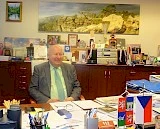 The new managing director of the Euroregion Krušnohoří, Ing.Petra Konečná, introduced herself at the meeting. She is the successor to František Bína. Captain Oldřich Bubeníček thanked him for his many years of work and presented him with the captain's medal with a memorial letter.
The new managing director of the Euroregion Krušnohoří, Ing.Petra Konečná, introduced herself at the meeting. She is the successor to František Bína. Captain Oldřich Bubeníček thanked him for his many years of work and presented him with the captain's medal with a memorial letter.
Read the press release from the Ústí district administration.
The European Solidarity Corps enables a new (that means second) volunteer position at the cultural centre Řehlovice in the Czech Republic. This volunteer position is available for six months from 01.03. to 31.10.
Experience an exciting summer full of art, culture, politics and society on the farm. During your time at the cultural centre, you will be part of various projects, experience international encounters and help to organise them. We are looking for help with public relations, planning and implementation of the projects, practical activities on the farm and creative input and expression.
We support accommodation, travel costs, seminars, food etc. and you will receive some pocket money.
Application to: andre.schmahl@posteo.cz
Questions can also be sent via Instagram @kulturdaca
January 2020
Application deadline: February 28, 2020
Further information (please save forms before filling in):
Applications by post and as PDF by email to:
Dr. Astrid Winter
Institute for Slavic Studies
All students who are regularly enrolled at a German university can apply. If you are paying yourself, please contact the respective summer school directly.
Would you like to learn more about cross-border cooperation?
Do you speak German, Czech and possibly also English?
Are you communicative and open for new experiences?
A volunteer position for six months is available now.
Your tasks:
- Support with the organisation of the annual event
- Publication of news, objectives and achievements of cross-border projects
The position is advertised in cooperation with the Interreg Volunteer Youth initiative for young Europeans aged 18-30. The coordinating organisation AEBR offers you a financial support of 28 € per day and helps you with travel expenses and insurance.
Applications to kontakt@sn-cz2020.eu.
More information about the IVY initiative can be found under this link: https://www.interregyouth.com/.
Source: SAB
The Collegium Bohemicum in Ústí nad Labem is looking for a new cultural manager. One of the main tasks would be the organization of the Czech-German cultural days on the Czech side.
You can find more information on the website of the Collegium Bohemicum .
Applications for the funding of German-Czech small projects from the small project fund of the Euroregion can be submitted until January 31st. The next submission deadline is May 1st, 2020. You can find all dates here .
European Academy Berlin: This year again, 14 young professionals will meet selected experts in a series of workshops in order to receive practical recommendations, ideas and suggestions for their future careers.
This year's theme ties in with the current challenges and approaches that arise from climate change for our society, for the economy and for politics. The following three workshops will take place under the focus on " Sustainable Business & Lifestyle - Czech and German Answers ":
- from March 12th to 15th, 2020 in Berlin,
- from June 18 to 21 in Prague as well
- from September 24th to 27th in a German and a Czech town in the border region
Young professionals from Germany or the Czech Republic who want to network across borders and professions and who want to deal with current political and social issues can apply by January 31, 2020.
Application requirements are at least three years of professional experience and very good knowledge of the English language.
The advertisement can be found in the attachment and here .
The project is funded by the German-Czech Future Fund.
1 / 241

